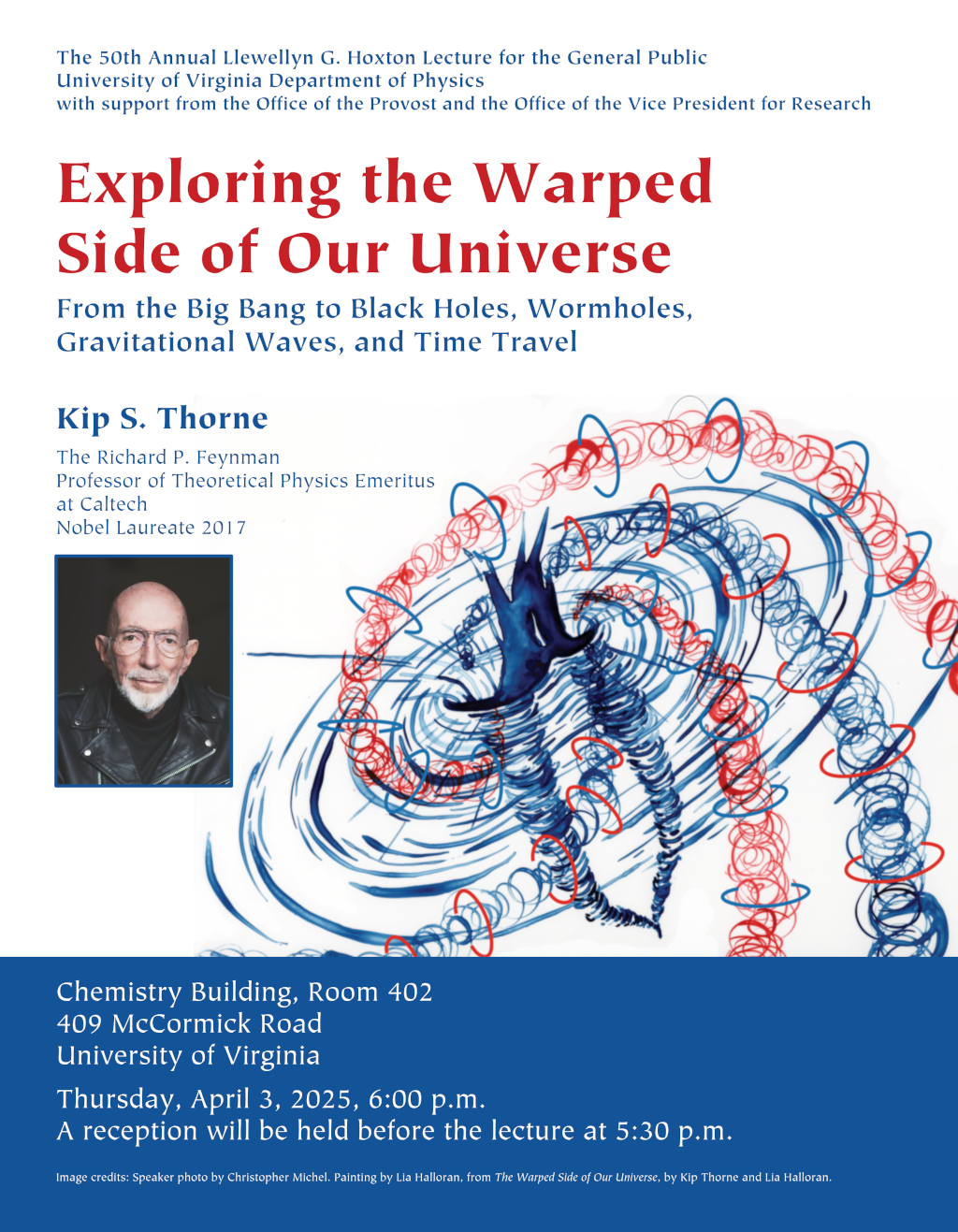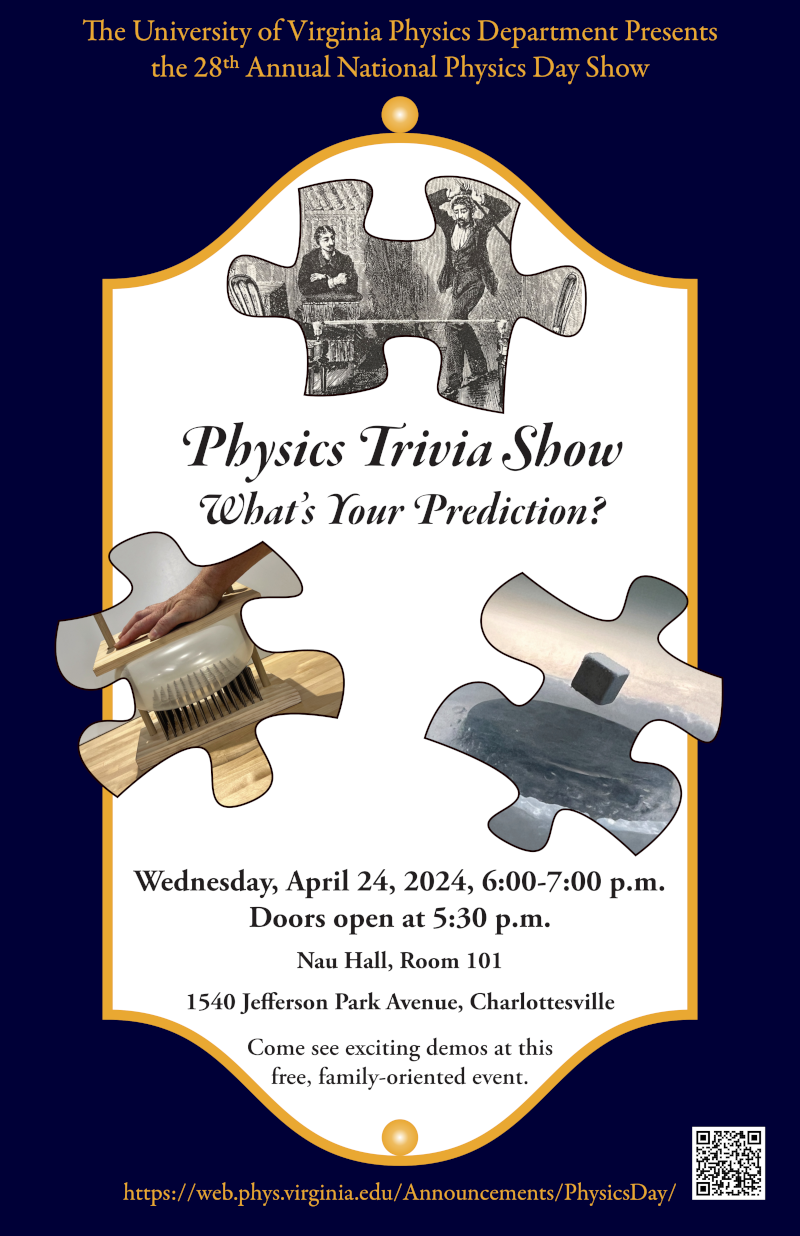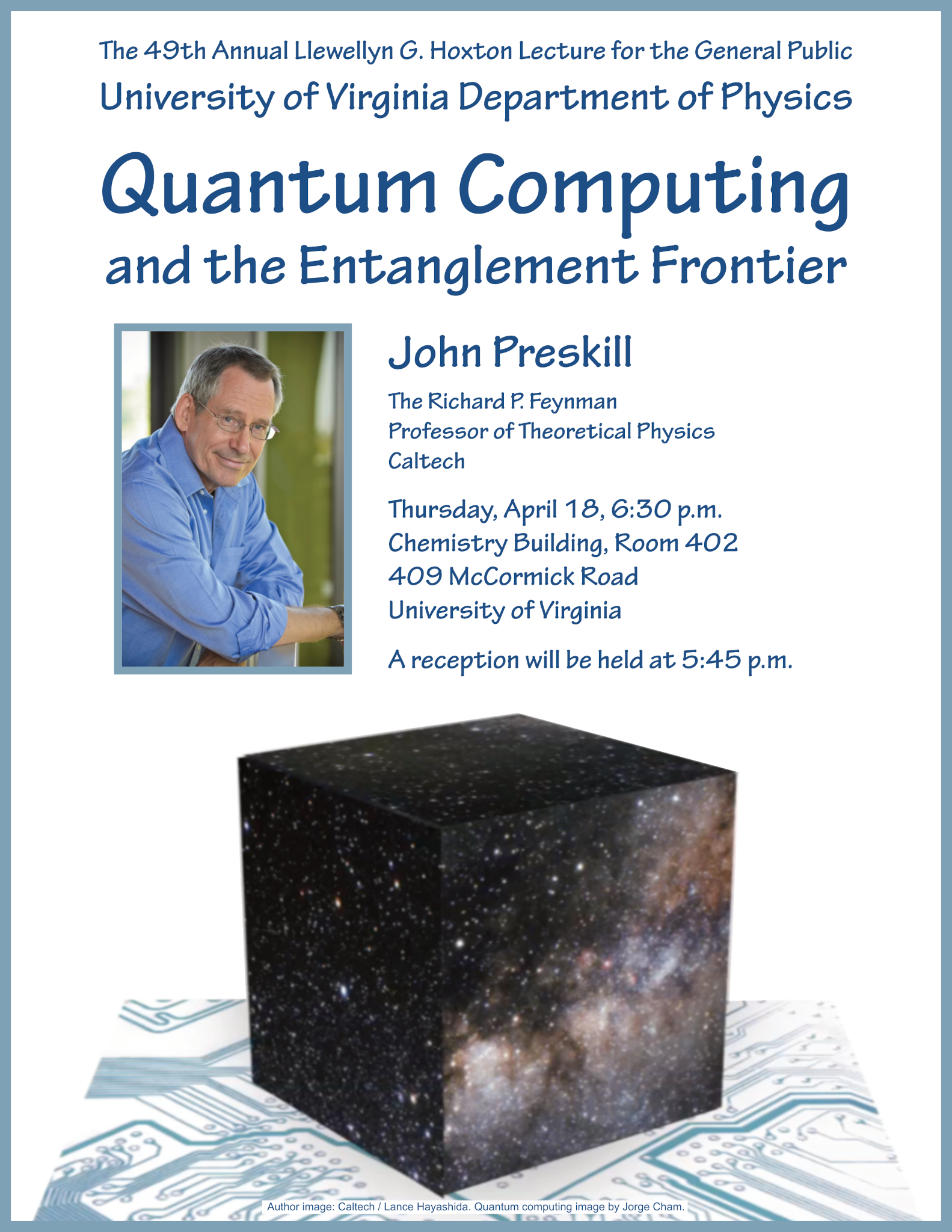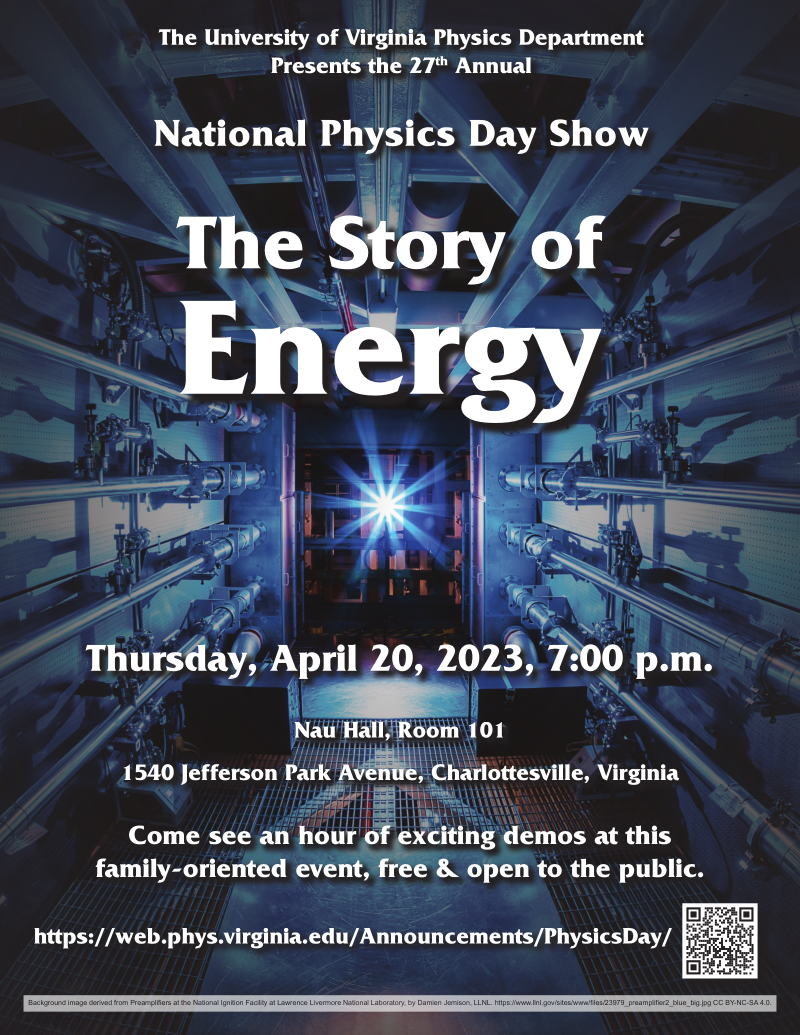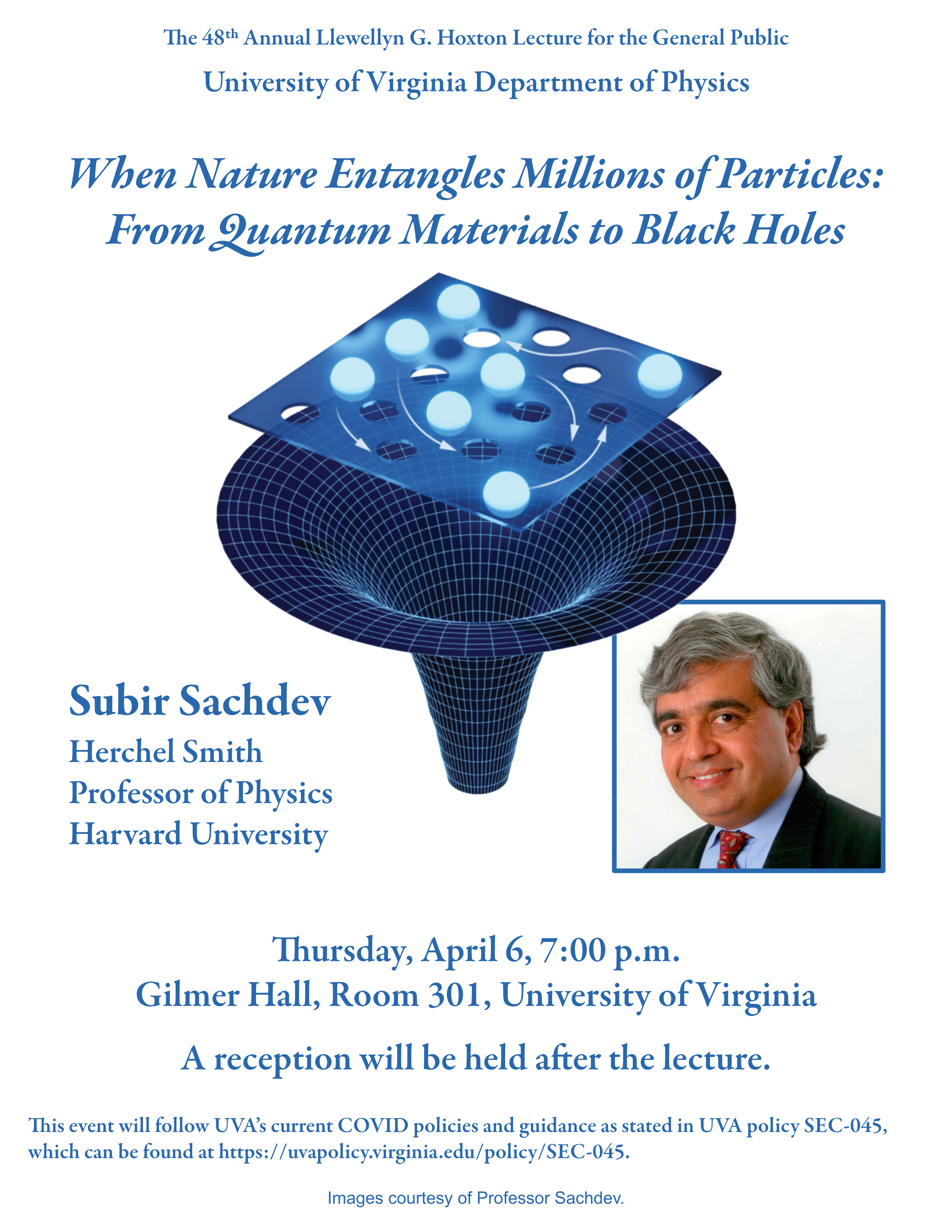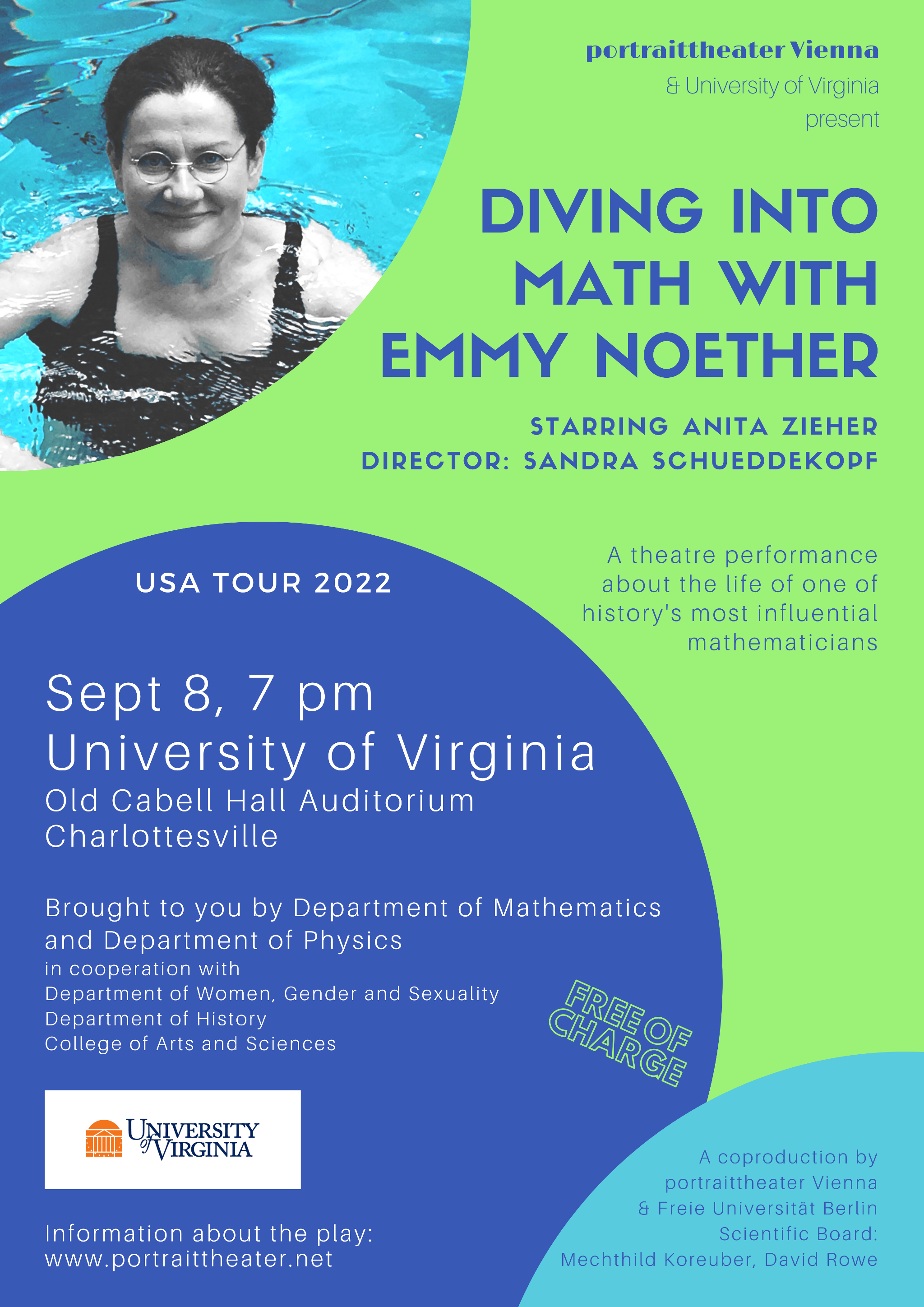UVa Physics News
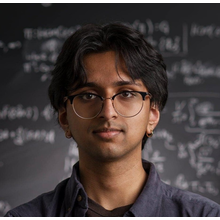
Ishaan Patel Awarded Goldwater Scholarship
UVa physics and biochemistry major Ishaan Patel has been named a Goldwater Scholar for his work in merging scientific fields.
The Barry Goldwater Scholarship and Excellence in Education Foundation, an ongoing partnership with UWorld and the U.S. Department of Defense National Defense Education Programs, announced the awards. Each scholarship covers tuition, fees, books, and room and board up to a maximum of $7,500 per full academic year.
Exploring the Warped Side of Our Universe
Join us for the 50th Annual Llewellyn G. Hoxton Lecture for the General Public. This year's speaker will be Nobel laureate Kip Thorne. His talk is titled:
Exploring the WarpedSide of Our Universe
From the Big Bang to Black Holes, Wormholes, Gravitational Waves, and Time Travel
Thursday, April 3, 2025, 6:00 p.m.
Chemistry Building, Room 402
409 McCormick Road
University of Virginia
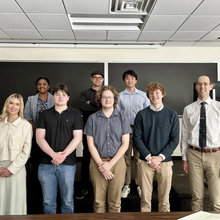
Sigma Pi Sigma Induction - Spring 2025
On March 21, 2025, the UVA chapter of the Sigma Pi Sigma National Physics Honor Society formally inducted its newest members. Professor David Nichols shared some words of guidance before the inductees pledged to uphold the society's commitment to academic excellence, outreach, and service. Each new member then signed the official roll, joining the legacy of past and present UVA Sigma Pi Sigma members.
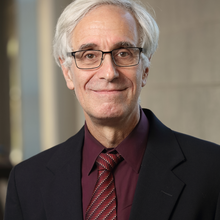
Bloomfield Honored as one of the Daily Progress' Distinguished Dozen
Professor Emeritus Lou Bloomfield has been honored by the Daily Progress as a member of their 2025 Distinguished Dozen cohort.
Fall 2024 Physics Newsletter
The Fall 2024 edition of our departmental newsletter features a message from the Chair, Despina Louca, a profile of new faculty member Cristina Mantilla-Suárez, a couple alumni stories, an update on International Space Station based Cold Atom Lab research by Professor Cass Sackett, and memorials to two late colleagues, Professor P.Q. Hung and Machine Shop Supervisor William Fariss. You can read the newsletter here:
http://www.phys.virginia.edu/Announcements/Newsletter/?ISSUE=Vol13Num01.pdf

Don Crabb, Respected Researcher and Beloved Colleague, Dies at 83
We report with great sadness that our colleague Don Crabb died on January 12, 2025 at the age of 83.
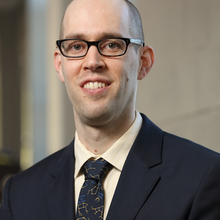
Nichols wins NSF CAREER award
We congratulate UVa Assistant Professor of Physics David Nichols on his NSF CAREER award for work "Investigating Matter and Spacetime Using Gravitational Waves".
The award supports research related to gravitational waves, a prediction of general relativity, which are produced during the mergers of strongly gravitating objects, such as black holes and neutron stars. Nichols and his research group will develop data-analysis methods and perform new theoretical calculations to search for as-of-yet undiscovered predictions of general relativity and identify new relativistic phenomena that could be observed through gravitational-wave measurements by the detectors LIGO and NANOGrav. He will also create new visualizations of the warped space around colliding black holes and accompanying recorded video explanations of the visualizations, which will help students to learn about the LIGO discoveries and teachers to convey these results to their students.
https://www.nsf.gov/awardsearch/showAward?AWD_ID=2439893
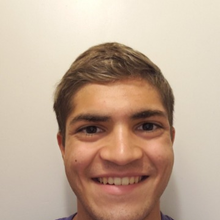
Crowe Wins Rhodes Scholarship
Undergraduate Astronomy/Physics and History major Sam Crowe has been awarded a prestigious Rhodes Scholarship. Sam studies star formation with Prof. Jonathan Tan in the Astronomy Department, and he has previously been recognized with a Goldwater Scholarship.
Congratulations, Sam!
More information is available here.
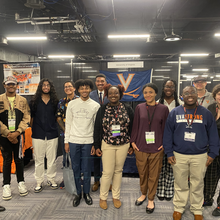
NSBP/NSHP 2024
UVa joined the 2024 joint meeting of the National Society of Black Physicists and National Society of Hispanic Physicists in Houston, TX.
Physics and Astronomy shared a recruiting table and ten students from UVa participated in the meeting as well as one department representative from each department.
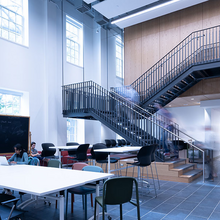
Physics Building Renovation Completed
UVa's College of Arts and Sciences celebrates the completion of the Physics Building's multi-year renovation project:
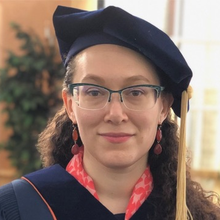
UVa alumna receives APS Award in Experimental Nuclear Physics
Caryn Palatchi, now an Assistant Professor at Indiana University, has been recognized for work she performed while a graduate student and postdoctoral scholar at UVa with the 2024 Stuart J. Freedman Award in Experimental Nuclear Physics. Professor Palatchi’s award citation reads:
For contributions to the measurement of the weak nuclear form factors, including the development of improved systems for controlling polarized electron beams.
The Freedman award was established in 2016 by the American Physical Society Division of Nuclear Physics to recognize Dr. Freedman’s legacy as a mentor to early career physicists. It is presented annually to an outstanding early career experimentalist in nuclear physics.
Caryn arrived at UVa as a graduate student in 2014 and started investigations of polarized laser optics for electron beam source with Professor Kent Paschke. From this work, she developed techniques for sub-nanometer stability of beam position under polarization reversal which enable next-generation precision measurement of parity violation in electron scattering. In particular, she developed essential technologies for the MOLLER experiment, an ultra-precise search for new physics which is currently under construction at Jefferson Lab.
She graduated with a Ph.D. in 2019. While a postdoctoral research associate at UVa in 2019 and 2020, she led the effort to control beam asymmetries during the PREX-2 and CREX measurements of weak nuclear form factors in the neutron-rich 208Pb and 48Ca nuclei. These results provide an important complement to the existing nuclear structure data set, and have proved to be a difficult constraint to incorporate into most existing models of nuclear structure.
In 2022, Caryn joined the faculty at Indiana University to continue her research program in nuclear and electroweak physics.
For more, see https://www.aps.org/funding-recognition/award/stuart-jay-freedman-award.
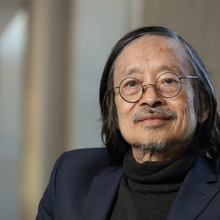
Physics Loses a Beloved Colleague
We note with great sadness that Professor Emeritus P.Q. Hung has passed away. An obituary can be found at the link below:
https://www.andersonfuneralservice.com/obituary/hung-pq-pham
A nice article from Vietnam News: Farewell to the "harbinger" of world particle physics
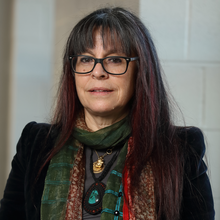
Liuti Elected to Fellowship in the American Physical Society
Congratulations to Simonetta Liuti for her election to Fellowship in the American Physical Society!
The APS Fellowship Program recognizes members who have made exceptional contributions in physics research, important applications of physics, significant contributions to physics education, or leadership in or service to APS.
Each year, no more than one half of one percent of the Society membership is recognized by their peers for election to Fellow of the American Physical Society. This year, 149 Fellows were selected and recognized for their contributions to science.
Simonetta was nominated by the APS Topical Group on Hadronic Physics. Her citation reads:
For advances in studying the three-dimensional quark and gluon structure of nucleons and nuclei through polarization observables in deeply virtual exclusive scattering and physics-informed deep learning architectures, and for significant service to the physics community, particularly the support and mentoring of female and other underrepresented scientists.
Learn more about the APS Fellowship Program.
Tenure-track Assistant Professor Position in Experimental Atomic, Molecular, and Optical Physics
The University of Virginia Physics Department invites applications for a tenure-track Assistant Professor position in Experimental Atomic, Molecular, and Optical (AMO) Physics, broadly defined. The appointment will begin on August 2025. The successful candidate is expected to establish an outstanding research program that adds significantly to the department's existing strengths in AMO physics, and to teach at undergraduate and graduate levels. The teaching load is one course per semester.
The Department of Physics at UVA offers B.A, B.S, M.A., M.S., and Ph.D. degrees. It currently comprises 38 research and teaching faculty, and graduates roughly 50 undergraduates and 15 PhD students per year. Three current faculty have primary research programs in experimental AMO physics. AMO faculty and students work closely with colleagues in the departments of Chemistry and Astronomy and the School of Engineering, in addition to having strong collaborations with other theory and experimental groups within Physics. The newly renovated Jesse Beams Laboratory features state-of-the-art experimental facilities and capacious available laboratory space. For more information on the department, please visit our website at http://www.phys.virginia.edu.
The city of Charlottesville boasts a thriving intellectual community and cultural life, with easy access to recreational venues and convenient travel to Richmond, Washington D.C. and Research Triangle Park. The scenic Central Virginia countryside and vigorous economy make Charlottesville one of the most highly rated locations in the nation. For more information about UVA and the area, please see https://www.virginia.edu/life/Charlottesville.
Qualifications
We are seeking candidates with a Ph.D. or equivalent in Physics or related field, postdoctoral experience, a strong record of publication, and an innovative research program. Candidates should demonstrate an aptitude and commitment to teaching and mentoring at both the undergraduate and graduate levels.
Application Instructions
Review of applications will start on December 1, 2024, and will continue until the position is filled. We will only consider complete applications.
To apply for this position please click on (Interfolio) and submit the following:
1. Cover letter that includes a summary of research plans, teaching interests and experience, and how your skills and experiences could advance the University’s ambition to cultivate the most vibrant community in higher education in order to prepare students to be leaders in a diverse and globally connected world.
2. Curriculum vitae
3. Research statement that describes your vision for your research program at the university (maximum 3 pages)
4. Statement on teaching and mentoring experience, philosophy and goals (maximum 2 pages)
5. Contact information for three references
For questions about the position, contact Cass Sackett, Search Committee Chair, at [email protected].
Equal Employment Opportunity Statement
The University of Virginia, including the UVA Health System which represents the UVA Medical Center, Schools of Medicine and Nursing, UVA Physicians Group and the Claude Moore Health Sciences Library, are fundamentally committed to the diversity of our faculty and staff. We believe diversity is excellence expressing itself through every person's perspectives and lived experiences. We are equal opportunity and affirmative action employers. All qualified applicants will receive consideration for employment without regard to age, color, disability, gender identity or expression, marital status, national or ethnic origin, political affiliation, race, religion, sex, pregnancy, sexual orientation, veteran or military status, and family medical or genetic information.
The University of Virginia offers confidential Dual Career Services to partners of incoming faculty candidates. To learn more, please visit dualcareer.virginia.edu
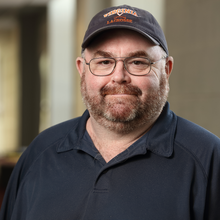
Sad News About a Treasured Colleague
We are sorry to report the death of our colleague William Farris. An obituary can be found at the link below:
https://www.hillandwood.com/obituaries/William-Henry-Fariss?obId=33079900
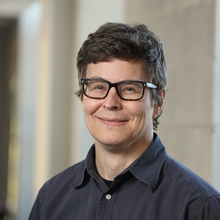
Quantum Mechanics is Out of this World
Cass Sackett is a principal investigator and science team member in the NASA Cold Atom Lab project, in which ultra-cold atoms are produced and studied on the International Space Station. A new report on the project has just been published in Nature Communications, which describes initial experiments using atom interferometry on the platform. Atom interferometry is a quantum mechanical effect in which a material particle has its wave function split into two distinct branches, effectively existing in two places at once. When the branches are recombined, the results convey precise information about the atom and its environment. The technique is expected to be especially effective in a space environment, with applications ranging from tests of general relativity to precision interplanetary navigation.
Read the paper at https://www.nature.com/articles/s41467-024-50585-6
For more, see
https://www.nasa.gov/missions/station/iss-research/cold-atom-laboratory/nasa-demonstrates-ultra-cool-quantum-sensor-for-first-time-in-space/
and
https://www.earth.com/news/nasas-cold-atom-lab-is-revolutionizing-quantum-science-in-space-iss/
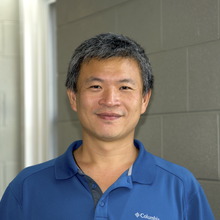
Chern Awarded Shannon Fellowship
Professor Gia-Wei Chern has been awarded a prestigious Shannon Fellowship. This recognition is bestowed upon faculty members who have made outstanding contributions to discovery, inquiry, scholarship, and creative expression at the university, within the community, and in their fields of expertise. It signals confidence that the person holding the honor has many more contributions ahead in the future.
Since 1994, the Shannon Center for Advanced Studies endowment has been used to support outstanding faculty members at the University. It recognizes excellent faculty members who are in the middle of their academic careers. Nominated by their deans, each Shannon Center Mid-Career Fellow receives funding to advance their research, scholarship, or special projects. Over a three-year period, the Shannon Center Mid-Career Fellows will come together to share their work and deepen connections with colleagues across Grounds.
National Physics Day
The University of Virginia Department of Physics presents:
A FAMILY ORIENTED EVENT
The 28th Annual NATIONAL PHYSICS DAY SHOW
Wednesday, April 24, 2024 from 6:00 - 7:00 PM (doors open 5:30 PM)
Room 101, Nau Hall, 1540 Jefferson Park Ave, Charlottesville, VA 22904
Click Here for Details
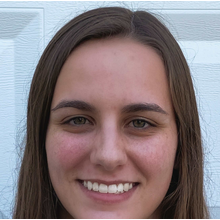
Pascadlo Wins DoE Office of Science Graduate Student Research Program Award
Graduate student Jessica Pascadlo was awarded a prestigious Office of Science Graduate Student Research (SCGSR) Program award. She works with Professor Craig Group on the Light Dark Matter eXperiment (LDMX) that is planned to take place at SLAC national lab at Stanford University in Pasadena, CA. For her SCGSR project, she will spend three months at SLAC where she will use one of the LDMX prototype detectors to help characterize the electron beam that will eventually provide electrons for LDMX.
For more information on SCGSR: https://science.osti.gov/wdts/scgsr
POSTPONED: Kip Thorne: Exploring the Warped Side of Our Universe
NOTE: This lecture has been postponed until a later date.
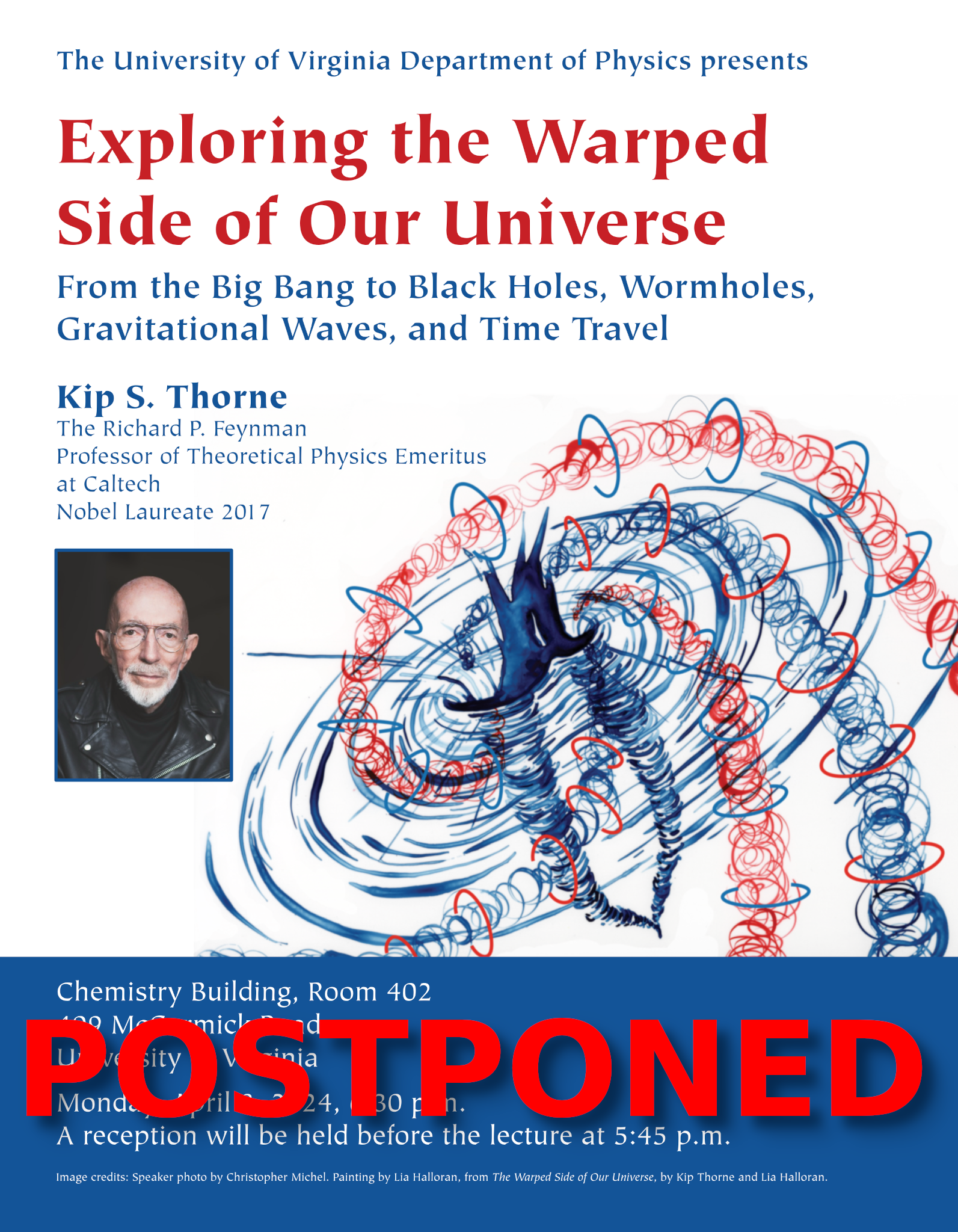
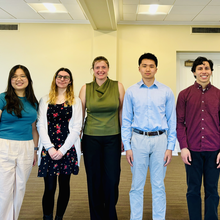
Sigma Pi Sigma Induction Ceremony
On March 21, 2024, new members of our chapter were ceremonially inducted to the National Physics Honor Society, Sigma Pi Sigma. Following words of wisdom and exhortation from Professor Stefan Baessler, inductees were charged and pledged to uphold Sigma Pi Sigma’s high standards of excellence in academics, outreach, and service. The inductees made their signature in the official roll among the names of all past and present members of Sigma Pi Sigma from UVA.
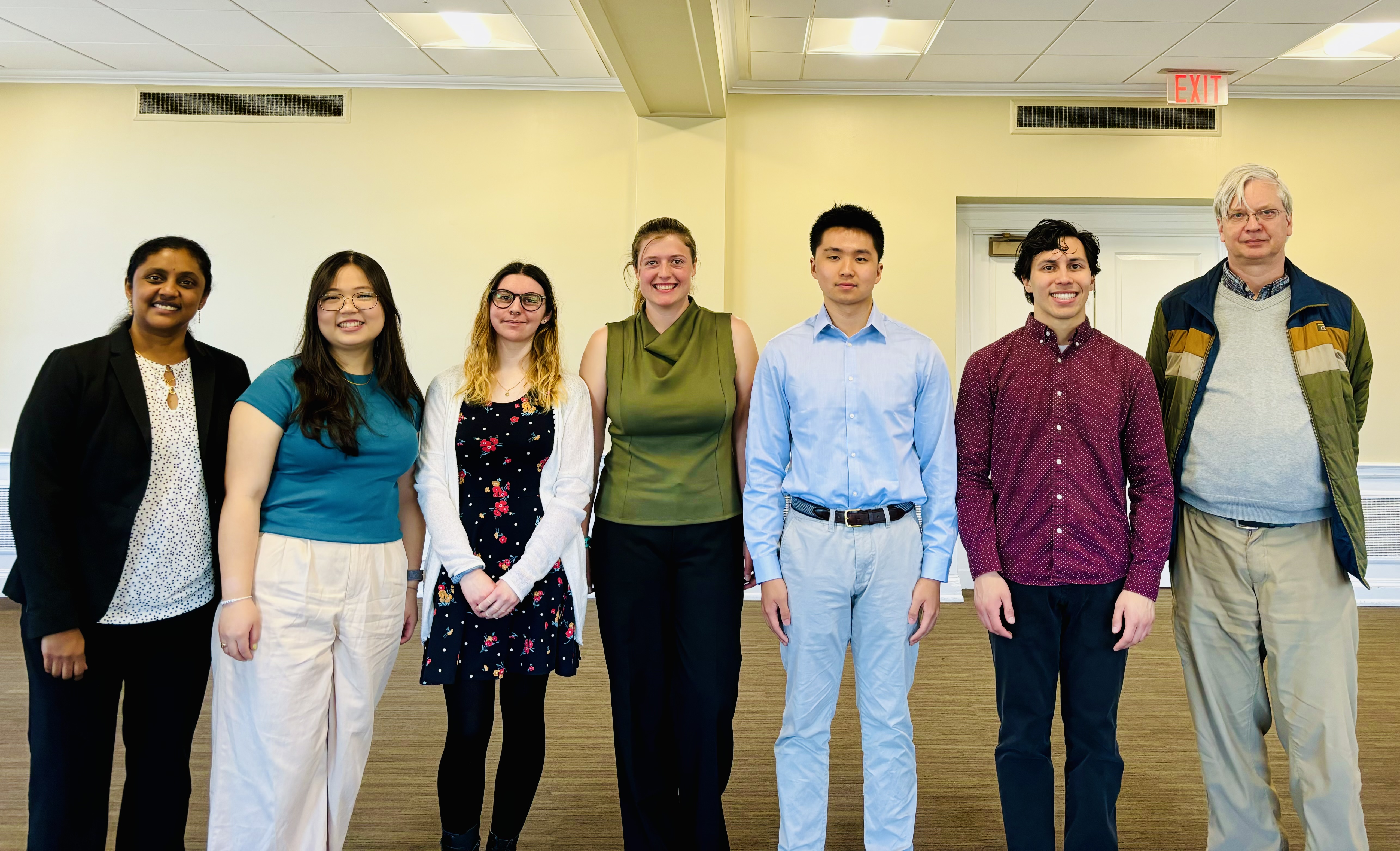
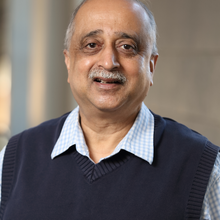
Shivaram Elected Vice-Chair of APS' Forum on Outreach and Engaging the Public
Bellave Shivaram has been elected to be the Vice-Chair of the Forum on Outreach and Engaging the Public (FOEP) of the American Physical Society. His one year term starts January 1, 2024. As per the APS bylaws the Vice-Chair successively becomes Chair-Elect, Chair, and Past Chair in coming years, for a potential total of four years of service.
For more, see https://engage.aps.org/foep/governance/executive-committee/committee-members
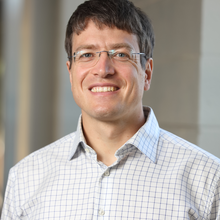
Schauss Recipient of 2023 Research Excellence Award
Peter Schauss has been selected as a recipient of the 2023 Research Excellence Award by the University of Virginia Research Achievement Awards committee. The award recognizes faculty members who have generated sufficient volume of scholarship of high quality and are emerging in their fields as leaders and acknowledged as such by their peers.
For more, see https://research.virginia.edu/initiatives/initiatives/research-achievement-awards and https://news.virginia.edu/content/uva-honors-faculty-research-and-scholarship
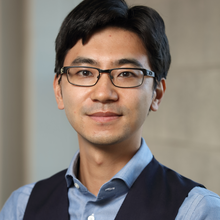
Yagi Honored with NSF Career Award
Congratulations to Kent Yagi who has been granted an NSF CAREER Award based on his proposal, “Exploring Strong-field Gravity and Dense Matter Physics through Gravitational-wave Observations”. The Faculty Early Career Development (CAREER) Program is the NSF’s most prestigious award for early-career faculty who have the potential to play a leading role in research and education. One of the activities to be investigated is to use machine-learning algorithms to test strong-field gravity with gravitational waves, which was initially supported by the internal collaboration fund from the department and the Owens Family Foundation.
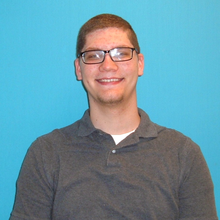
Sutton Wins Springer Thesis Award
Former graduate student Andrew Sutton won a Springer Thesis award in 2023. Sutton worked with Ph.D. advisor Craig Group on the NOvA experiment at Fermilab.
As part of this award, his thesis was published in book form:
https://link.springer.com/book/10.1007/978-3-031-43583-6

Equivalence Principle To Be Tested At Quantum Level In Cold Atom Lab Aboard The International Space Station
Congratulations to UVa Physics Professor Cass Sackett and colleagues, who have published a paper in the journal Nature in which they describe recent results at the Cold Atom Lab onboard the International Space Station. In this work, potassium atoms and rubidium atoms are simultaneously cooled to near zero temperature, and then probed using atom interferometry techniques. The ability to control two distinct elements in this way will be crucial for future goals to test Einstein’s Equivalence Principle at the quantum level, which states that atoms of different species should all orbit the earth in exactly the same way. The work also paves the way towards exploring interactions between ultracold atoms in a microgravity environment, which is useful because the mass difference tends to dominate all other effects when the atoms are in gravity.
The article is available at https://www.nature.com/articles/s41586-023-06645-w
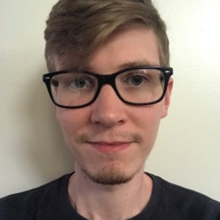
Horoho Wins DoE Office of Science Graduate Student Research Award
Tyler Horoho is a recipient of a Department of Energy Office of Science Graduate Student Research Award. From UVAToday:
From chasing subatomic particles to counting bees, Tyler Horoho’s varied research pursuits have led him to work and study at some of the nation’s top laboratories, thanks to a Department of Energy research award.
Horoho, a fourth-year doctoral student in physics at the University of Virginia, is one of 60 recipients of a U.S. Department of Energy Office of Science Graduate Student Research Award. This award permits recipients to carry out part of their doctoral dissertation research in Department of Energy national laboratories, providing a stipend and tuition support for up to three years.
For more, see https://news.virginia.edu/content/counting-bees-detecting-tiny-particles-grad-student-fulfilling-promise
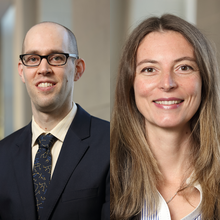
Nichols and Vucelja Interviewed for HOOS in STEM Podcast
Dear Friends,
It gives me great pleasure to announce this morning’s drop of the HOOS in STEM episode “UVA’s Physicists are studying Black Holes and Unraveling Ancient Paradoxes”. Enjoy (and share) the conversation with Physicists extraordinaire David Nichols and Marija Vucelja here on Apple Podcasts:
UVA’s Physicists Are Studying Black Holes and Unraveling Ancient Paradoxes
Hoos in STEM · November 3, 2023
Ken Ono
STEM Advisor to the Provost
Fellow, Shannon Center for Advanced Studies
Marvin Rosenblum Professor of Mathematics
Professor of Data Science by Courtesy
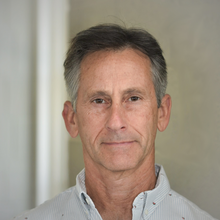
Jones Interviewed About 2023 Physics Nobel Prize
UVaToday interviewed Prof. Robert Jones regarding this years Physics Nobel Prize Award. As noted by UVaToday, Prof. Jones' research has some overlap with the Nobel recipients’ work and he collaborated with one of the laureates, Pierre Agostini.
For the UVaToday article, see
https://news.virginia.edu/content/electron-snapshots-present-sharper-picture-physics.
For an earlier news item about Prof. Jones' work with Pierre Agostini, see http://www.phys.virginia.edu/Announcements/News/ViewPost.asp?UUID=f62aa7e4-a794-11e7-a7fc-d067e5f349a5
and
https://news.virginia.edu/content/physicists-take-snapshots-electrons-move.
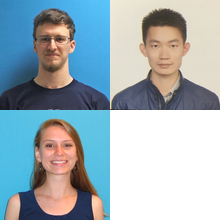
Congratulations to 2023's Physics Department Award Recipients!
Michael Bowler and Jason Boynewicz are co-recipients of the 2023 Outstanding Undergraduate Physics Major Award. The Outstanding Undergraduate Physics Major Award is presented each year to the graduating physics major or majors with the best overall academic record in physics throughout their study at the University. The winner will normally have completed a sequence of physics courses at, or beyond, that required for the Distinguished Majors Program. The prize consists of a book, chosen by the winner, and $400 to each student. Michael and Jason, each graduating with a distinguished BS in Physics with highest distinction and with perfect 4.0 GPA, are joint winners of this year’s Outstanding Undergraduate Physics Major Award. Jason will start graduate school at UT Austin in Texas and Michael is starting a job as a research assistant at the Johns Hopkins Applied Physics Laboratory.
Philip Velie is the recipient of the Stephen Thornton Award in Physics Undergraduate Research. This annual award recognizes the most outstanding research project completed by an undergraduate physics major. Philip’s research field is theoretical high energy physics. In Summer 2019, Philip joined the research activity at the SURA Center for Nuclear Femtography (CNF) under Professor Liuti’s supervision. Since then, he has contributed in various theoretical calculations, and making predictions for their experimental measurement. Philip’s research has been very productive. Philip receives this award for his contribution in a publication on a parameterization of Quark and Gluon Generalized Parton Distributions (GPDs), a short paper on the imaging of the nucleon using GPDs and numerical methods, and a short paper in preparation for publication on double-photon emission in Deep Inelastic Scattering using Color Glass Condensate Effective Field Theory.
Yu Tao and Grace Cummings have been jointly awarded this year’s Outstanding Graduate Student Research Award, which includes a check for $1000, to each student.
Yu Tao completed his PhD thesis in the field of experimental condensed matter physics under the supervision of Professor Despina Louca. As a student, Yu had mastered many techniques both at the University of Virginia as well as at different National Laboratories. The list includes transport and bulk magnetic susceptibility characterization under high magnetic fields and low temperatures, solid-state, floating zone and flux grown sample synthesis, X-ray diffraction, and handling of unstable-in-air compounds. His works on comprehensive characterizations of phase transitions between orthorhombic Td phase and monoclinic 1T' phase on MoTe2, WTe2 and their solid solutions has enabled new pathways towards manipulating novel topological phases in quantum materials. His works on magnetic and phonon dynamics of the Mott insulator YVO3, where he studied the dynamics of the transitions using inelastic neutron scattering and first-principles calculations, is expected to be impactful in the field of metal-insulator transitions. So far, his research resulted in ten peer-reviewed journal publications. Yu Tao is currently working as a postdoctoral researcher at the University of Minnesota.
Grace Cummings completed her PhD thesis in experimental high energy physics under the supervision of Professor Bob Hirosky. Grace has great accomplishments in instrumentation, physics studies, community building and innovative outreach efforts. Grace’s PhD studies focused on work at the CMS Experiment located in Geneva Switzerland at the CERN Large Hadron Collider. Her research considers searches for extensions to the standard model of particle physics utilizing the newly discovered Higgs boson as a signature. She also led the assembly and testing of Virginia’s “next generation clock and control system” for the CMS Barrel Calorimeter and then served on very select team with access to modify the on-detector systems...working for many months 3 stories above the ground, 30 stories underground, to accomplish the upgrade! Grace received a coveted collaboration-wide award for these and other important contributions to the operation of the experiment. Grace is now working as a Lederman Fellow at Fermilab, one of the more prestigious postdoctoral fellowships awarded in the field of experimental High Energy Physics.
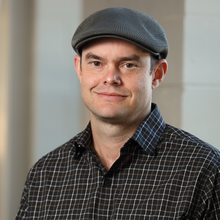
A Crash Course in Python Coding
Prof. Craig Group’s new class, PHYS1655, is a crash course in Python coding for scientists and engineers. Read the recent article here:
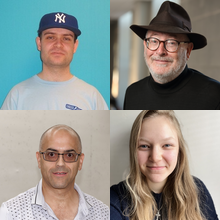
Designing a Muon Telescope to Explore the Great Pyramid of Giza
UVA research scientist, Dr. Ralf Ehrlich, at the April Meeting of the American Physical Society (APS) in Minneapolis, presented plans to search for hidden structures of the Great Pyramid of Khufu using cosmic-ray muons. Dr. Ehrlich, along with Dr. Alan Bross of Fermilab who leads the project, were interviewed for an article published by the APS in the June edition of their APSNews journal.
A link to the article can be found here: https://www.aps.org/publications/apsnews/202306/muon.cfm
Ehrlich, along with Prof. Craig Dukes and technician Eric Fernandez, have designed the detector that would be used to perform the search. The detector concept is “based on the design of the Cosmic Ray Veto detector that is being fabricated at UVA for the Mu2e experiment at Fermilab”, according to Ehrlich, who noted that the title of the APS article, which states that the detector was developed at Fermilab is not quite true. Ehrlich has been leading the simulation effort needed to determine the detector parameters and expected resolution in finding hidden voids. Those results were presented by Ehrlich at the Minneapolis meeting.
Ehrlich and Dukes, along with undergraduate physics major Sydney Roberts, are also engaged in a very similar project to explore the interior of the Temple of Kukulcan at Chichen Itza. Fabrication of the much smaller detector needed for this effort will commence this summer at UVA, with the detector to be transported to Mexico later this year.
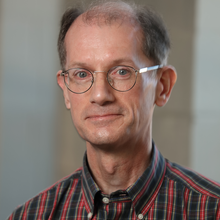
Wright Winner of 2023 Alumni Association Distinguished Service Award
Bryan Wright is the winner of the 2023 Alumni Association Distinguished Service Award. The Distinguished Service Award was established to recognize a member of the University community who has exhibited leadership qualities which serve as an inspiring example to his or her colleagues and other members of the University community.
The award was presented at the April 21, 2023, Alumni Association Spring Awards Luncheon.
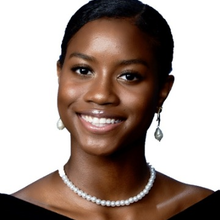
Ford wins Goldwater Scholarship
Dawn Ford, a third-year physics major, has won a 2023 Goldwater Scholarship, one of the most prestigious undergraduate scholarships in the natural sciences, mathematics, and engineering in America.
From UVAToday:
The scholarship program honors Sen. Barry Goldwater, and was designed to foster and encourage students to pursue research careers in natural sciences, engineering and mathematics. Each Goldwater Scholar annually receives an amount equal to the cost of tuition, mandatory fees, books and room and board, minus the amount of support provided for by other sources, up to a maximum of $7,500 per full academic year.
Ford said receiving a Goldwater Scholarship is an acknowledgement of her drive and research output over these past few years.
For more, see:
https://news.virginia.edu/content/goldwater-scholarships-ease-path-science-careers-student-trio
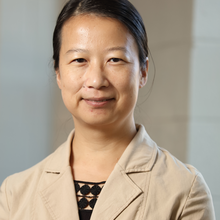
Zheng Winner of 2023 Alumni Association Distinguished Professor Award
Prof. Xiaochao Zheng is the winner of the 2023 Alumni Association Distinguished Professor Award. From UVAToday:
She piques student interest by framing physics as a science that answers fundamental questions, said one nominating colleague who provided text from Zheng’s class syllabus as an example: “Why does the sun shine? Why is sky blue? What is heat and what causes it? Can time flow backwards? Physics provides answers to all these questions, and many others you may have about the physical universe.”
For more, see
https://news.virginia.edu/content/uva-recognizes-professional-expertise-personal-kindness-outstanding-faculty
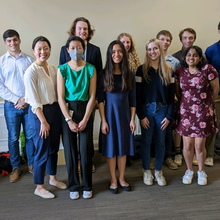
Sigma Pi Sigma Induction Ceremony
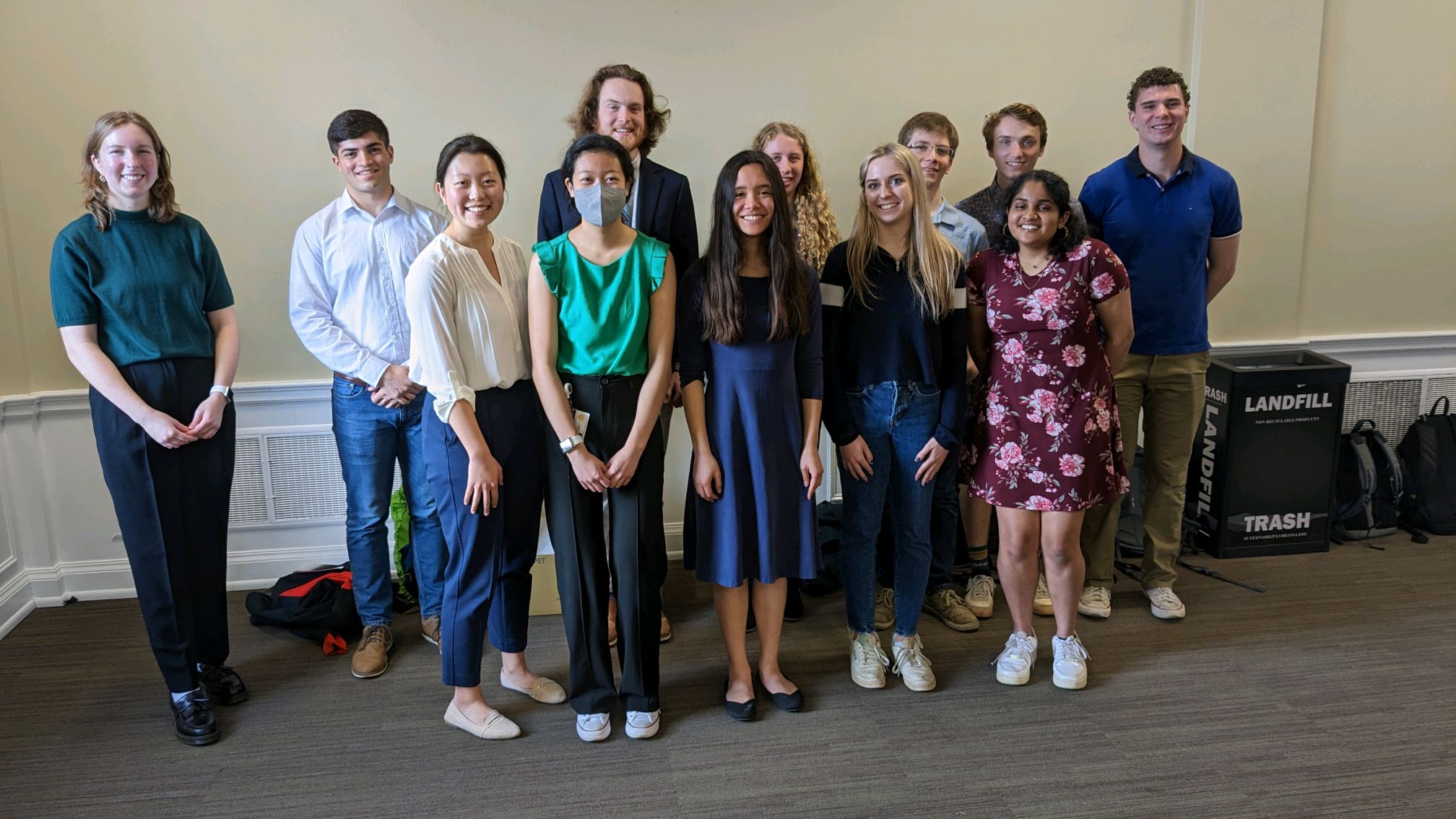
On March 24th, 2023, eleven new members from our chapter got inducted to the National Physics Honor Society - Sigma Pi Sigma during the induction ceremony. Following an impassioned and inspiring speech from our own Professor Chris Neu, inductees received the charge to uphold Sigma Pi Sigma’s high standards of excellence in academics, outreach, and service. The name of each inductee was then recorded in the official register of all past and present Sigma Pi Sigma members from UVA.
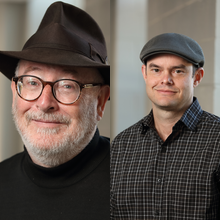
What The Heck Is A 'Cosmic Ray Veto Detector'?
The Craigs Group has shipped out their final large cosmic ray veto detector elements for the Fermilab based Mu2e experiment. UVAToday has a nice writeup:
https://news.virginia.edu/content/what-heck-cosmic-ray-veto-detector-final-large-shipment-heads-fermilab
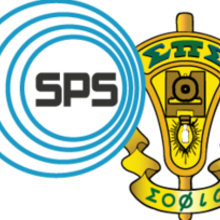
UVa's SPS Chapter Recognized as Outstanding
UVa’s SPS chapter has been named a 2021-22 SPS Outstanding Chapter, the 5th time in the last 7 years. This is the highest honor recognized at the chapter level and is only given to the top 15% of all SPS chapters in the country, with just 86 of 844 chapters honored so this year. The Director of the Society of Physics Students & Sigma Pi Sigma writes: “[...] your students should be proud [...] your students have earned this moment of recognition. Your combined efforts supported the department, helped further student development, and strengthened the community.”
For more information, see https://www.spsnational.org/awards/outstanding-chapter

Schauss Selected as a 2023 Alfred P. Sloan Research Fellow in Physics
Peter Schauss is this year’s winner of an Alfred P. Sloan Foundation fellowship for his work with ultra-cold quantum gases and quantum many-body physics. Peter has pioneered the development of “quantum gas microscopy” techniques for probing many-body physics in ultra-cold quantum gases. Schauss’ group designed and built a new quantum gas microscope, and demonstrated site-resolved imaging of ultracold fermionic atoms trapped in a triangular optical lattice.
For more, see https://sloan.org/fellowships
For a nice write-up, see http://as.virginia.edu/sloan-fellowships-will-advance-research-clean-energy-and-quantum-physics

Zheng Quoted in Quantamagazine
Xiaochao Zheng was quoted in a Quantamagazine article about the ongoing research into the internal structure of the proton.
From Quantamagazine:
Proof that the proton contains multitudes came from the Stanford Linear Accelerator Center (SLAC) in 1967. In earlier experiments, researchers had pelted it with electrons and watched them ricochet off like billiard balls. But SLAC could hurl electrons more forcefully, and researchers saw that they bounced back differently. The electrons were hitting the proton hard enough to shatter it — a process called deep inelastic scattering — and were rebounding from point-like shards of the proton called quarks. “That was the first evidence that quarks actually exist,” said Xiaochao Zheng, a physicist at the University of Virginia.
For more, see
https://www.quantamagazine.org/inside-the-proton-the-most-complicated-thing-imaginable-20221019/
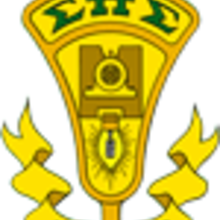
Twelfth Annual Sigma Pi Sigma Research Symposium
The Twelfth Annual Sigma Pi Sigma Research Symposium, organized by our Sigma Pi Sigma officers, was held on November 4th, 2021, in the Rotunda's Lower West Oval Room with students from the Physics and Astronomy Departments. Prizes were awarded to the following presentations:
Talks:
1st place: Theo O'Neill, "Mapping the Local Bubble's Magnetic Field in 3D"
2nd place: Katya Mikhailova, "Optical Cavity Design for Quantum Metrology"
3rd place: Sydney Roberts, "The Search for Hidden Structures in the Temple of Kukulcán at Chichén Itzá using Cosmic-Ray Muons"
Posters:
1st place: Sophia Yi, "Atomic-scale Studies on the Dissociation of CO2 over Single Sn Atoms Dispersed on Au(111)"
2nd place: Shrinidhi Nadgouda, "Constructing an Orthogonal Basis for Image Reconstruction in MATLAB using Principal Component Analysis"
3rd place: Darren Upton, "Extraction of αs using Bjorken Sums"
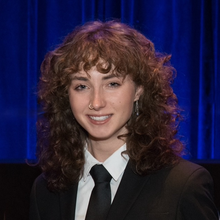
O'Neill Receives Astronaut Scholarship
From UVAToday:
Theo O’Neill will continue exploring space as an Astronaut Scholar.
“I think astronomy is fascinating because of the sheer scope of topics involved,” said O’Neill, a rising fourth-year astronomy-physics and statistics major at the University of Virginia. “The enormous range of physical and energetic scales encompassed in this one field, from the behavior of individual grains of dust to the dynamics of interacting galaxies, is incredibly awe-inspiring.”
For more, see https://news.virginia.edu/content/uva-astronomy-student-joins-ranks-astronaut-scholars
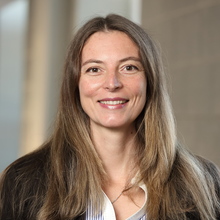
Vucelja Quoted in Quantamagazine
Marija Vucelja was quoted in a Quantamagazine article about the ongoing research into the Mpemba effect. [The strong Mpemba effect was predicted by Vucelja, Klich, et al., in a 2019 Physical Review X paper.]
From Quantamagazine:
Statistical physicist Marija of the University of Virginia started wondering how common the phenomenon might be. “Is this like is a needle in a haystack, or could it be useful for optimal heating or cooling protocols?” she asked.
For more, see
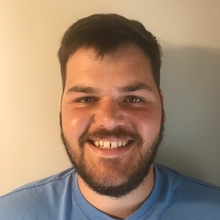
Presley Awarded DOE's Graduate Student Research Fellowship
Congratulations to Hunter Presley for winning Department of Energy’s Office of Science Graduate Student Research (SCGSR) Fellowship. With support from this award, Presley will work with Dr. Jianping Chen, a staff scientist at Jefferson Lab (JLab), on the upgrade, installation, and operation of the polarized 3He target in experimental Hall A of Jefferson Lab. Presley will also conduct the GEn-II experiment and measure the neutron form factor at high momentum transfer in JLab's fall 2022 run. The GEn-II experiment will significantly boost the nucleon form factor study, a classic topic of JLab's research since its commissioning in 1997.
For more details please see press release https://www.energy.gov/science/articles/does-office-science-graduate-student-research-scgsr-program-selects-80-outstanding
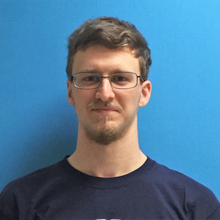
Velie a Runner-up for National Outstanding Undergraduate Research Award
Physics major Philip Velie has been selected as a runner-up for the Outstanding Undergraduate Research Award. The selection is made by the national Society of Physics Students on the basis of the applicant's research, letters of recommendation, and SPS participation. Philip Velie will receive travel support for a presentation at an upcoming APS meeting or similar.
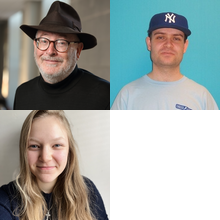
Using Particle Physics to Search for Hidden Chambers in Pyramids
Professor Dukes, research scientist Ralf Ehrlich, and undergraduate student Sydney Roberts are embarked on two archeology projects to search for hidden structures in the Great Pyramid of Khufu in Giza, Egypt and the El Castillo pyramid in Chichen Itza, Mexico. Using a novel detector design Dukes's research team developed for an experiment, Mu2e, at the Fermi National Accelerator Laboratory (Fermilab) outside of Chicago, they intend to probe the interior of the two pyramids using cosmic-ray muons, making a tomographic image of them.
Dukes and Roberts spent their spring break at Chichen Itza, working with other members of the research team making preliminary measurements and surveys of El Castillo, while Ehrlich took prototype detectors to Fermilab to measure their performance. The real scan commences next year.
The scan of the Great Pyramid of Khufu requires a much larger detector, for which Dukes and the rest of a different research team, after having received approval by the Egyptian Ministry of Antiquities, are seeking funding.
This work was featured in a recent UVA Today article: https://news.virginia.edu/content/professor-student-harness-space-particles-scan-ancient-pyramids
and an NBC news article featuring an interview of the leader of the Khufu team, Alan Bross: https://www.nbcnews.com/science/innovation/scientists-want-use-cosmic-rays-map-great-pyramid-gizas-secrets-rcna24839
QCD Evolution 2022 Workshop, May 9-13
Sponsored by the Department of Energy-funded Jefferson Lab and the Southeastern Universities Association, QCD Evolution has grown into an important hadron-physics meeting since its first workshop in 2011. With additional sponsorship by the College's Department of Physics, QCD Evolution provides a forum to discuss the most recent scientific advances in the exploration of the strong interactions and how they give rise to mass, spin and the internal structure of all visible matter at the femto scale, or the field of nuclear femtography. A major goal of the workshop is to provide guidance to the physics programs at experimental facilities from Jefferson Lab to the upcoming, next-generation nuclear physics accelerator in the U.S., the Electron Ion Collider (EIC).
The main topics addressed in next week's workshop in Newcomb Hall involve advances in both perturbative and non-perturbative techniques in Quantum Chromodynamics(QCD). The workshop will feature, in particular, two panel discussions open to questions from the audience on DEI and Machine Learning in nuclear physics.
For more see https://discovery.phys.virginia.edu/research/groups/qcd22/.

Zheng a Winner of Student Council 2022 Teaching Award
Prof. Xiaochao Zheng has been selected as a winner of a UVa Student Council 2022 Teaching Award. According to Adriana Gao, UVa Student Council's Director of Academic Affairs:
We loved reading student nominations highlighting your compassion, wisdom, and humor, and we believe that you thoroughly deserve to be honored for your work this year.
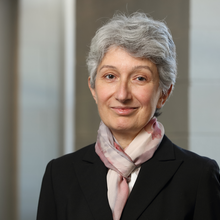
Louca Elected a Fellow of the Neutron Scattering Society of America
Despina Louca has been elected a Fellow of the Neutron Scattering Society of America (NSSA) in 2022. Less than 1% of the NSSA membership is accorded this recognition every two years, which is awarded on the basis of excellence in research and service to the neutron community.
Her citation reads:
For her leadership as NSSA President and her numerous contributions to the study of local structure of functional quantum materials using neutron scattering.
For more, see https://neutronscattering.org/prizes/nssa-fellows/
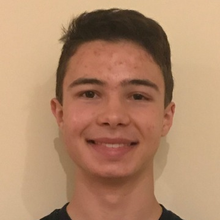
Leondaridis elected to Phi Beta Kappa
Physics major John Leondaridis was elected to the Phi Beta Kappa honor society, based upon his academic achievements and the depth and breadth of his studies. Congratulations, John! We look forward to hearing of your future achievements!
From the UVa Phi-Beta-Kappa web site:
Phi Beta Kappa is the nation's oldest and most prestigious undergraduate honors organization. For more than 200 years, the Society has pursued its mission of celebrating and advocating excellence in the liberal arts and sciences, and its distinctive emblem, a golden key, is widely recognized as a symbol of academic distinction. Students are elected to Phi Beta Kappa for their stellar academic performance, and whose studies celebrate both the breadth and depth of the liberal arts and sciences.
More information on election to Phi Beta Kappa at UVa can be found here: https://college.as.virginia.edu/awardsandhonors#phi-beta-kappa

MoEDAL Collaboration Sets Lower Mass Limit For Magnetic Monopoles
A recent article in Nature reports on results from the MoEDAL collaboration providing a lower mass limit for finite-size magnetic monopoles. P.Q. Hung is a member of the collaboration.
The discovery of an exotic particle carrying a magnetic charge - the so-called magnetic monopole - would have a profound impact on our understanding of why electric charges observed in nature only come in discrete values (charge quantization). Dirac was the first to propose an explanation for such a quantization by postulating the existence of a point-like, structureless magnetic monopole with an arbitrary mass, which also renders Maxwell’s equations symmetric upon the interchange between electricity and magnetism. There are however models in which magnetic monopoles have a finite size or, in other words, a composite particle. In addition, these models predict magnetic monopole masses which are in the energy range of current particle accelerators and, as a result, could be produced and detected. One of such models was proposed by P. Q. Hung (ref. 23 in the Nature article), Topologically stable, finite-energy electroweak-scale monopoles, Nucl.Phys.B 962 (2021) 115278; and John Ellis, P. Q. Hung and Nick E. Mavromatos, An electroweak monopole, Dirac quantization and the weak mixing angle, Nucl.Phys.B 969 (2021) 115468.
Searches for Dirac monopoles in accelerators were hampered by the fact that magnetic monopoles interact very strongly with normal matter and this prohibits a meaningful estimate of the production rate of such particles. Earlier searches for ”low mass”, finite-size magnetic monopoles relied on processes involving proton-proton collisions which, unfortunately, highly suppress their production. The novel approach by the MoEDAL experiment (of which P. Q. Hung is a member), described in the Nature particle, is to use heavy-ion collisions, such as Pb on Pb, to look for magnetic monopoles. In such heavy-ion collisions, an extraordinary strong magnetic field (more than four orders of magnitude stronger than the strongest known magnetic field present on magnestars) is created and can produce a pair of monopole-anti-monopole via the so-called Schwinger mechanism (originally proposed for the creation of a pair of electron-positron in the presence of a strong electric field), taking advantage of the duality between the electric and magnetic fields. The finite size and strong couplings of magnetic monopoles in the approach used by the MoEDAL collaboration enhance the production rate which can now be computed much more reliably and non-perturbatively, setting an exclusion lower limit of 75 GeV for the mass of a magnetic monopole. The present search by the MoEDAL collaboration is the first to have sensitivity to composite magnetic monopole at a collider which, in this case, is the Large Hadron Collider (LHC) situated in Geneva, Switzerland.
For Nature article, see https://www.nature.com/articles/s41586-021-04298-1.
Also see https://physicstoday.scitation.org/do/10.1063/PT.6.1.20220222a/ and https://www.insidescience.org/news/scientists-use-giant-atom-smasher-search-magnetic-monopoles.

Louca Receives Distinguished Researcher Award
Professor Louca has been selected to receive a Distinguished Researcher Award by the University of Virginia Research Achievement Awards committee. The Distinguished Researcher Award recognizes University of Virginia faculty members for their excellence in research through significant discoveries and scholarship. It is intended for scholars who are making an impact in their field and on society, and are acknowledged as a leader in their field. The award includes $3,000 in discretionary funding. Additional information available on the website https://research.virginia.edu/initiatives/initiatives/research-achievement-awards.
Also see https://news.virginia.edu/content/uva-honors-faculty-their-research-and-scholarship.
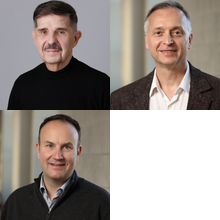
Cox, Hirosky, and Neu Receive Research Collaboration Award
Professors Cox, Hirosky, and Neu have been selected to receive a Research Collaboration Award by the University of Virginia Research Achievement Awards committee. This award recognizes a team of faculty researchers (3 or more individual scholars) who have collectively made unique and significant contributions through their research collaboration. One $5,000 award to support their collective research related activities.
Additional information available on the website https://research.virginia.edu/initiatives/initiatives/research-achievement-awards.
Also see https://news.virginia.edu/content/uva-honors-faculty-their-research-and-scholarship.
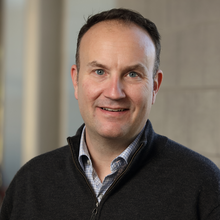
UVA Physics Idol!
Chris Neu's course assessment innovation has recently been recognized by a very nice article in UVAToday (https://news.virginia.edu/content/physics-idol-offers-students-alternative-method-assessment-popular-course).
Prof. Neu used social media to advertise this component of his course design (using “gamification to optimize positive learning outcomes”). Here's the social media post:
Do you have the talent and knowledge to be UVA’s next top physicist? If so, then you should audition for UVA Physics Idol!
Chris Neu, Professor of Physics and teacher of the popular PHYS 1050 course How Things Work, has designed this innovative assessment for students.
Physics Idol! is an oral exam where students come prepared to speak on a list of topics related to the content of the How Things Work course. Responses have a time limit and are judged on accuracy and completeness. “What better way for students to demonstrate mastery of How Things Work than to stand in front of a panel of judges and tell us, in their own words, how things work,” said Neu.
Neu and the Learning Assistants for the class serve as judges. This year’s Learning Assistants for PHYS 1050 are undergraduate 4th-year physics major Rose Gigliotti, 2nd-year PhD student Jessica Pascadlo and visiting scholar Dr. Lihong Yao. The Learning Assistants’ work is essential to the success of this program, which covers evening appointments with 120 students over three weeks in November.
Physics Idol! is part of Neu’s course design that uses gamification to optimize positive learning outcomes. “Demonstration of learning doesn’t have to be dry. We can do more than homework and exam problems to show we understand the concepts from class.”
And who knows, through Physics Idol! we might find our next physics superstar!
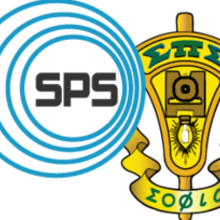
UVa's SPS Chapter Recognized as Distinguished
UVa’s SPS chapter has been recognized as “distinguished”. This honor is only given to the top 20% of all SPS chapters in the country. This is the eigth straight year that the local chapter has been recognized as either distinguished or outstanding.
For more about SPS Outstanding Chapter Awards, see:
www.spsnational.org/awards/outstanding-chapter
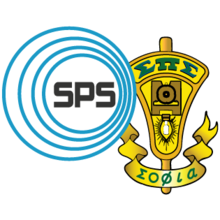
Eleventh Annual Sigma Pi Sigma Research Symposium
The Eleventh Annual Sigma Pi Sigma Research Symposium was held on November 5th, 2021, in the Rotunda's Lower West Oval Room. Professors Xiaochao Zheng, Ed Murphy, Craig Group, Gordon Cates were invited to judge student talks and posters from students in the Physics and Astronomy Departments. Prizes were awarded to the following presentations:
Talks:
1st place: Property Tuning of Layered Materials by Electrochemical Intercalation by Dawn Ford
2nd place: Coordinate Space Representation of Quark and Gluon Generalized Parton Distribution Functions by Zaki Panjsheeri
3rd place: Failure to Social Distance: Breaking Gathering Limits in Titan's Lakes by Alex Rosenthal
Posters:
1st place: Jet-Level Analysis of Simulated CMS Data for Machine Learning Applications by Gracemarie Buehlmann
2nd place (tied): Shaping the neutron beam profile at the Nab experiment by Martin Bowler and GEANT4 Monte Carlo Study of Electron-Proton Spatial Correlations in the Nab Detectors by William Musk (tied)
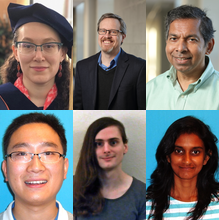
Neutron Skin Measurement
A new measurement, presented by UVa graduate and postdoctoral scholar Caryn Palatchi at the APS Division of Nuclear Physics annual meeting, reveals that heavier types of calcium nuclei are relatively thin-skinned. The result is the first electroweak measurement of the neutron skin in a medium-weight nucleus, and provides a new benchmark for models of nuclear structure.
The measurement was made on Ca-48, and isotope of calcium with 20 protons and 28 neutrons. The more numerous neutrons are expected to fill a larger volume than the protons, hence forming a “neutron skin” on the nucleus. The thickness of this skin is sensitive to poorly measured but fundamental parameters of nuclear matter, and has been never before been reliably determined. The researchers used a high precision measurement of a very subtle effect to get at this information. The scattering of electrons from neutrons depends on the electron spin in a way that violates mirror symmetry: two reactions which are otherwise identical mirror images of each other will have slightly different scattering rates due to the “weak” nuclear force. A scattering asymmetry of about 2.6 parts per million was measured to about 4% of itself, resulting in a precision of about 0.025 millionths of a nanometer on the skin.
The measurement is part of a series of experiments aimed at teasing out how protons and neutrons are distributed in dense nuclei. Earlier this year, the Pb208 Radius EXperiment (PREX) confirmed that lead-208 nuclei have a relatively thick skin. The new result in Ca-48 is especially striking given the relatively thick skin found in lead, a combination which is not easily accommodated by many models of nuclear structure.
The measurement also featured the highest precision result ever achieved in electron beam polarimetry. UVa students Allison Zec and Amali Premathilake operated and analyzed results from the Compton electron polarimeter, achieving a precision of 0.52% on the beam polarization. Other important contributions from UVa included GEM chambers built by Prof. Nilanga Liyanage and UVa student Siyu Jian to calibrate the electron spectrometers.
Professor Kent Paschke is co-spokesperson for the PREX/CREX collaboration.
Further reading:
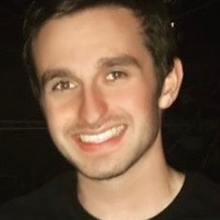
Cotton Awarded DOEâs Graduate Student Research Fellowship
Congratulations to Cameron Cotton for winning Department of Energy’s Office of Science Graduate Student Research (SCGSR) Fellowship. With support from this award, Cameron will work on two research topics with Dr. Dave Gaskell, a staff scientist at Jefferson Lab (JLab). The first is an upgrade of the Compton polarimeter that is essential for the upcoming high precision parity-violation experiments including MOLLER and SoLID‘s PVDIS. The second is to prepare for the XEM (x>1 and EMC) run group experiments that are coming online during JLab’s summer/fall 2022 run.
For more details please see press release Office of Science Graduate Student Research (SCGSR) Program selects 65 outstanding U.S. graduate students.
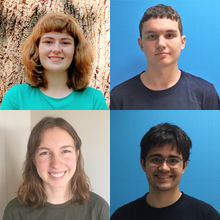
Buehlmann, Garwood, Mikhailova, and Stepniczka Receive 2021 Deaver Scholarship
The 2021 recipients of the Deaver Scholarship are listed below:
Gracemarie Buehlmann (4th Year) (BS)
Davis Garwood (4th Year) (BS)
Catherine Mikhailova (3rd Year) (BS)
Michael Stepniczka (3rd Year) (BS)
The Deaver Scholarships were established to honor Bascom S. Deaver, a retired physics department professor, and are awarded to students who have declared or are intending to pursue an undergraduate major in physics. They are competitive and awarded annually by the department to rising third or fourth year students. Winners are selected based on academic performance and demonstrated interest in pursuing the study of physics.
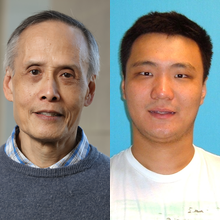
Machine Learning Algorithm Predicts How Multiple Alloyed Elements Interact
A new class of materials known as high entropy alloys (HEAs) has generated considerable excitement in the materials research community.
The number of possible HEAs can easily exceed a million or even billion, resulting in vastly numerous possible compositions and crystal structures. The large degree of compositional freedom provides vast and unique opportunities for discovering outstanding properties that will benefit society.
The challenge is finding the right compositions. Joseph Poon, University of Virginia William Barton Rogers Professor of Physics with a courtesy appointment in materials science and engineering, and his student Jie Qi, use data science to predict crystal structures and properties. They mine relevant data from binary phase diagrams for each pair of elements in a given alloy, then use machine learning to predict how they will work together. Their algorithm has achieved 81% accuracy in predicting multiple phases simultaneously when tested against the reported crystal structures of more than 800 high entropy alloys.
“Machine learning is the first stage,” Poon said. “It is a very good starting point, because it really helps you to avoid having to deal with a million samples.”
Guided by Poon’s and Qi’s computational results, researchers can synthesize compounds that look promising, experiment on them, and then feed what they’ve learned back into the machine learning algorithm to refine its predictions. The result is an alloy design process that is more agile and efficient, transitioning more high entropy alloys into fundamental research in materials physics, and equally important, practical use in catalysts, photovoltaics, thermoelectrics and battery materials as well as aerospace applications. Poon’s work is recently featured in AMERICAN CHEMICAL SOCIETY CENTRAL SCIENCE.

Louca Quoted in Physics Today
Despina Louca was quoted in Physics Today about the temporary closure of the NIST Center for Neutron Research (NCNR).
From Physics Today:
Louca says it will be difficult for her students to complete their theses without neutrons. “We do a lot of research on magnetic materials, and the neutron is the best probe when it comes to magnetism because of its intrinsic magnetic moment and the very high resolution that neutron techniques provide us with. Because they are highly penetrative, neutrons are also best for determining structures and dynamics in specialized environments, such as those involving magnetic and electric fields.”
For more, see https://physicstoday.scitation.org/doi/10.1063/PT.3.4854

Nichols Wins Ralph E. Powe Award
David Nichols is a recipient of a Ralph E. Powe Junior Faculty Enhancement Award for the 2021-2022 academic year. ORAU (Oak Ridge Associated Universities) has awarded the competitive research grants totaling $175,000 to 35 junior faculty from its member institutions. The annual grants are made through the Ralph E. Powe Junior Faculty Enhancement Awards program that provides funds to enrich the research and professional growth of young faculty.
For more, see https://www.orau.org/news/releases/2021/orau-awards-35-research-grants-to-junior-faculty-at-its-member-universities.html
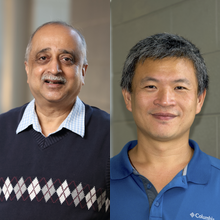
Nonlinear Magnetic Response of a Putative Quantum Spin Liquid
In a paramagnet such as common salt or a piece of aluminum the number of electrons that align with an external magnetic field, H, increases linearly initially with field. But as all spins line up the magnetization, M, saturates. Thus, the leading order correction to the linear susceptibility, M/H, is always negative and diverges as the temperature T is lowered towards absolute zero. This divergence is destroyed when spins correlate and the nonlinear response thus can provide unique insights into magnetic order. In particular, preponderance of quantum effects can imprint their signatures in the nonlinear magnetic response and assist in revealing the mysteries of the magnetic order. Spotting enhanced nonlinear terms experimentally is unique and as such becomes even more valuable when combined with theoretical expectations. This is precisely what Profs. Shivaram and Gia-Wei Chern working with their students have demonstrated in a recent a publication in the Nature Journal on Quantum Materials (https://www.nature.com/articles/s41535-021-00364-z). Focusing on α-RuCl3, a leading physical realization of a theoretical construct by Kitaev, they have discovered an unexpected quadratic field dependence of the magnetization, which arises only when the field is in the ab-plane of the α-RuCl3crystal, below a certain temperature, Tc. They also find unusually large and positive higher order cubic terms, both below and above Tc crossing zero only at a very large temperature T > 50 K. These findings shed new light on the physics of Kitaev materials which are strong candidates for a new state of matter called quantum spin liquid. These novel magnetic states have been proposed as platforms to realize topological quantum computing. In addition to the UVa researchers the work presented in the publication also involved an International collaboration with Germany and the US Naval Research Labs.
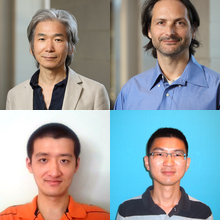
Freezing of a Spin Liquid with Strong Quantum Fluctuations
In magnets, spins of electrons can interact with their neighbors due to the overlap of their wavefunctions and the Pauli exclusion principle leading to an effective exchange interaction Hamiltonian. When the interactions are competing or frustrated, some interesting states of matter can arise at low temperatures. Quantum spin liquid is one of such states that is the most sought-after. There can however exist macroscopic number of metastable states that can dominate entropically over the spin liquid state, which will lead to a glassy state. It is still under debate whether or not freezing to such a glassy state is inevitable upon sufficient cooling and what is the nature of the glassy state. Recently, a national team led by S.-H. lee of the University of Virginia has revealed that Sr2CuTe0.5W0.5O6 which people thought a quantum spin liquid indeed freezes into a glassy state at low temperatures. They also found that the frozen glassy state exhibits a very weak frozen moment and short-range spin correlations while low energy spin dynamics resembles Goldstone modes that are a consequence of a spontaneous symmetry breaking into a long range ordered state. Their results present a theoretical challenge to fully understand the mechanism of the freezing of the spin liquid and the nature of the frozen state.
The team of University of Virginia is made of Seung-Hun Lee's group (Xiao Hu, Depei Zhang, and S.-H. Lee) and theorist Israel Klich.
* Xiao Hu, Daniel M. Pajerowski, Depei Zhang, Andrey A. Podlesnyak, Yiming Qiu, Qing Huang, Haidong Zhou, Israel Klich, Alexander I. Kolesnikov, Matthew B. Stone, and Seung-Hun Lee. Freezing of a disorder induced spin liquid with strong quantum fluctuations, Phys. Rev. Lett. 127, 017201 (2021).

Schauss Granted NSF CAREER Award
Congratulations to Peter Schauss who has been granted an NSF CAREER Award based on his proposal, “Quantum Gas Microscopy of Frustrated Hubbard Systems”. The Faculty Early Career Development (CAREER) Program offers the NSF’s most prestigious awards in support of the early career-development activities of teacher-scholars who most effectively integrate research and education within the context of the mission of their institution. This is well-deserved recognition of the quality of Peter’s previous work, recent results, and compelling plans for high impact future research.
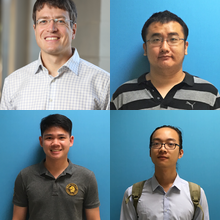
Quantum Gas Microscope is First to Image Individual Ultra-cold Fermionic Atoms in a Triangular Lattice
UVa Physics professor Peter Schauss and colleagues demonstrate a quantum gas microscope to image individual fermionic atoms in a triangular lattice. They prepare a degenerate Fermi gas, load it into the triangular lattice, and image the individual atoms with high imaging fidelity using Raman sideband cooling. The triangular-lattice platform will allow the study of density and spin correlations in frustrated Hubbard models to observe the strange properties of frustrated systems, including quantum spin liquids without long-range ordering at zero temperature, time-reversal symmetry breaking, and spin-hole bound states with significance to the understanding of superfluidity.
"Site-Resolved Imaging of Ultracold Fermions in a Triangular-Lattice Quantum Gas Microscope", Jin Yang, Liyu Liu, Jirayu Mongkolkiattichai, and Peter Schauss, PRX Quantum 2, 020344 – Published 21 June 2021
See paper at https://doi.org/10.1103/PRXQuantum.2.020344
An image from the paper received a $1000 Insight Award: https://andor.oxinst.com/insight-awards
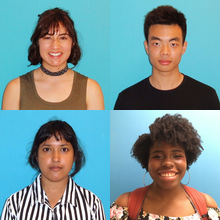
Congratulations to the 2021 Physics Department Award Recipients!
- Outstanding Undergraduate Major Award in Physics
·Jillian Ticatch
- The Steven Thornton Award in Physics Undergraduate Research
·Lingnan Shen, Advisor: Gia-wei Chern
- 2021 Outstanding Graduate Research Award in Physics
·Shammi Tahura, Advisor: Kent Yagi
- The Physics Community Leadership Award
·Morgan Waddy
- The Outstanding Undergraduate Physics Major Award is presented each year to the graduating physics major or majors with the best overall academic record in physics throughout their study at the University. The winner will normally have completed a sequence of physics courses at, or beyond, that required for the Distinguished Majors Program. The prize consists of a book, chosen by the winner, and $400. In addition, the name of each year’s recipient is engraved upon a plaque displayed in the Physics Department Library. This year, the Outstanding Undergraduate Physics Major Award was presented to Jillian Ticatch. Congratulations Jillian!
- The Stephen Thornton Award in Physics Undergraduate Research: The UVA Department of Physics has established an endowment for an annual award that recognizes the most outstanding research project completed by an undergraduate physics major. Each award winner receives $800 and has their name placed on a plaque prominently and permanently displayed in the physics library. Lingnan Shen received this award for his published research entitled, “Cell dynamics simulations of coupled charge and magnetic phase transformation”, which was performed under the guidance of Professor Gia-Wei Chern. Congratulations Lingnan!
- The Outstanding Graduate Student Research Award, which includes a check for $1,000, was presented to Shammi Tahura. Shammi will soon complete her dissertation entitled “Probing strong-field gravity with gravitational waves” under the supervision of Professor Kent Yagi. Shammi has conducted theoretical cutting-edge research on testing General Relativity with colliding black holes and neutron stars through gravitational waves. This is an exciting and hot research topic in physics, as the Nobel Prize has been awarded to gravitational wave physicists in 2017 and black hole physicists last year. Shammi has tackled her thesis project from three different directions: (i) formulating a model-independent tests of gravity with gravitational waves, (ii) probing extra dimensions (as predicted by string theory) with gravitational waves, and (iii) computing gravitational-wave memory in theories beyond general relativity. Congratulations Shammi!
- Through the Physics Community Leadership Award, the Department of Physics formally recognizes students who make significant efforts to strengthen and enhance our community of scholars and researchers. The award, which includes a check for $300, is made only in cases of exceptional student contributions to making the department a more welcoming and inclusive environment for all, consistent with the values of our department. It is given to those who demonstrate a dedication to leadership, and/or the ability to create a setting in which the principles of diversity, equity, and inclusion are respected and promoted. This year’s winner, Morgan Waddy, did both. Morgan was nominated by the membership of the Sigma Pi Sigma physics honor society, for her dedication to the Society of Physics Students during her two years of service as its President. She has made major community contributions to the Physics and Astronomy departments, and she proudly promotes the community principles that we value. Congratulations Morgan!
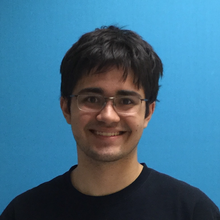
Stepniczka Awarded Edwin E. Floyd Prize
Michael Stepniczka, was awarded Edwin E. Floyd Prize from the Math Department. This prize is awarded annually to math majors who show exceptional promise in mathematics. Congratulations to Michael!

Bloomfield Wins All-University Teaching Award
Congratulations to Lou Bloomfield for winning a 2021 All-University Teaching Award! These awards recognize excellence in undergraduate, graduate, and/or professional teaching at UVA. Our students, and Department, benefit so much from all he does.
For more, see
and
https://www.as.virginia.edu/news/2021-arts-sciences-teaching-awards
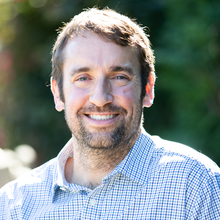
Hopkins' Research Helps Keep Pace with Moore's Law
A multidisciplinary group that includes Physics alumnus Patrick Hopkins (B.A. 2004), a professor in the University of Virginia’s Department of Mechanical and Aerospace Engineering with a courtesy appointment in the Physics Department, is inventing a new class of material with the potential to keep chips cool as they keep shrinking in size — and to help Moore’s Law remain true. Their work was recently published in Nature Materials.
“Scientists have been in search of a low-k dielectric material that can handle the heat transfer and space issues inherent at much smaller scales,” Hopkins said. “Although we’ve come a long way, new breakthroughs are just not going to happen unless we combine disciplines. For this project we’ve used research and principles from several fields – mechanical engineering, chemistry, materials science, electrical engineering — to solve a really tough problem that none of us could work out on our own.”
For more see
https://www.nature.com/articles/s41563-021-00934-3
and
https://physicsworld.com/a/polymer-based-insulator-could-help-maintain-moores-law/
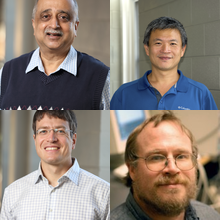
Physics Faculty Win 3Cavaliers Awards
Two separate teams lead by Condensed Matter physicists Bellave Shivaram and Gia-Wei Chern have won awards in the recent round of funding from the 3Cavaliers program of the University’s Vice Provost for Research Office. The 3Cavaliers program selects proposals which involve the participation of three UVa faculty with the requirement that at least two different departments/schools be involved. Each team was awarded $60,000 as seed money to start new projects.
Bellave Shivaram’s proposal on Helium droplet arrays to model Bose-Einstein Condensate lattices, combines the expertise of Kevin Lehmann (Chemistry) who has studied molecules entrapped in superfluid helium drops for many decades and Peter Schauss (Physics), an expert on optical lattices. See https://3c.virginia.edu/projects/193 for more.
Gia-Wei Chern’s proposal, joined by Sergei Egorov (Chemistry) and Chris Paolucci (Chemical Engineering), aims at developing multi-scale modeling of metal-insulator transition dynamics in correlated electron materials. See https://3c.virginia.edu/projects/229 for more.
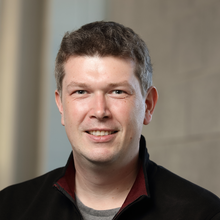
Heeck Interviewed by Science News
Prof. Julian Heeck was interviewed by Science News about the potential existence of antistars in the Milky Way.
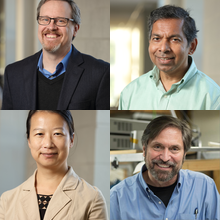
Measuring the neutron skin on the lead-208 nucleus
A new result from the PREX-2 experiment, recently published in Physical Review Letters, suggests that an unexpectedly thick “skin” of neutrons surrounds the lead-208 nucleus. With 82 protons and 126 neutrons, it has long been thought that the neutron distribution in this nucleus must be slightly larger than the proton distribution. But while the proton distribution had been well-mapped using electron scattering, measurements of the electrically-neutral neutrons required required a new experimental approach
The problem of mapping out the distribution of neutrons in a nucleus was solved by using the weak interaction between the electron and nucleus. A coincidence of nature leaves the weak charge of the proton to be small, less than 1/12th that of the neutron. And while the weak interaction is about a million times weaker than the electromagnetic interaction, it can be clearly identified as the only interaction which will violate mirror symmetry. Making a precise measurement of this broken mirror symmetry is experimentally difficult, but provides a measure of the neutron distribution which is free from theoretical uncertainties in interpretation.
The experiment, which ran at Jefferson Lab in the summer of 2019, measured an asymmetry in the rate of elastic scattering that correlated to the helicity of electrons incident on the lead nucleus. This small asymmetry, about one part in two million, was measured to a precision of about 3% of itself, and it implied that the neutrons were distributed in a sphere that was 5% +/- 1.3% larger than that of the proton distribution. This suggests a larger than expected penalty for increasing the density of neutron rich matter. A companion paper, published simultaneously, explores the implication of this result for the density and nature of neutron stars. The PREX-2 result, extrapolated to the few-times higher density of a neutron star, is seen to be in good agreement with the 2018 measurement of the density of a neutron star by the NICER collaboration, but in mild tension with the tidal deformability measured in the 2017 observation of a neutron star inspiral by LIGO.
The paper was selected for a Viewpoint in Physics and as an Physical Review Letters Editors’ Suggestion, and has been written up in a handful of science and technology magazines such as Science, Science News, and Gizmodo. The PREX collaboration is led by UVa professor Kent Paschke and includes UVa professors Nilanga Liyange, Xiaochao Zheng, and Gordon Cates. The collaboration also includes six UVa graduate students, three of whom are writing PhD dissertations on the experiment.
Prof. Paschke was interviewed by Salon about the results and how it relates to neutron stars.
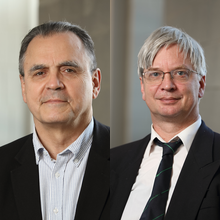
First results from the Muon g-2 experiment unveiled
The first result from the Muon g-2 experiment at Fermilab was unveiled and discussed publicly on Wednesday, 7 April 2021, in a special set of online seminars, that attracted widespread attention.
The Muon g-2 experiment is studying the so-called muon magnetic anomaly, the fact that the magnetic dipole moment of the muon differs from the simplest Dirac prediction given by setting the relevant parameter g=2. The discrepancy is due to subtle couplings to virtually excited particles "sparking" fleetingly from the vacuum. This coupling to virtual excitations of the vacuum opens a rare opportunity for indirect exploration of particles and fields that may exist outside the Standard Model (SM), now 50 years old, and so far maddeningly impervious to experimental challenges.
The newly revealed Fermilab result essentially confirms the previous, 20 year old value from Brookhaven National Lab, which was already at significant variance from the SM calculations. The new world average is even farther in statistical significance (4.2 sigma) from the SM value. The current Fermilab result reflects only 6% of the planned full data set, and, with measurements are continuing, Muon g-2 is on course to achieve a four-fold improvement in precision in a few years' time. At the same time significant progress is being made on the theoretical front, to make full use of the improved experimental precision.
UVa professors Dinko Počanić and Stefan Baeßler are among the founding members of the Fermilab Muon g-2 experiment, and remain active collaborators, along with their research groups.
Prof. Počanić was interviewed by UVAToday for a feature article:
Links to further reading:
- https://www.nytimes.com/2021/04/07/science/particle-physics-muon-fermilab-brookhaven.html
- https://news.fnal.gov/2021/04/first-results-from-fermilabs-muon-g-2-experiment-strengthen-evidence-of-new-physics/
- https://www.quantamagazine.org/muon-g-2-experiment-at-fermilab-finds-hint-of-new-particles-20210407/
Here are the links to the main papers presenting the new result:
- "Measurement of the positive muon anomalous magnetic moment to 0.46 ppm" by the Muon g-2 Collaboration: B. Abi et al., Phys. Rev. Lett. 126 (2021) 141801, https://journals.aps.org/prl/abstract/10.1103/PhysRevLett.126.141801
- "Magnetic-field measurement and analysis for the Muon g−2 Experiment at Fermilab" by the Muon g-2 Collaboration: B. Albahri et al., Phys. Rev. A 103 (2021) 042208, https://journals.aps.org/pra/abstract/10.1103/PhysRevA.103.042208
- "Measurement of the anomalous precession frequency of the muon in the Fermilab Muon g-2 experiment" by the Muon g-2 Collaboration: B. Albahri et al., Phys. Rev. D 103 (2021) 072002, https://journals.aps.org/prd/abstract/10.1103/PhysRevD.103.072002
- "Beam dynamics corrections to the Run-1 measurement of the muon anomalous magnetic moment at Fermilab" by the Muon g-2 Collaboration: B. Albahri et al., https://arxiv.org/abs/2104.03240
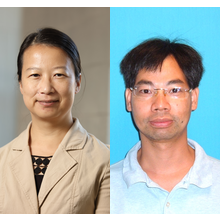
Research on the proton spin published in Nature Physics
The world may be buzzing about the muon spin this week, but the proton spin poses just as much challenge to the field of nuclear and particle physics. Analysis for an experiment that was carried out at Thomas Jefferson National Accelerator Facility was completed recently and results published in Nature Physics (open access link). The focus was to study the proton spin at a distance scale comparable to the proton size, where perturbative approach no longer works and one must use non-perturbative methods, such as effective theories that incorporates the first principles of quantum chromodynamics. We find no effective theory calculation describes all observables measured. These data provide new impetus to ongoing theoretical efforts to improve non-perturbative methods to describe the proton spin. One such possible method is lattice gauge theory, which in fact had provided a possible (and partial) explanation to the observed discrepancy between the muon g-2 and the Standard Model value. It appears that as we move on to higher and higher precision measurements, more and more are limited by our knowledge of hadronic effects and the strong interaction, even for a seemingly pure-leptonic effect like the g-2 of the muon.
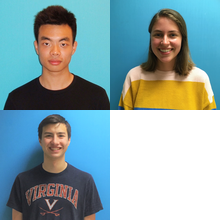
Shen, Wolz, and Blaser elected to Phi Beta Kappa
Physics majors Lingnan Shen, Anna Martha Wolz, and Ethan Blaser, were recently elected to Phi Beta Kappa.
From the UVa Phi-Beta-Kappa web site:
Phi Beta Kappa is the nation's oldest and most prestigious undergraduate honors organization. For more than 200 years, the Society has pursued its mission of celebrating and advocating excellence in the liberal arts and sciences, and its distinctive emblem, a golden key, is widely recognized as a symbol of academic distinction. Students are elected to Phi Beta Kappa for their stellar academic performance, and whose studies celebrate both the breadth and depth of the liberal arts and sciences.
More information on election to Phi Beta Kappa at UVa can be found here: https://college.as.virginia.edu/awardsandhonors#phi-beta-kappa

Sackett Interviewed By Scientific American
Cass Sackett was interviewed by Scientific American about a recent study where scientists achieved several seconds of microgravity by dropping ultracold atoms from a nearly 150-meter high tower: Ultracold Quantum Collisions Have Been Achieved in Space for the First Time
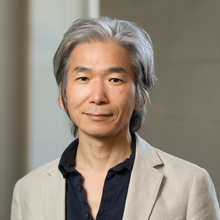
Lee and Colleagues Improving Weapons Screening at U.S. Ports
From UVaToday:
In a roundabout way, University of Virginia chemical engineering associate professor Joshua J. Choi and Commonwealth Professor of Physics Seung-Hun Lee are kindred spirits with the artists who created the beautiful stained-glass windows found in medieval churches and cathedrals. They are using the same technology that produces colored glass to help the Department of Homeland Security keep America safe.
For full story, see:

Hung Joins MoEDAL Collaboration
Prof. P.Q. Hung has joined the MoEDAL experiment (at the Large Hadron Collider) Collaboration. Prof. Hung's activities with MoEDAL consist of theoretical support to the Collaboration (he is collaborating with two theorists of the Collaboration: John Ellis and Nick Mavromatos).
From the MoEDAL website:
MoEDAL is a pioneering experiment designed to search for highly ionizing avatars of new physics such as magnetic monopoles or massive (pseudo-)stable charged particles. Its groundbreaking physics program defines over 30 scenarios that yield potentially revolutionary insights into such foundational questions as: are there extra dimensions or new symmetries; what is the mechanism for the generation of mass; does magnetic charge exist; what is the nature of dark matter; and, how did the big-bang develop. MoEDAL's purpose is to meet such far-reaching challenges at the frontier of the field.
For more, see https://moedal.web.cern.ch

Louca Elected to APS Panel on Public Affairs
Despina Louca has been elected to a three-year term on the American Physical Society's Panel on Public Affairs (POPA).
POPA is responsible for making recommendations to the President, the Board, and the Council on public affairs activities of the Society that have been designated by the Board or Council. POPA may initiate new public affairs activities for the Society and may recommend new programs to the Council. POPA shall keep minutes and distribute them to POPA members and to the Council and Board. All POPA reports and APS studies shall be approved by the Council before public release.
For more, see https://www.aps.org/about/governance/committees/popa/
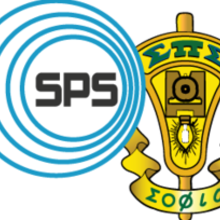
UVa's SPS Chapter Once Again Recognized as Outstanding
UVa's SPS chapter has been named a 2019-20 SPS Outstanding Chapter, the 4th time in the last 5 years. This is the highest honor recognized at the chapter level and is only given to the top 15% of all SPS chapters in the country. The Director of the Society of Physics Students & Sigma Pi Sigma writes: "You and your students have earned this moment of recognition. Your combined efforts supported the department, helped further student development, and strengthened the community."
For more information, see:
https://www.spsnational.org/awards/outstanding-chapter

Louca Organizing Workshop on Muon Spin Spectroscopy
Prof. Louca is organizing a 2-day workshop in February 1-2, 2021, on Muon Spin Spectroscopy. The workshop will be virtual given the ongoing COVID-19 pandemic. The Virtual Muon-2021 Workshop will give us an opportunity to listen to muon experts and discuss the possibility for constructing a future Muon facility in the United States at Oak Ridge National Laboratory. Your input on the scientific needs and design specifications will be most valuable. We hope you will join us in February!
For more, see https://www.mrs.org/muon-2021
Fall 2020 Physics Newsletter
The Fall 2020 edition of our departmental newsletter features a message from the Chair, Bob Jones, a profile of new faculty member David Nichols, several articles about life and work in our department during the COVID-19 pandemic, and a memorial to the late Professor Art Brill. You can read the newsletter here:
https://web.phys.virginia.edu/Announcements/Newsletter/?ISSUE=Vol09Num01.pdf
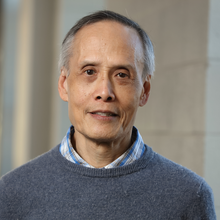
Joe Poon Awarded the 2020 Jesse W. Beams Award!
Joe Poon has been selected as the recipient of the 2020 Jesse W. Beams Research Award which is given annually by the Southeastern Section of the American Physical Society. The award will be bestowed (virtually) during the 87th Annual Meeting of the SESAPS, November 4 – 5, 2020.
Poon's citation reads:
"In recognition of his keen physical insights and significant contributions to a broad range of topics in experimental materials physics. These include ground breaking work on the first aluminum-based and nonmagnetic iron-based metallic glasses, novel work on alloy quasicrystalline phases and nano-crystalline aluminum alloys, and work in thermo-electric materials."
Here is a description of the Award from the APS (https://engage.aps.org/sesaps/honors/prizes-awards/beams):
"The Jesse W. Beams Research Award, first presented in 1973, was established by the Southeastern Section of the American Physical Society to recognize especially significant or meritorious research in physics, the major portion of which was carried out while the recipient was resident in the ten-state region of the Southeast. The award is named for Jesse Wakefield Beams, a remarkably broad and productive experimental physicist who received his Ph.D. from and spent most of his career at the University of Virginia. ... The Beams Award honors those whose research led to the discovery of new phenomena or states of matter, provided fundamental insights in physics, or involved the development of experimental or theoretical techniques that enabled others to make key advances in physics, and the contributions of the award recipient should have received the critical acclaim of peers nationally and internationally."

Liuti Appointed to APS Committee on the Status of Women in Physics
Simonetta Liuti has been appointed to the American Physical Society's Committee on the Status of Women in Physics (CSWP). The CSWP addresses the production, retention, and career development of women physicists and gathers and maintains data on women in physics in support of these objectives. It was founded in 1972 to encourage and address the career development of women physicists. The Committee consists of nine volunteer members appointed by the President of the APS, and sponsors studies, programs, and publications related to women in physics. Details on current programs can be found at Women in Physics.
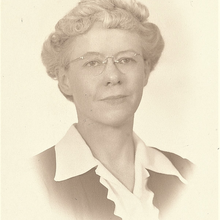
Trailblazing Physics Alumna Honored and Highlighted in Histories of Women at UVA
Just three years after the Virginia General Assembly passed a bill that enabled white women to enroll in "professional" and graduate programs at UVA, Lois Ketcham Carwile became the first woman to earn an undergraduate degree from the College of Arts & Sciences, a B.S. in Mathematics (1923). She then became the first woman graduate student in Physics at UVA, earning her Masters (1924) and PhD (1927). The Physics Department celebrates her role in helping to break down barriers to equality in educational opportunities for women, and will be hanging her portrait in the main conference room to honor her remarkable accomplishments.
See:
https://uvamagazine.org/articles/women_experiences_coeducation_uva
https://news.virginia.edu/content/retold-celebrates-women-uva-and-1970
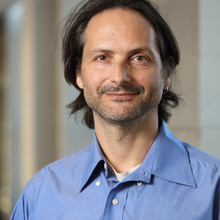
Klich Elected a Fellow of the American Physical Society
Congratulations to Israel Klich for his election to Fellowship in the American Physical Society!
The APS Fellowship Program recognizes members who have made exceptional contributions to the physics enterprise in physics research, important applications of physics, leadership in or service to physics, or significant contributions to physics education. Each year, no more than one half of one percent of the Society membership is recognized by their peers for election to the status of Fellow in the American Physical Society.
Israel was nominated by the APS Division of Condensed Matter Physics, and his citation reads:
For deep insights and rigorous results in many areas of condensed-matter theory, including entanglement entropy, the Casimir effect, electron counting and control, and topological order.
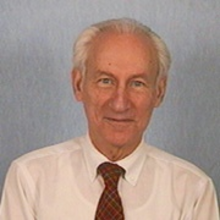
In Memoriam: Prof. Emeritus Art Brill
Arthur S. Brill, Professor Emeritus, Department of Physics, University of Virginia
June 11, 1927 – June 2, 2020
Arthur Sylvan Brill, Professor Emeritus, died of COVID-19 on June 2, 2020 in Newtown Square, PA. Art is survived by his two daughters, Julie and Claire Brill, and four grandchildren. He was predeceased by his wife of sixty years, Patricia Hartig Brill, who died in February, 2018.
A Philadelphia native, Art graduated with highest honors in Physics from UC Berkeley in 1949. In 1956, he earned a PhD in Biophysics from the University of Pennsylvania, where he worked at the Johnson Foundation with Britton Chance and Hendrik den Hartog. There, he developed a fast and sensitive magnetic susceptometer for study of rapid biochemical reactions. His subsequent research focused on using magnetic susceptibility and electron paramagnetic resonance techniques to characterize the role of transition metal ions in proteins during biological oxidation. The main experimental systems that were the subject of his investigations included iron in hemoglobin and myoglobin and copper in blue metalloproteins such as azurin.
Art's career took him to Oxford, Cornell, Yale, and ultimately the University of Virginia, where he was on the faculty for thirty years before becoming an emeritus professor. He stayed involved in research into his 90s. His former postdoc, Bernard Gerstman (Professor of Physics, Florida International University), describes Art as "… a physicist's physicist. He devoted his life to science because he loved it. This was manifested in his research and teaching, and the care that he devoted to both. His abilities in both experimental and theoretical work were remarkable. Usually it is one or the other, but he was impressive with both because he loved science."
His friends and colleagues in the Physics Department will always remember him fondly.
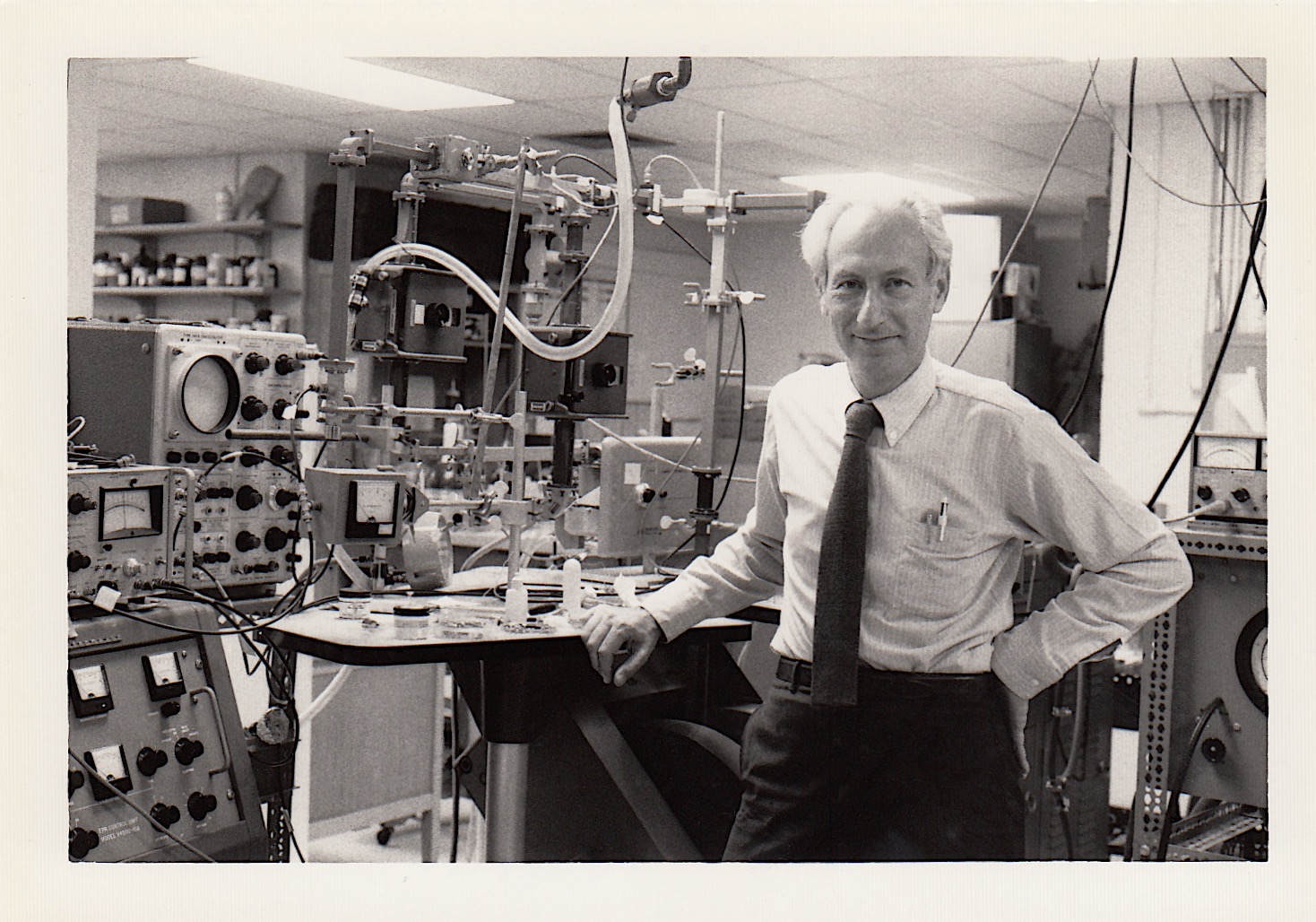

Vucelja Quoted in ScienceNews
Marija Vucelja was quoted in a ScienceNews article about a Nature paper describing experimental results consistant with the strong Mpemba effect. [The strong Mpemba effect was predicted by Vucelja, Klich, et al., in a 2019 Physical Review X paper.]
From ScienceNews:
But the simplicity of the study is part of its beauty, says theoretical physicist Marija Vucelja of the University of Virginia in Charlottesville. “It’s one of these very simple setups, and it already is rich enough to show this effect.” That suggests the Mpemba effect could go beyond glass beads or water. “I would imagine that this effect appears quite generically in nature elsewhere, just we haven’t paid attention to it.”
For more, see
https://www.nature.com/articles/s41586-020-2560-x
and
https://journals.aps.org/prx/abstract/10.1103/PhysRevX.9.021060
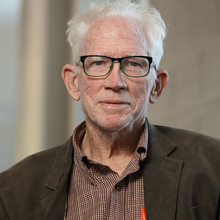
Day Publication Selected by Physical Review C as Milestone Paper
2020 is the 50th anniversary of Physical Review C which was spun-off by its parent publication, The Physical Review, in 1970. As part of its anniversary PRC is creating a collection of milestone papers that "remain central to developments in the field of nuclear physics. These papers announce major discoveries or open up new avenues of research."
PRC has selected a paper by Donal Day and his co-authors, M. Strikman, L. Frankfurt and M. Sargsian, "Evidence for short-range correlations from high Q2 (e,e’) reactions", published in Phys. Rev. C 48, 2451 (1993) for recognition. This paper presented the first experimental evidence for the existence of short range correlations between nucleons in the nucleus. These short range correlations emerge due to the repulsive core of the NN potential and generate very large momentum components in the nuclear ground state. Since the publication of this paper in 1993 there has been an explosion of activity, theoretical and experimental, associated with the study of short range correlations and these studies remain a significant part of Jefferson Lab's program.
Read more at: https://journals.aps.org/prc/50th
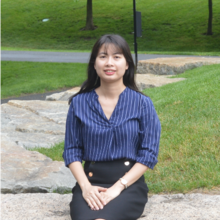
Nguyen awarded the Nathan Isgur Postdoctoral Fellowship in Nuclear Experiment
Jefferson Lab has recently announced that Dien Nguyen, a 2018 graduate of the department, has been awarded the Nathan Isgur Postdoctoral Fellowship in Nuclear Experiment. Dien arrived at UVa in 2011 having earned her undergraduate degree from Hue University, Vietnam in 2010. In 2009 she met her UVa advisor, Research Professor Donal Day, when he took part in a joint UVa-Hue University program (created and organized by Prof. PQ Hung of our department) in which the UVa undergraduate physics curriculum was taught to Hue University undergraduates.
Dien earned her Ph.D. in late 2018 from an experimental program (at Jefferson Lab) designed to probe the details of the nucleon-nucleon interaction at short distances. After graduation from UVa she took a postdoctoral position at MIT. Nguyen, the first woman to receive this award, will return to Jefferson Lab for her 3-year fellowship.
See also https://www.jlab.org/news/releases/studying-small-learn-big
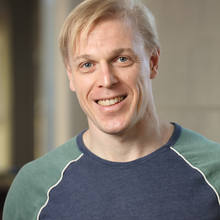
Bychkov Helps Inspire Pre-Med Student
In an article highlighting a recent grad's COVID-19 service, credit was given to Max Bychkov as one of the professors who helped convince her that the pre-med track was right for her.
See https://news.virginia.edu/content/email-amid-chaos-sparked-recent-grads-covid-19-service-effort

Sackett participates in NASA cold-atom experiment
Cass Sackett is a principal investigator and science team member in the NASA Cold Atom Lab project, in which ultra-cold atoms are produced and studied on the International Space Station. A report on the project has just been published in Nature, which describes the first production of a Bose-Einstein condensate in Earth orbit. The paper reports atoms cooled to temperatures below 1 nanoKelvin; Sackett is working on methods to make the atoms colder yet.
See https://www.nature.com/articles/s41586-020-2346-1
For some background, see https://link.springer.com/article/10.1007/s12217-017-9584-3
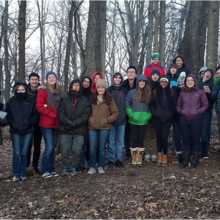
UVA SPS Holds Drive to Support Under-Represented Minorities
The UVA Chapter of the Society of Physics Students (SPS) has created a funding drive to encourage donations to several organizations dedicated to assisting under-represented minorities, especially in education.
See https://docs.google.com/forms/d/e/1FAIpQLSfKkiC3x76TKfDp5YfmQNgknpMMW664h4JxT0Ms2NFED5iN7g/viewform
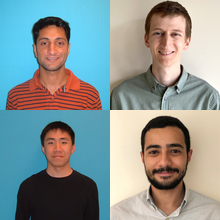
Congratulations to this year's Physics Department Award Recipients!
Rajveer Nehra is the recipient of the 2020 Outstanding Graduate Research Award in Physics. Raj will soon complete his dissertation entitled “Non-Gaussian States and Measurements in Quantum Information Science” under the supervision of Professor Olivier Pfister.
Drew Wilkers and Andrew Jiao are co-recipients of the 2020 Outstanding Undergraduate Physics Major Award. The Outstanding Undergraduate Physics Major Award is presented each year to the graduating physics major or majors with the best overall academic record in physics throughout their study at the University. The winner will normally have completed a sequence of physics courses at, or beyond, that required for the Distinguished Majors Program.
Ephraiem Sarabamoun is the recipient of the Stephen Thornton Award in Physics Undergraduate Research. This annual award recognizes the most outstanding research project completed by an undergraduate physics major. Ephraiem received this award for his published research entitled, “Solitons in the Einstein universe,” which was performed under the guidance of Professor Eugene Kolomeisky.
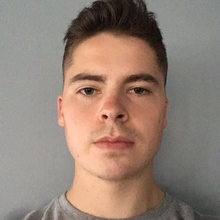
Nadjari elected to Phi Beta Kappa
Fourth year Physics major Sam Nadjari has been elected to Phi Beta Kappa, the nation's oldest and most prestigious undergraduate honors organization. The Society has pursued its mission of celebrating and advocating excellence in the liberal arts and sciences. Congratulations!
See http://college.as.virginia.edu/awardsandhonors#phi-beta-kappa
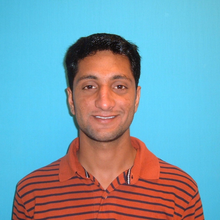
Nehra Wins 2020 Gwathmey Award
Congratulations to Rajveer Nehra who has been honored with the 2020 Allan Talbott Gwathmey Memorial Award!
This award comes with a $6,500 prize, and is reserved for the most accomplished graduate students in the physical sciences at the University of Virginia, in recognition of a distinguished scholarly publication.
Raj's award is based on his publication:
Rajveer Nehra, Aye Win, Miller Eaton, Reihaneh Shahrokhshahi, Niranjan Sridhar, Thomas Gerrits, Adriana Lita, Sae Woo Nam, and Olivier Pfister, "State-independent quantum state tomography by photon-number-resolving measurements", Optica 6, 1356 (2019).

Zheng Interviewed in Nature News
Xiaochao Zheng is interviewed in Nature News article about the highly successful virtual APS April Meeting.
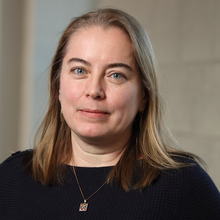
Vaman Wins All-University Teaching Award
Congratulations to Diana Vaman for winning a 2020 All-University Teaching Award! This is very well-deserved, and overdue, recognition for her consistent dedication to, and excellence in, classroom teaching.
Louis Nelson, Vice Provost for Academic Outreach, and several Physics Department faculty crashed Diana's Zoom class to make the announcement.
For more, see http://as.virginia.edu/ampersand/award-winning-teachers-share-their-secrets-‘involve-me-and-i-learn’
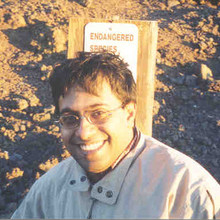
Ghosh Viewpoint featured in Physics
Avik Ghosh wrote a Viewpoint, "Spin Control with a Topological Semimetal", for Physics, an American Physical Society site that provides daily on-line news and commentary about papers from the APS journal collection. According to Physics, Viewpoints are "Commentaries on papers written by prominent experts in their field. Written by an active researcher for an audience with a college-level background in physics."
For Avik's Viewpoint, see:
https://physics.aps.org/articles/v13/38

Bloomfield Explains the Crucial Math Behind Social Distancing
Professor Lou Bloomfield has posted a video explaining how social distancing can help to "flatten the curve" by decreasing the exponential growth of COVID-19.
Nice write-ups can be found at
and

Hung's Contributions Highlighted in Vietnamese Newspaper
PQ Hung’s significant contributions to higher education and scientific research in Vietnam were highlighted in the lunar New Year issue of the popular Vietnamese newspaper Thanh Nien. The full article (in Vietnamese) can be found here:
https://thanhnien.vn/thoi-su/nguoi-bac-nhip-cau-cho-khoa-hoc-viet-nam-1169566.html
A pdf of a Google translation of the article (in English) can be found here:

Vucelja Granted NSF CAREER Award
Congratulations to Marija Vucelja who has been granted an NSF CAREER Award based on her proposal, “Anomalous Thermal Relaxation of Physical Systems.” The Faculty Early Career Development (CAREER) Program offers the NSF’s most prestigious awards in support of the early career-development activities of teacher-scholars who most effectively integrate research and education within the context of the mission of their institution. This is well-deserved recognition of the quality of Marija’s previous work and her compelling plans for future research.
For some nice write-ups, see
https://researchdevelopment.vpr.virginia.edu/physicist-marija-vucelja-receives-nsf-career-award ,
https://news.virginia.edu/content/uva-science-and-engineering-faculty-win-eight-nsf-career-awards ,
and

Sackett's Intro Physics Course Garners Praise
From UVAToday:
On UVA’s Instagram account, we asked students about their favorite fall-semester courses. Submissions poured in with students highlighting engaging classes and how professors’ teaching styles transformed their classroom experience.
One highlighted course was PHYS 1710, "Introductory Physics I: Classical Mechanics, Waves, Thermodynamics" taught by Cass Sackett:
“Even though the class was hard, it never felt intimidating because he was always reassuring, hosted ample amounts of office hours, and was just super-compassionate,” he said. “My favorite part were honestly the lectures, because he would do great demos and I lived for his small jokes he threw in.”
For more, see https://news.virginia.edu/content/students-take-instagram-highlight-their-favorite-fall-courses
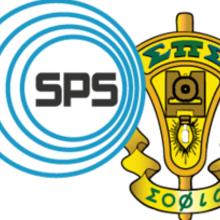
UVa's SPS Chapter Recognized Yet Again as Outstanding
UVa's SPS chapter has been named a 2018-19 SPS Outstanding Chapter for the 3rd time in the last 4 years. This is the highest honor recognized at the chapter level and is only given to the top 15% of all SPS chapters in the country. The Director of the Society of Physics Students & Sigma Pi Sigma writes: " You and your students have earned this moment of recognition. Your combined efforts supported the department, helped further student development, and strengthened the community."
For more information, see:
https://www.spsnational.org/awards/outstanding-chapter

Liuti Awarded 2019 Francis Slack Prize
The Southeastern Section of the American Physics Society (SESAPS) has awarded Simonetta Liuti the 2019 Francis Slack prize. This award is in honor of her excellence in service to physics in the Southeast. The citation reads:
Dr. Simonetta Liuti has demonstrated excellence in service to the physics community of the Southeast through her contributions at Jefferson Lab, leadership roles within SESAPS, and the promotion of inclusion in physics in the region. Dr. Liuti has made significant contributions to the Jefferson Lab science program via her theoretical work and her prominent involvement with the establishment of the Center for Nuclear Femtogrophy (CNF) at Jefferson Lab. In addition, she has supported SESAPS through her service in the chair line from 2012-2016 and as SESAPS program meeting chair in 2014. Finally, Dr. Liuti has helped further the goals of improving diversity and inclusion in the Southeast physics community through the organization of various workshops and meetings and participation in committees, with particular focus on (although not limited to) the role of women in physics.
For more about the history of the award, see:
https://www.aps.org/units/sesaps/awards/slack/index.cfm
Jefferson Lab has a very nice writeup as well:

Bloomfield's "How Things Work" Online Course Highlighted
From Big Think:
A great intro course that looks at physics in the context of everyday objects and processes. How does skating work? Why do things fall? The course uses the cases of ramps, wheels, bumper cars and more to illuminate the physics of life around you. It is taught by the University of Virginia physics professor Louis A. Bloomfield, a noted science educator, lecturer, author, as well as tv host.
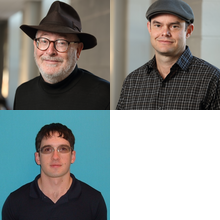
Craigs' Group Work Highlighted in Cavalier Daily Article
From The Cavalier Daily:
University physicists are beginning to make their mark on two multi-million dollar experiments in particle physics by contributing their research analyses to experiments with the Fermi National Accelerator Complex — Fermilab for short. These experiments, called the Muon-to-electron Conversion Experiment, or Mu2e, and an additional neutrino experiment called NOvA, have the potential to drastically change what is known within the field of particle physics today. While NOvA is underway, Mu2e experiments are scheduled to begin in 2023.
...
“There are many experiments at Fermilab, and U.Va. has a long history of contributions to these experiments,” said Craig Group
...
“We are still in the construction stage, which will last for another year and a half,” said Craig Dukes
...
Through these experiments, the University is also able to offer mass opportunity for undergraduate involvement, such as through fourth-year College student Ben Barton, who has been working on the Mu2e experiment for a little over two and a half years.
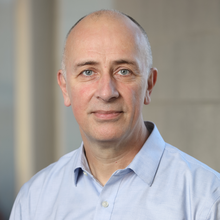
Pfister Discusses the Goals and Benefits of the UVA Physics Graduate Bridge Program
In an interview for the Optical Society of America’s “OSA Stories,” Olivier Pfister gives his perspective on the importance of providing graduate school opportunities for bright students from underserved or disadvantaged backgrounds. Watch it here: https://www.osa.org/en-us/media_library/

Craigs' Group Mu2e Work Highlighted in UVAToday
Work by the Dukes and Group group on a major experiment at Fermilab to search for neutrino-less muon to electron conversion is highlighted by UVAToday with a photo spread. From UVA Today:
University of Virginia physicists are building major components for one of the largest and most complex physics experiments ever conducted in the United States: a $271 million particle physics project at the Department of Energy’s Fermilab near Chicago, called the Muon-to-electron Conversion Experiment, or Mu2e.
...
“There are holes in our understanding of some of the interactions of the fundamental materials that gave rise to our universe,” said Craig Dukes, a professor of physics with UVA’s High Energy Physics Group who is leading the overall design and construction of a particle detector to be used in the experiments. “We are working to fill gaps in theory by conducting direct experimentation at a major lab.”
...
“If we don’t find evidence of conversion, it will kill many theories beyond the Standard Model,” said physics professor Craig Group, who leads the fabrication team that is building the detectors. “If we do, it will be a big discovery, similar to the Higgs.”
For the full story (with lots of photos!), see www.news.virginia.edu/content/uva-neutrino-researchers-close-how-matter-came-be
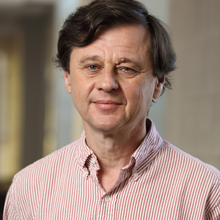
Kolomeisky Work Earns Editor's Suggestion
What do charge oscillations in conductors and expansion of the physical Universe have in common? More than meets the eye! This Editor's Suggestion, https://link.aps.org/doi/10.1103/PhysRevB.100.140301, shows that a collection of identical charged particles in the presence of a uniform compensating background charge can evolve as if they were part of an expanding or contracting homogeneous and isotropic Universe with the "wrong" sign of interaction: while gravity is attractive, the charges repel each other. Otherwise, the equations of motion are exactly the cosmological equations of the general theory of relativity.
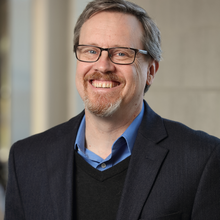
Paschke Elected a Fellow of the American Physical Society
Dear Colleagues,
Please join me in congratulating Kent Paschke on his election to APS Fellowship! Each year, no more than one half of one percent of the Society membership is recognized by their peers for election to the status of Fellow in the American Physical Society.
This is a very well-deserved honor for Kent. He was nominated by the Division of Nuclear Physics and his citation reads:
“For using parity violation in electron scattering to study the structure of the nucleon and nuclei and the physics beyond the standard model, and for achieving unprecedented control over helicity-correlated systematic errors associated with polarized electron beams.”
Best Wishes,
Bob

Applying Machine Learning to enhance magnetocaloric materials
Abstract:
We present a data-driven approach to predict entropy changes (ΔS) in small magnetic fields in single-molecule magnets (SMMs) relevant to their application as magnetocaloric refrigerants. We construct a database of SMMs with a representation scheme incorporating aspects related to dimensionality, structure, local coordination environment, ideal total spin of magnetic ions, ligand type, and linking chemistry. We train machine learning models for predicting the entropy change as a function of structure and chemistry and use the models to arrive at ΔS for hypothetical molecules. We also identify key descriptors that affect the entropy change, thus providing insights into designing tailored SMMs with improved magnetocaloric properties.
This work is highlighted by AIP Scilight:
https://doi.org/10.1063/1.5113601
See paper at:
"Machine learning accelerates design of single-molecule magnets for magnetocaloric applications", Appl. Phys. Lett. 114, 222404 (2019); Ludwig Holleis, B. S. Shivaram, and Prasanna V. Balachandran
Alumnus Troy's PhysicsBowl Team Places Second in Nation
One of our alums, Bob Troy who teaches Physics at St Anne’s Belfield in Charlottesville, led the STAB PhysicsBowl team to a 2nd place ranking in the nation and 6th place in the world. See links below to a STAB highlight and a WINA broadcast of Les Sinclair’s interview with Bob Troy.
https://wina.com/podcasts/st-annes-belfield-school-places-2nd-in-physicsbowl-dr-troy/
For more about PhysicsBowl, see https://www.aapt.org/Programs/PhysicsBowl/
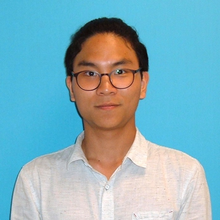
Han Receives ISO Academic Excellence Award
Jiwon "Jesse" Han is receiving the International Studies Office Graduating International Students Awards in the category for Academic Excellence.
See https://issp.virginia.edu/iso-graduation-celebration-awards
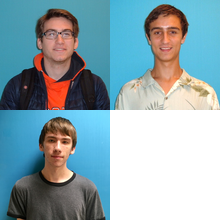
Farris, Seymour, and Winn elected to Phi Beta Kappa
Fourth year Physics majors Peter Farris, Brian Seymour, and Aaron Winn have been elected to Phi Beta Kappa, the nation's oldest and most prestigious undergraduate honors organization. The Society has pursued its mission of celebrating and advocating excellence in the liberal arts and sciences. Congratulation!
See http://college.as.virginia.edu/awardsandhonors#phi-beta-kappa
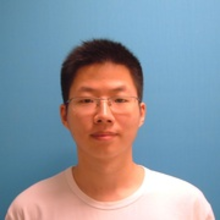
Duan Wins Gwathmey Award
Congratulations to Chunruo Duan who is the recipient of the 2019 Allan Talbott Gwathmey Memorial Award! This honor is bestowed upon the most accomplished graduate student in the physical sciences at the University of Virginia in recognition of a distinguished scholarly publication. The award includes a $7,500 cash prize and is fantastic recognition of Chunruo’s excellent work and the strength of the research efforts in our Department.
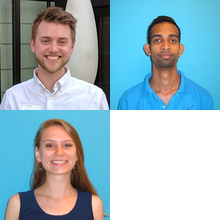
Carson and Wijayaratne Receive Graduate Teaching Awards
Zack Carson and Kapila Wijayaratne who have been recognized with university-wide graduate teaching awards! Zack is the recipient of the Distinguished Graduate Teaching Award for STEM Fields, and Kapila is a recipient of an All-University Graduate Teaching Award. Grace Cummings also received a nomination by the Department. The department is honored by, and grateful for, their outstanding teaching and commitment to their students.
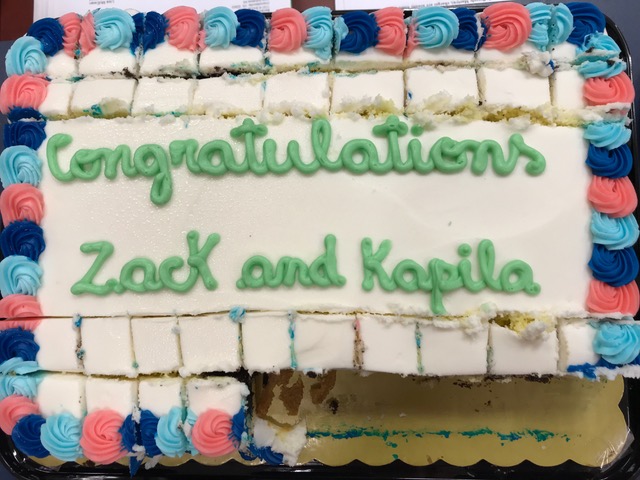

Yagi Receives 2019 Young Scientist Prize
Kent Yagi has been selected as the recipient of the 2019 Young Scientist Prize from the International Commission on General Relativity & Gravitation. Kent's citation and additional information on his prize can be found here:
http://iupap.org/commissions/affiliated-commissions/ac2-news/
This follows his recent selection as a 2019 Sloan Fellowship and is excellent additional recognition of his extraordinary work.

Yagi Named 2019 Sloan Research Fellow
Kent Yagi has been named a 2019 Sloan Research Fellow. From the Alfred P. Sloan Foundation Press Release:
“Sloan Research Fellows are the best young scientists working today,” says Adam F. Falk, president of the Alfred P. Sloan Foundation. “Sloan Fellows stand out for their creativity, for their hard work, for the importance of the issues they tackle, and the energy and innovation with which they tackle them. To be a Sloan Fellow is to be in the vanguard of twenty-first century science.”
For more, see: https://sloan.org/storage/app/media/programs/SRF/2019-SRF-Press-Release.pdf
For a nice write-up from Inside A&S , see: http://as.virginia.edu/news/astrophysicist-kent-yagi-awarded-prestigious-fellowship
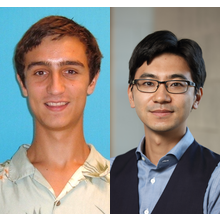
Seymour Receives Churchill Scholarship
From UVAToday:
Brian Seymour explores the universe, its black holes and pulsars. Now he can go further with the help of a Churchill Scholarship.
This fall, Seymour, a fourth-year physics and mathematics major at the University of Virginia, plans to continue his studies at Churchill College at the University of Cambridge in the United Kingdom.
Seymour is one of 15 recipients of Churchill Scholarships, valued at roughly $60,000 apiece, which fund American students’ pursuit of a master’s degree at the University of Cambridge. The program was set up at the request of Sir Winston Churchill, the British prime minister during World War II, in order to fulfill his vision of a U.S.-U.K. exchange advancing science and technology on both sides of the Atlantic and helping ensure future prosperity and security.
...
Seymour published a paper with Kent Yagi, an assistant professor in theoretical astrophysics, gravity and cosmology in UVA’s Department of Physics, testing the theories of gravity.
For the rest of the story, see https://news.virginia.edu/content/churchill-scholars-path-universe-runs-through-cambridge

UVa Physics Majors Play Key Role in Physics Teaching Initiative Serving Rural, Low-Income Communities
From UVAToday:
An innovative pilot program launched by UVA alums, now in its second year, has made significant progress in addressing the disparate access to advanced courses in rural Mississippi. The Global Teaching Project provides promising high school students in rural, low-income communities access to the advanced courses their schools otherwise could not offer, due both to a lack of resources and a chronic and worsening shortage of qualified teachers.
...
To help implement the course, Dolan turned to UVA physics department chair Bob Jones, whom Dolan knew from their days together as students on Grounds. Jones, in turn, helped recruit UVA undergraduate physics majors to serve as tutors. “I am from Louisiana, so I know the challenges these areas face,” Jones said. “We have remarkable physics students here at UVA, and I knew that their involvement would benefit these high school students immensely.”
Among the UVa Physics majors who served as tutors were: Nick Anderson, Adrien Bernard, Richard Elwell, Jake Goudeau, Vicki Huang, Megan Kenny, Martine Lokken, Dominic Pinnisi, Steven Stetzler, Mansoor Syed, Sam Umbaugh, and Emma Yeats.
For full story, see https://news.virginia.edu/content/alum-effort-provides-advanced-high-school-courses-where-need-greatest
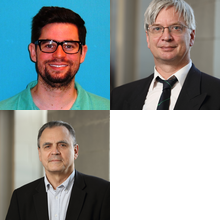
First Observation of the Parity-Violating Gamma-Ray Asymmetry in Neutron-Proton Capture
The weak interaction of quarks between the neutron and proton have been measured for the first time by the NPDGamma experiment at the Spallation Neutron Source in Oak Ridge National Lab. UVa postdoctoral research associate Jason Fry played a leading role in the experiment along with professors Stefan Baeßler and Dinko Počanić and students. This measurement can help us understand the interplay between the strong and weak interactions in hadronic systems.
For further reading, please see the Editor's Suggestion in Physical Review Letters:
https://journals.aps.org/prl/abstract/10.1103/PhysRevLett.121.242002

UVa Hosts "Femtography" Symposium
A Symposium on Imaging and Visualization in Science was held at the University of Virginia December 10-11, 2018. This symposium brought together scholars and researchers from Virginia universities and research institutes to discuss recent developments and future opportunities in the imaging and visualization of scientific data.
A major goal of this Symposium was to establish collaborations for future research related to the Virginia Center for Nuclear Femtography. The Commonwealth of Virginia has funded the establishment of a Center for Nuclear Femtography (CNF) to facilitate the application of modern developments in data science to the problem of imaging and visualization of sub-femtometer scale structure of protons, neutrons, and atomic nuclei. The Center will enable collaboration of nuclear scientists from Jefferson Lab and a broad and diverse set of faculty and researchers at Virginia universities, with benefits to both nuclear femtography and other disciplines or areas of research. A near-term goal of this symposium will be to establish collaborations in preparation for a program of summer visitors and exchanges in 2019 that will be the initial phase of the CNF. The 2019 summer program will be funded using the Commonwealth funds for CNF, and will include summer salary for faculty as well as support for postdoctoral researchers and students. Planning the nature and scope of the funded activities were topics that were discussed at the Symposium.
The Symposium's local organizing committee was chaired Prof. Simonetta Liuti, who was also a member of the program committee.
For more information, see: https://pages.shanti.virginia.edu/Femtography/
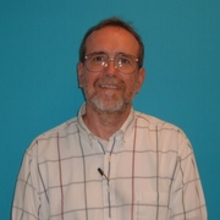
Gillies Named Fellow of National Academy of Inventors
George Gillies, UVa Physics PhD and recently Visiting Research Professor of Physics, has been inducted into Fellowship in the National Academy of Inventors.
From UVAToday:
The academy lauded Gillies, who holds 36 U.S. patents on several medical devices for neurosurgery and cardiology, for demonstrating “a highly prolific spirit of innovation in creating or facilitating outstanding inventions that have made a tangible impact on quality of life, economic development and the welfare of society.”
...
Gillies is a fellow of the American Physical Society, the American Institute of Medical and Biological Engineers and the Institute of Physics. He also is a senior member of the Optical Society of America, a life senior member of the Institute of Electrical and Electronic Engineers and an associate member of the American Association of Neurological Surgeons.
For full story, see https://news.virginia.edu/content/engineer-george-gillies-named-fellow-national-academy-inventors
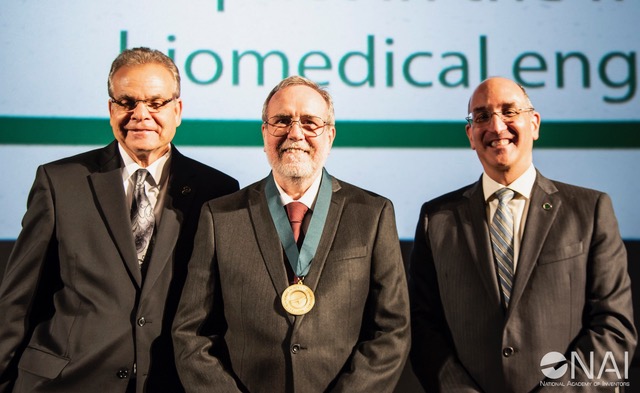
George Gillies at the National Academy of Inventors Fellows Induction Ceremony, Johnson Space Center, Houston, Texas, April 11, 2019

Lee Co-organized the Inaugural UVA Symposium on Korea
Seung-Hun Lee co-organized the inaugural UVA Symposium on Korea as a part of his Pavilion Seminar, “Science & Politics.” During the Symposium, which was held in September, three leading experts on Korea -- Professor Paik, Nak-chung from Korea, Professor Philip Zelikow from University of Virginia, and Professor Jae-Jung Suh from Japan -- delivered presentations to shed light on the recent policy changes between the United States and North Korea. The conference was well attended by students, faculty members, and the general public. For the full report, please click here:
http://eastasiacenter.as.virginia.edu

UVa Quartet At The Center Of Efforts To Gain U.S. Edge
UVAToday has a nice article highlighting UVa's expertise in quantum optical physics and photonics engineering:
A University of Virginia physics professor and three UVA engineering professors are members of three new multi-disciplinary, multi-university teams that are seeking new understanding of quantum science for the development of practical, extremely high-tech tools – including the long-dreamed-of and sought-after quantum computer.
...
Physics professor Olivier Pfister is the principal investigator for one of the teams, with a mission to develop integrated “quantum photonics” on a computer chip, allowing light beams in mini-circuits to be used for quantum computing. The team includes electrical and computer engineering professors Joe Campbell, Andreas Beling, and Xu Yi. They are operating on a $750,000 NSF grant.
See full article at https://news.virginia.edu/content/quantum-challenge-uva-quartet-center-efforts-gain-us-edge
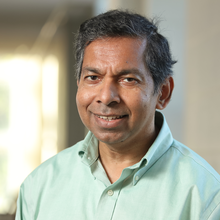
New Clues to the Proton Puzzle
UVa Physics professor Nilanga Liyanage and his colleagues in the PRad collaboration have made a new measurement of the proton's radius. Other experiments have arrived at two different, incompatible values for this radius. The new value derived from PRad data is consistent with the smaller of these values.
Prof. Liyanage described the new work in an invited talk at the 5th Joint Meeting of the APS Division of Nuclear Physics and the Physical Society of Japan, held in Waikoloa, Hawaii this October. The PRad results are the subject of a story in Science News:
https://www.sciencenews.org/article/new-measurement-bolsters-case-slightly-smaller-proton
The PRad work was done at Jefferson Lab in Newport News, Virginia.
Fall 2018 Physics Newsletter
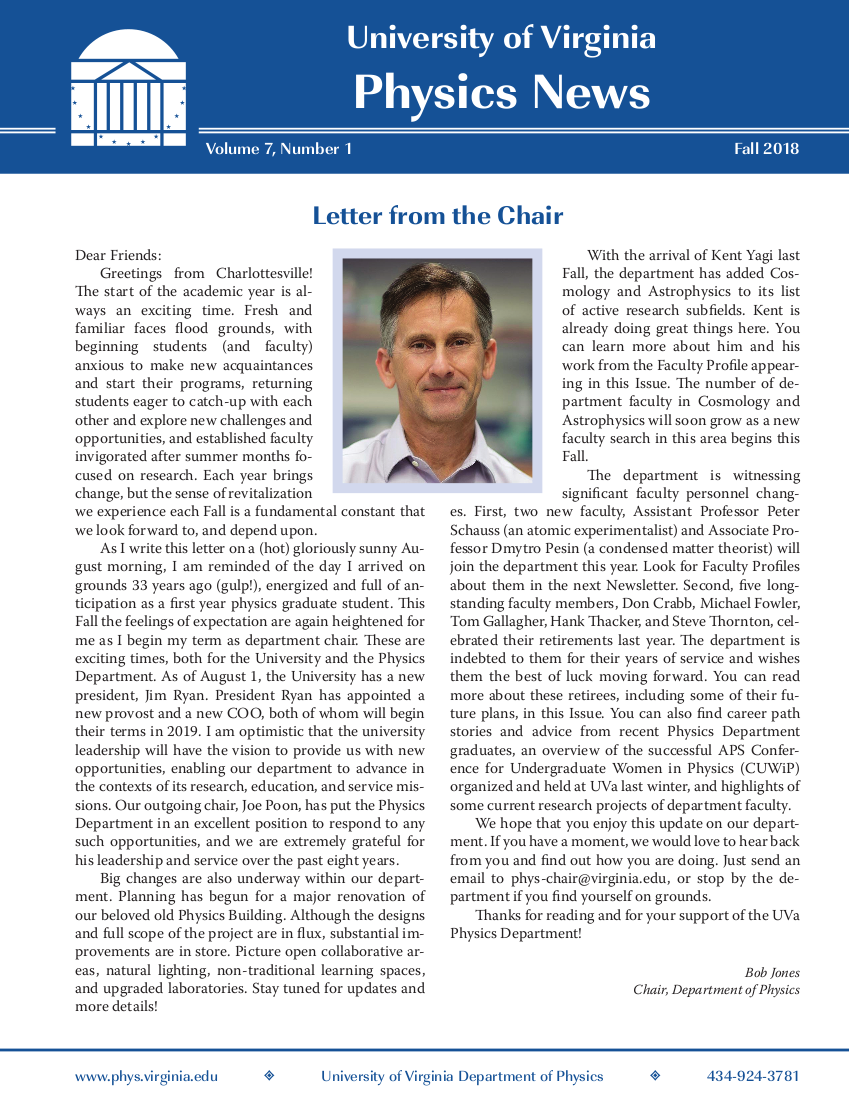 The current edition of our departmental newsletter features a message from our new Chair, Bob Jones, a profile of new faculty member Kent Yagi, profiles of some recent graduates, and a report on the Conference for Undergraduate Women in Physics. You can read the newsletter here:
The current edition of our departmental newsletter features a message from our new Chair, Bob Jones, a profile of new faculty member Kent Yagi, profiles of some recent graduates, and a report on the Conference for Undergraduate Women in Physics. You can read the newsletter here:
http://www.phys.virginia.edu/Announcements/Newsletter/Vol07Num01.pdf
You can find older newsletters here.
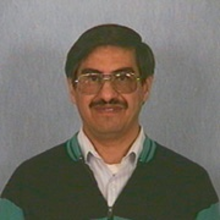
Oscar A. Rondon Aramayo Elected to APS Fellowship
Oscar A. Rondon Aramayo, a recently retired Principal Scientist from the UVa Institute of Nuclear and Particle Physics (INPP) has been elected as a 2018 Fellow of the American Physical Society (APS). His citation reads:
“For pioneering contributions to the study of quark-gluon correlations in nucleons using inelastic scattering of polarized electrons off transverse polarized proton and deuteron targets to measure the nucleon transverse spin asymmetry A2 and the associated structure function gT and its moments.”
Congratulations Oscar!
For more information on APS Fellowship see: https://www.aps.org/programs/honors/fellowships/
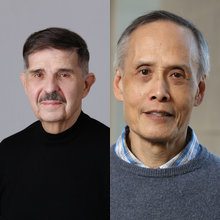
Cox and Poon Highlighted in UVAToday Story on Dozen Top Science Discoveries
Brad Cox's work on the discovery of the Higgs boson and Joe Poon's work on amorphous "super steel" is celebrated in a UVAToday story on UVA's top twelve notable science discoveries of the last half-century.
Full story: https://news.virginia.edu/content/what-are-uvas-top-12-science-discoveries-past-half-century
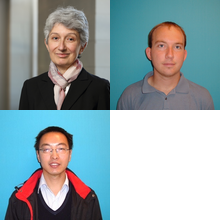
Louca Group Work Highlighted By AIP
Despina Louca’s group, and in particular graduate student Aaron Wegner and postdoctoral researcher Junjie Yang, has discovered a way to boost the magnetoresistance in the I-Mn-V class of semiconductors, the highest ever observed in this class, that may make it well-suited as a magnetic electrode in room-temperature spintronics-based devices.
This work is highlighted by AIP Scilight:
https://aip.scitation.org/doi/10.1063/1.5058147

Schauss a Regional Finalist for Blavatnik Award
Peter Schauss was selected as a 2018 Blavatnik Awards for Young Scientists Regional Finalist.
The Blavatnik Awards for Young Scientists honor exceptional young scientists and engineers by celebrating their extraordinary achievements, recognizing outstanding promise, and accelerating innovation through unrestricted funding.
For more, see http://blavatnikawards.org/honorees/profile/peter-schauss/

Physics in Orbit
UVa Physics professor Cass Sackett is testing gravity and quantum mechanics in space using the Cold Atom Laboratory (CAL), a device aboard the International Space Station. His work is described in the current edition of UVa Today:
"Using lasers and magnets to control atoms in a vacuum chamber, the cooler-sized lab allows Sackett and an international team of colleagues to do in space (remotely, from Earth) what can’t be done on the Blue Planet – that is, conduct sustained experiments into how matter at the most fundamental level operates in “microgravity” conditions under ultra-cold temperatures. That can’t be done so well from Earth because the strong gravity of our planet affects the motions of atoms, the subject of interest in CAL experiments."
See the full article here: https://news.virginia.edu/content/cold-and-remote-uva-physicist-takes-cool-quantum-research-space

Waddy, Walker, and Schult Report on April APS Meeting
A report written by physics undergraduates Morgan Waddy, Matt Walker, and Levi Schult on a trip that they took to the American Physical Society April Meeting last year was published on the national Society of Physics Students website at https://www.spsnational.org/meetings/meeting-notes/weekend-columbus and in Volume XXVII Issue 1 of SPS's Journal of Undergraduate Reports in Physics (JURP) magazine.
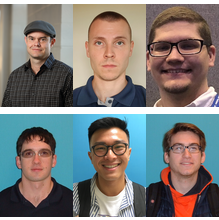
UVA Physics Shines at VT Conference
On August 13-18 the 20th International Workshop on Neutrinos from Accelerators was held at Virginia Tech. The UVA HEP group took advantage of proximity to UVA and attended in full force, taking 6 poster and giving 4 talks. Prof. Craig Group convened the Muon Physics Working group and presented an Introduction and Summary of this physics in the conference plenaries. Joining him on the trip were two graduate students and four undergraduate students. There were six posters documenting the group’s efforts toward designing, prototyping, and fabricating a cosmic ray veto system for the Mu2e experiment at Fermilab. (see image: Graduate student Steve Boi, and undergraduates Ben Barton, Danny Mills, Ningshun Chen, and Peter Farris – from left to right. Not shown in the photo is Andrew Sutton, a graduate student who presented a poster regarding his work on the NOvA experiment.)
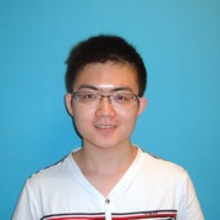
Chen Wins NIST Postdoctoral Fellowship
Tianran Chen won a NIST Director’s Postdoctoral Fellowship for foreigners that is equivalent to the prestigious NRC postdoctoral fellowship for US citizens. He is moving to NIST late August in 2018
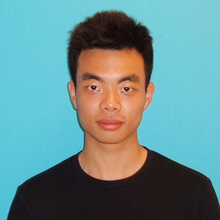
Shen wins Lawrence Harrison Kilmon and May Lewis Kilmon Scholarship
The physics department congratulates Lingnan Shen for being selected as a recipient of the Lawrence Harrison Kilmon and May Lewis Kilmon Scholarship for outstanding academic achievement. It is one of the highest forms of recognition bestowed by the College.
For more about the College of Arts & Sciences Deans' Scholarships, see
http://college.as.virginia.edu/scholarships
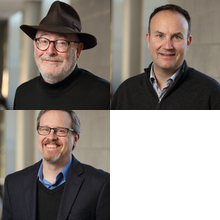
UVa Physicists Probing Ever Deeper Into The Stuff Of The Universe
UVAToday has a nice article highlighting UVa's contributions to recent results in particle physics:
University of Virginia physicists have recently played key roles in new particle physics discoveries. The scientists are involved with large international collaborations using major facilities designed for expanding our knowledge of the most intimate details of how the smallest known pieces of atoms may have given birth to the universe.
The research projects are led at UVA by physicist Craig Dukes, working with the U.S. Department of Energy’s Fermi National Laboratory in Illinois; Chris Neu, who works with the Large Hadron Collider in Europe; and Kent Paschke, who works with the DOE’s Thomas Jefferson National Accelerator Facility, or Jefferson Lab, in Newport News.
See full article at https://news.virginia.edu/content/uva-physicists-probing-ever-deeper-stuff-universe
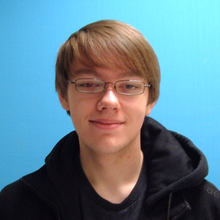
Stetzler Awarded DOE Computational Science Graduate Fellowship
Graduating student, Stephen Stetzler, was one of 20 students awarded the DOE Computational Science Graduate Fellowship. The DOE CSGF program provides outstanding benefits and opportunities to students pursuing doctoral degrees in fields that use high-performance computing to solve complex science and engineering problems. Steven will join the Astrophysics Ph.D. program at the University of Washington this fall.
You can learn more here: https://www.krellinst.org/csgf/

First observation of Higgs boson-top quark interactions at CERN's CMS Experiment
The discovery of the Higgs boson in 2012 was an important breakthrough in understanding the tiniest building blocks of our universe. Since then, the focus has shifted to measuring the properties of the Higgs boson in order to determine if this new particle is consistent with our current best model of the fundamental world -- or something much more exotic. The most crucial characteristic to be measured is the interaction strength between the Higgs boson and the most massive of the known fundamental particles -- the top quark.
Researchers at the CMS Experiment operating at the Large Hadron Collider have recently made the first observation of the interaction between the Higgs boson and the top quark. The effort was led by UVa Physics faculty member Chris Neu, who is an international expert in Higgs boson and top quark physics. He and his students and postdocs have been pursuing this elusive top-Higgs signature since 2011, including recent UVa PhD recipient John Wood ('15), current PhD student Evan Wolfe and postdocs Sarah Boutle, Tutanon Sinthuprasith and Ben Tannenwald. Many undergraduates contributed to background studies as well, including Eric Culbertson ('17), Gage DeZoort ('18), Catherine Jones ('15), Andrew Orvedahl ('18), Rachael Sproule ('17), and Chris Wiens ('17).
The article was recently published in Physical Review Letters here [1] and the result is discussed as the PRL Editor's Recommendation [2], as well as in the Fermilab News here [3] and Symmetry Magazine[4].
[1] https://link.aps.org/doi/10.1103/PhysRevLett.120.231801
[2] https://physics.aps.org/articles/v11/56
[3] http://news.fnal.gov/2018/06/who-gets-their-mass-from-the-higgs/
[4] https://www.symmetrymagazine.org/article/the-perfect-couple-higgs-and-top-quark-spotted-together

Charged impurities in a conducting sheet can cause a new kind of wake in the current pattern
The wake behind a boat and the ripples caused by rocks in a stream are both due to the relative motion of a fluid and an obstacle, which gives rise to wave patterns on the surface. A recent Physical Review Letter "Kelvin-Mach wake in a two-dimensional Fermi sea" explores how charged impurities can cause similar effect of uneven currents on a conducting surface such as a graphene sheet. The wake pattern is different from the familiar cases because the relationship between surface wave speed and wavelength is different, with the result that both the Mach "sonic boom" wake (whose opening angle depends on the speed of the moving object) and the Kelvin wake behind a boat (whose opening angle is independent of the speed of the boat) can occur as limiting cases. The diagram shows an example of a wake pattern (the lines represent wave crests, the blue and green shaded regions are Kelvin- and Mach-like, respectively). The understanding of this effect could be important in the engineering of electronic devices in cases where the scattering of electrons is small, so that their flow is described by a kind of hydrodynamics.
"Kelvin-Mach Wake in a Two-Dimensional Fermi Sea", Eugene B. Kolomeisky and Joseph P. Straley, Phys. Rev. Lett. 120, 226801 – Published 31 May 2018
See paper at https://doi.org/10.1103/PhysRevLett.120.226801
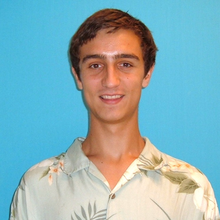
Seymour Receives Astronaut Scholarship
From UVAToday:
Brian C. Seymour of Ruckersville, a rising fourth-year student at the University of Virginia double-majoring in physics and mathematics, has received an Astronaut Scholarship, which is designed to encourage students in the sciences.
Seymour’s research focus stems from his fascination with gravity.
“Gravity is the enigma of modern theoretical physics, so I wanted to work on testing it,” he said. “General relativity is a theory of gravity that generalizes Newtonian gravity, and it describes gravity as a curvature of spacetime. So far, general relativity has passed all tests with flying colors, but there are many reasons to consider theories beyond general relativity. I have been working on testing general relativity with compact astrophysical binaries.”
For more, see https://news.virginia.edu/content/gravity-fascinates-latest-astronaut-scholar
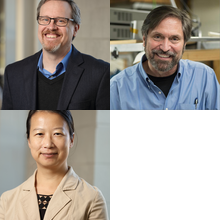
Results from Jefferson Lab's Qweak experiment published in Nature
The weak charge of the proton has been measured to high precision, for the first time, by the Q-weak experiment at the Department of Energy’s Thomas Jefferson National Accelerator Facility (Jefferson Lab). UVa Associate Professor of Physics Kent Paschke played a leading role in this experiment. Another faculty member, Gordon Cates, was also involved.
Xiaochao Zheng wrote an accompanying News and Views article. [She donated the $130 honorarium to SPS.]
For further reading please see:
https://www.nature.com/articles/s41586-018-0096-0
and the News and Views article:
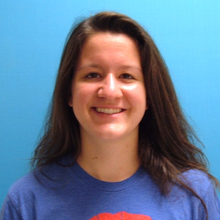
Bridget Andersen Featured in UVaToday Series on Class of 2018
Astronomy/Physics major Bridget Andersen is featured in an article in this week's edition of UVaToday.
From UVaToday:
“Even though Bridget chose to specialize in astronomy for her research, she also took the toughest physics courses and excelled in them, not only with regard to scores, but first and foremost in terms of mastering difficult concepts such as the foundations of quantum physics,” physics professor Olivier Pfister said. “She is the student who consistently asks, and answers, the toughest questions and relishes the most challenging assignments.”
For more, see:

Sutton Receives DOE SCGSR Fellowship
UVa physics graduate student, Andrew Sutton, was one of only four students in the country who received the prestigious DOE Office of Science Graduate Student Research fellowships to conduct their research at Fermilab.
The program goal is to prepare graduate students for science careers important to the DOE Office of Science mission. The program provides graduate thesis research opportunities at DOE laboratories. Andrew will work closely with his advisor, Prof. Craig Group, and post-doctoral researcher Michael Baird along with Fermilab scientists to make important contributions to the NOvA neutrino experiment. The award includes a generous one-year living stipend and funds for relocation to Fermilab.
Fermilab Press Release: http://news.fnal.gov/2018/04/four-students-awarded-doe-graduate-student-research-fellowships/

Tianran Chen Wins 2018 Allen Talbott Gwathmey Memorial Award
Tianran Chen is a recipient of the 2018 Allan Talbott Gwathmey Memorial Award. The Gwathmey award is an honor reserved for the most accomplished graduate students in the physical sciences at the University of Virginia in recognition of a distinguished scholarly publication.
The award acknowledges his recent work, “Origin of Long Lifetime of Band-Edge Charge Carriers in Organic-Inorganic Lead Iodide Perovskites”, published in Proceedings of National Academy of Sciences 114, 7519-7524 (2017).
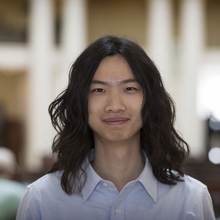
Li Receives Goldwater Scholarship
From UVAToday:
University of Virginia students Chris Li and Sebastian Haney have received scholarships from the Barry M. Goldwater Scholarship and Excellence in Education Foundation for 2018. Two other UVA students received honorable mentions.
Li, of Las Vegas, a third-year physics and mathematics double-major, is currently investigating gravity as an emergent phenomenon of quantum field theory under certain special conditions.
“Gravity, at least as envisioned by Einstein, is incompatible with quantum physics,” Li said. “This is a major issue in theoretical physics. The search for a resolution has attracted many physicists across generations. Such resolution could have an enormous impact on our understanding of the universe from subatomic to cosmological scale.”
For more, see https://news.virginia.edu/content/goldwater-scholarships-propel-uva-students-exploration-math-and-physics
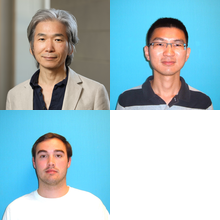
Origin of vertical orientation in two-dimensional metal halide perovskites and its effect on photovoltaic performance
Thin films based on two-dimensional metal halide perovskites have achieved exceptional performance and stability in numerous optoelectronic device applications. Simple solution processing of the 2D perovskite provides opportunities for manufacturing devices at drastically lower cost compared to current commercial technologies. A key to high device performance is to align the 2D perovskite layers, during the solution processing, vertical to the electrodes to achieve efficient charge transport. However, it is yet to be understood how the counter-intuitive vertical orientations of 2D perovskite layers on substrates can be obtained.
Recently, the team of University of Virginia made of Chemical Engineer Josh Choi’s group and Physicist Seung-Hun Lee’s group reports a formation mechanism of such vertically orientated 2D perovskite in which the nucleation and growth arise from the liquid–air interface. As a consequence, choice of substrates can be liberal from polymers to metal oxides depending on targeted application. They also demonstrate control over the degree of preferential orientation of the 2D perovskite layers and its drastic impact on device performance.
Origin of vertical orientation in two-dimensional metal halide perovskites and its effect on photovoltaic performance, Alexander Z. Chen, Michelle Shiu, Jennifer H. Ma, Matthew R. Alpert, Depei Zhang, Benjamin J. Foley, Detlef-M. Smilgies, Seung-Hun Lee & Joshua J. Choi, Nature Communication 9, 1336 (2018).
Link: https://www.nature.com/articles/s41467-018-03757-0
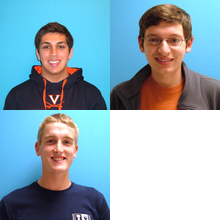
Gupta, Lee, McMullen elected to Phi Beta Kappa
Fourth year Physics majors Arvind Gupta, Kevin Lee, and Timothy McMullen have been elected to Phi Beta Kappa. Congratulations!
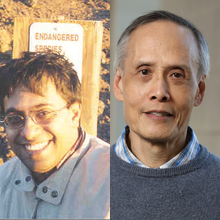
Ghosh, Poon, et al. Receive DARPA Funding To Shrink Computing Memory
From UVAToday:
In a case of “smaller is better,” a team of University of Virginia researchers has received a $3.4 million grant from Defense Advanced Research Projects Agency with the goal to shrink computing memory bits to a nanoscale.
Using tiny magnetic structures called ”skyrmions,” researchers hope to reduce the amount of energy needed to move memory bits and expand memory capabilities in the same amount of space.
The UVA team consists of lead principal investigator Avik Ghosh, a professor in the Department of Electrical and Computer Engineering and Department of Physics; Joseph Poon, William Barton Rogers Professor of Physics and chair of that department; Prasanna Balachandran, assistant professor in the Department of Materials Science and Engineering; and Mircea Stan, a professor in the Department of Electrical and Computer Engineering. Other co-principal investigators include Professor Geoffrey Beach at the Massachusetts Institute of Technology and Professor Andrew Kent in New York University. The program kicked off earlier this month.
For the full story, see https://news.virginia.edu/content/researchers-received-darpa-funding-shrink-computing-memory
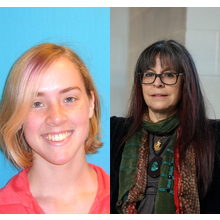
UVa Hosts Conference for Undergraduate Women in Physics
The following article describes the APS Conference for Undergraduate Women in Physics (CUWiP), hosted by UVa in January 2018.
Female Physics Students Unite at UVa
By Martine Lokken
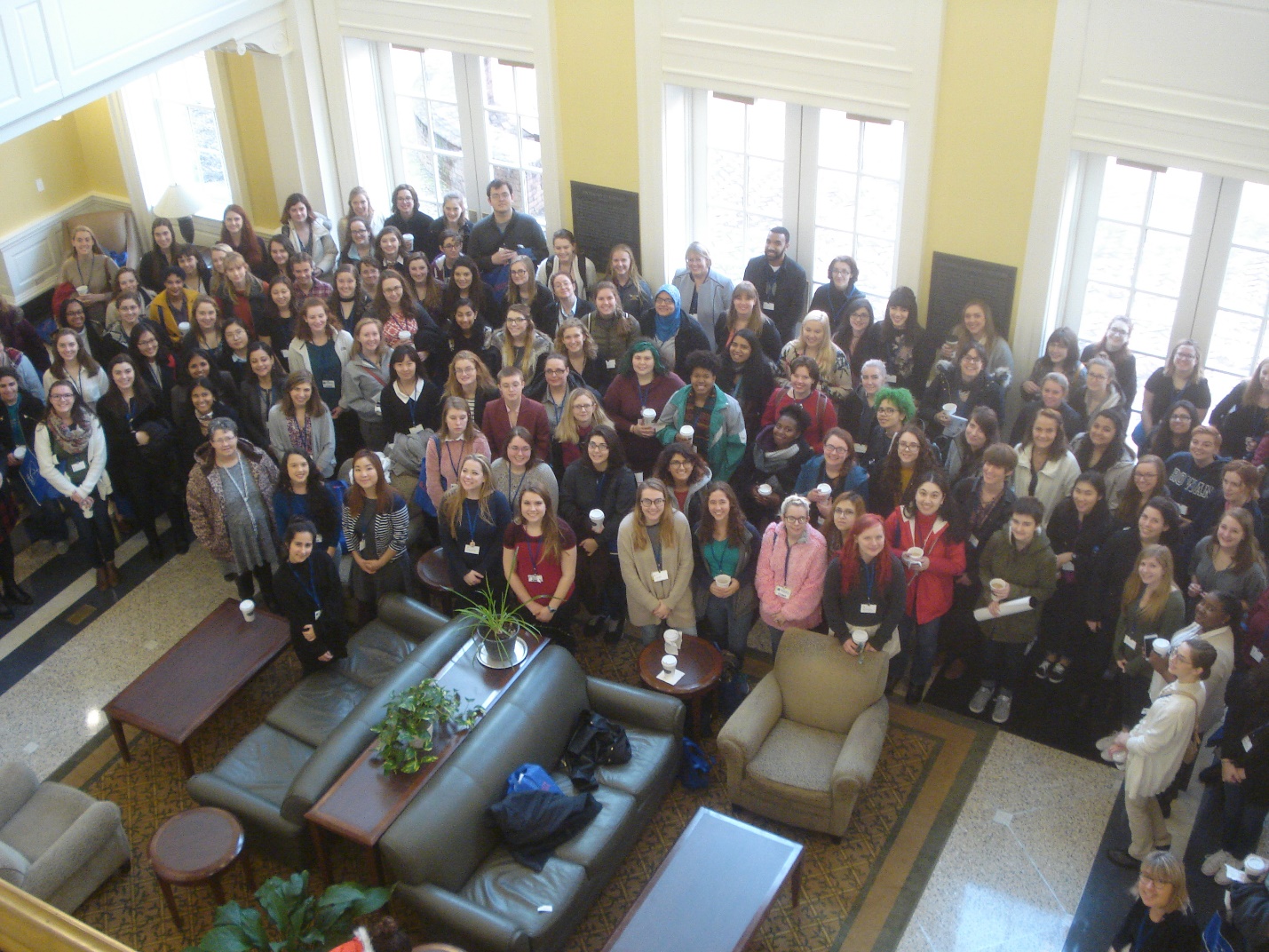
Saturday morning group photo of Conference attendees taken in the atrium of Bavaro Hall. (Photo by Bryan Wright)
The University of Virginia grounds buzzed with excitement over the Martin Luther King Jr. weekend as hundreds of female physics enthusiasts came together with shared goals in mind: to foster camaraderie, find inspiration in each other, and look towards the future of the field.
This year was UVa’s turn to host one of the annual Conferences for Undergraduate Women in Physics (CUWiP). Sponsored by the American Physical Society, UVa’s CUWiP was one of twelve sister conferences held simultaneously across the United States. The conferences aim to cultivate community among female undergraduate physics majors, who earn only ~19% of conferred degrees, a number that has been in decline over the past decade (APS Education Statistics, 2015). The conference was organized by UVa physics professor Simonetta Liuti, as well as a large team of faculty, staff, and students across multiple departments.
A special pre-event, SPIN-UPx, was also held at UVa to promote diversity in Science, Technology, Engineering and Mathematics (STEM). This event, led by Rachel Spraker (Compliance Director for Equality and Affirmative Action at UVa), supported the inclusion of members of racial, ethnic, gender and sexual minorities; students with physical, mental, and learning disabilities; first-generation college students and those from low income backgrounds.
One hundred thirty-nine undergraduates from forty-four colleges and universities across Virginia, West Virginia, North Carolina, Kentucky, Tennessee, Maryland, New Jersey, and even Nova Scotia came to discuss future careers, talk about hot research topics, and forge new connections. Female graduate students, professors, researchers, lab directors and other professionals were there to give their personal advice on how to succeed in physics.
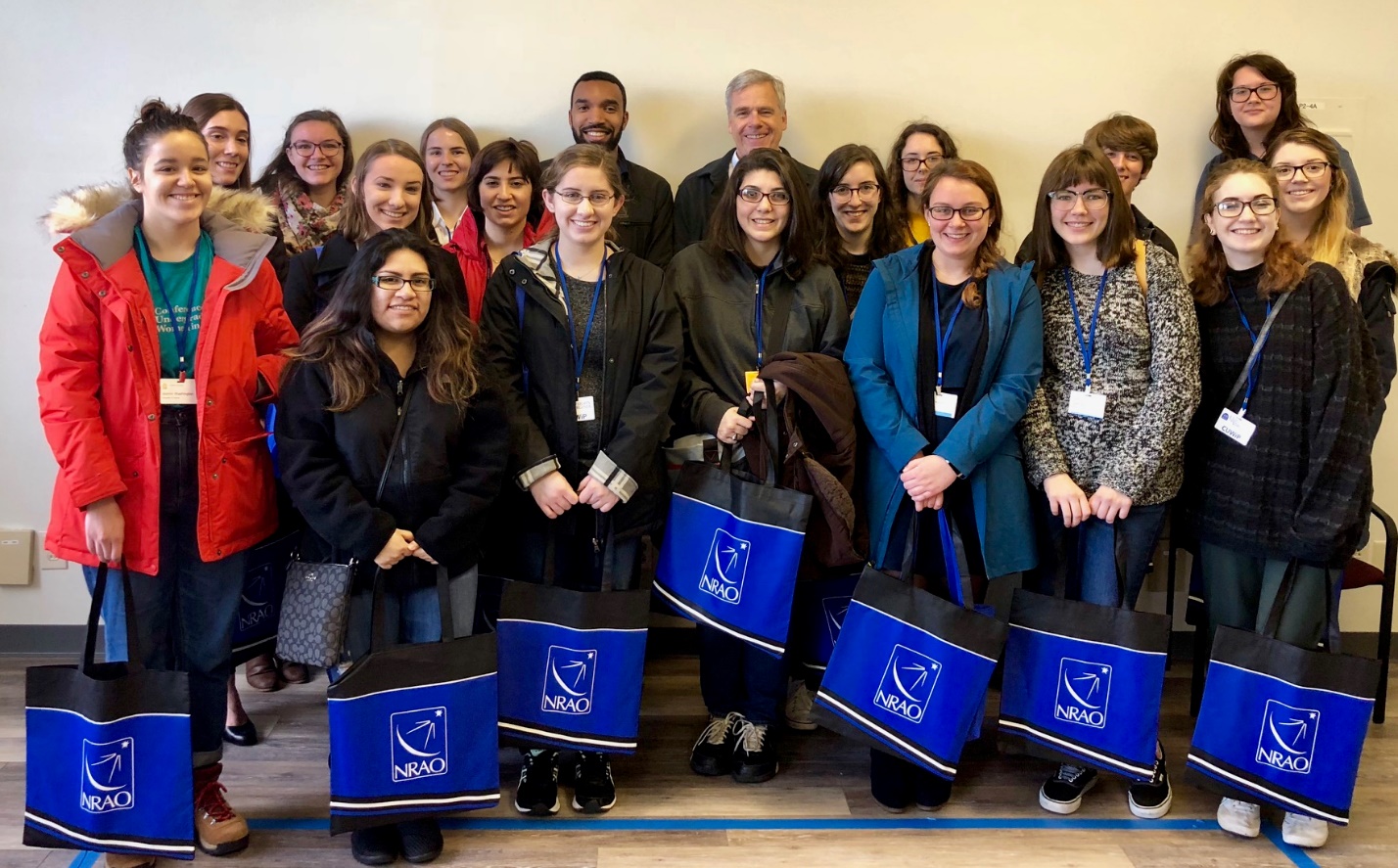
Students attending the National Radio Astronomy Observatory headquarters tour. (photo by Nan Janney)
One highlight of the conference was a morning of laboratory tours. Included were the UVa physics department (Condensed Matter Physics: Prof. Despina Louca, Nuclear Physics: graduate student Chris Jantzi, High Energy Physics: Prof. Craig Dukes, Atomic Physics: Prof. Tom Gallagher), a discussion of Nuclear Theory by graduate student Abha Rajan, as well as tours of the Materials Science Department, the National Radio Astronomy Observatory headquarters, and UVA’s medical facilities. For example, Dr. Krishni Wijesooriya led a tour of the Emily Couric Cancer Center while teaching students about the physics behind radiation oncology. The group got a sneak-peek at life in the center by meeting staff, examining the technology, and even watching as a patient was imaged by a CT scanner. Dr. Wijesooriya talked about some of her own innovations in the field of medical physics, and encouraged the visitors to “think big”: after all, she noted, Marie Curie won not just one, but two Nobel Prizes for her work in physics and chemistry.
Clearly, the undergraduates were already thinking big, which they proved at Saturday’s poster session. Thirty-two research posters were presented, detailing projects in particle physics, biological physics, astrophysics and condensed matter. During the session, not only were the presenters able to improve their research communication skills, but the other attendees also had the chance to learn how to get involved in undergraduate research. The first-place poster prize went to Kayla Callaway of Rowan University for her research entitled “Tunable CdS quantum dots synthesized by reverse micelles.”
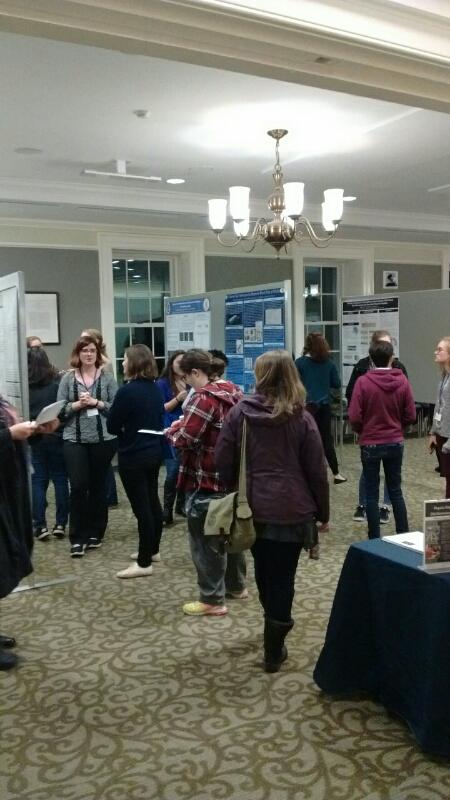
Saturday evening poster session. (Photo by Bryan Wright)
Other memorable components of the conference included talks by established professionals in physics and astronomy fields. Keynote speakers Prof. Elizabeth H. Simmons (Executive Vice Chancellor, UC San Diego) and Prof. Shohini Ghose (Wilfrid Laurier University) shared their personal journeys and paid homage to great, yet under-recognized, female physicists of the past. Prof. Ghose told the story of Cecilia Payne-Gaposhkin, who discovered that the Sun was primarily composed of hydrogen and helium but whose conclusion was not believed until her male colleagues confirmed the result.
Many speakers at the conference shared their own stories of how they overcame challenges. Dr. Kelsey Johnson, who spoke on Saturday, is the picture of success for an astronomer. To name a few of her accomplishments, she has made notable discoveries in the field of star formation, is on the advisory committee for the upcoming James Webb Space Telescope, and teaches highly popular astronomy classes at UVa. At CUWiP, however, she revealed that her path was not easy. Professor Johnson grew up very poor – the “not knowing if there will be heat or electricity or a working toilet kind of poor,” she explained. In poverty, and with a single mother, studying astrophysics was not the most obvious of career choices. However, she shared that the hardships in her life made her determined to figure out her place in the universe. Her story clearly struck a chord with the audience. “I loved how she emphasized that through struggle comes great strength, and rather than allowing setbacks or struggles to define you, you can use them to motivate you to do better and be better,” said first year UVa physics major Sydney Macon.
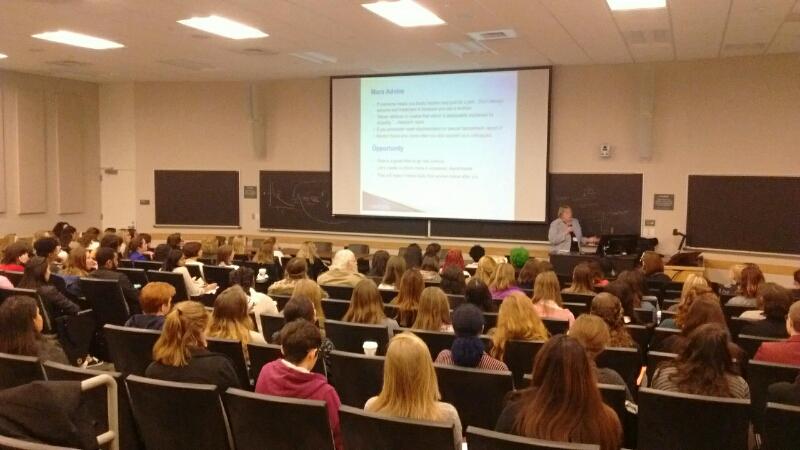
Talk given by Gail Dodge, Dean of the College of Sciences at Old Dominion University and
researcher at the Thomas Jefferson National Accelerator Facility. (Photo by Bryan Wright)
On Sunday, CUWiP attendees had a chance to discuss their own successes, setbacks and aspirations in small ‘breakout sessions.’ These included discussions about coping with imposter syndrome, maintaining a work-life balance, finding research opportunities, and many more. The sessions found a balance between acknowledging the issues facing women in physics fields and developing strategies to achieve career goals, overcome set-backs, maintain a positive attitude and move past difficulties during the course of one’s career.
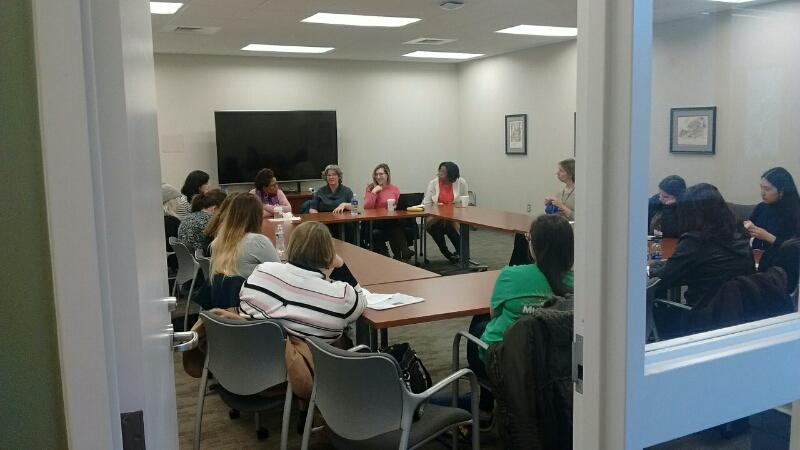
Stephanie Moore, of UVa's Curry School of Education, leading a session on Resilience and Work-Life Balance. (Photo by Bryan Wright)
Overwhelmingly positive feedback from both attendees and invited speakers suggests that the conference was a huge success, inspiring and supporting young female physicists across the mid-Atlantic region. Undergraduate students left CUWiP having forged new connections, gained advice, and drawn inspiration from the personal stories of many successful women. Megan Kenny, a second year astrophysics major at UVa, spoke highly of the experience: “I found the conference really empowering in that the talks, discussions, and activities collectively explored the advantages of being a woman in the field as much as the difficulties, showed the spectrum of paths that one can take after a physics degree, and gave us attendees confidence in driving our own careers and making whatever decisions feel right.”
After the success of the conference, the CUWiP organizing committee will continue to work towards increasing diversity in physics. If you have questions, comments, or ideas, please e-mail [email protected]. Here’s to a future of equal opportunities, mutual support, and innovation in physics.
Acknowledgements: CUWiP with SPIN-UPx was organized by a multi-disciplinary group of faculty and students at UVa spanning the departments of Physics, Astronomy, Materials Science and Engineering, and the National Radio Astronomy Laboratory. CUWiP sponsors include the National Science Foundation, the Department of Energy, UVa’s Department of Physics, the Society for Physics Students, Sigma Xi, Jefferson Science Associates, LLC, Old Dominion University Department of Physics, the Department of Materials Science and Engineering, the Office of Diversity and Engagement in the School of Engineering and Applied Science, UVa’s Astronomy Department, the National Radio Astronomy Laboratory, UVa’s Parents’ Fund, and New Sky Capital (Dr. Stefania Perrucci). We thank all of our academic and industrial speakers who volunteered time to speak at SPIN UPx and CUWiP.
More information about the event, such as speakers, sponsors, and a photo gallery, can be found at http://cuwip.phys.virginia.edu.
Martine Lokken is a 4th-year Astronomy-Physics major at the University of Virginia. She intends to start graduate studies next year in the field of theoretical cosmology.
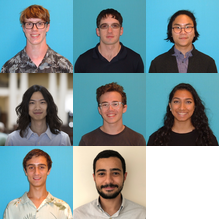
2018 Mitchell Summer Research Scholarships Awarded
Every year, the Physics Department awards six to ten Mitchell Summer Fellowships to rising third or fourth year declared physics majors. The awards are currently $5,000, for summer research with a faculty member of the department. For summer 2018, the following awards have been made:
Nick Anderson to work with Prof. Hirosky on new more sensitive light detector chips to be used at CERN.
Ben Barton to work with Prof. Group on a cosmic ray detector to monitor an experiment at Fermilab.
Colin Crovella to work with Prof. Baessler, at the Laue-Langevin Institute in Grenoble, France, on ultracold neutron detection.
Xiaochuan Ding to work with Prof. Pocanic on neutron beta decay, an experiment at Oak Ridge Lab.
Jiwan (Jesse) Han to work with Prof. Cox at CERN, upgrading one of the major detectors.
Chris Li to work with Prof. Vaman, on understanding the fundamentals of gravity, a major unsolved problem in physics.
John (Charlie) Maier to work with Prof. Teo on the properties of bilayer graphene, a fascinating new material.
Ruhi Pavartam to work with Prof. Neu, upgrading a major detector at CERN.
Ephraiem Sarabamoun to work with Prof. Shivaram search for room temperature metamagnets.
Brian Seymour to work with Prof. Yagi, probing fundamentals of general relativity, analyzing binary pulsar observations.
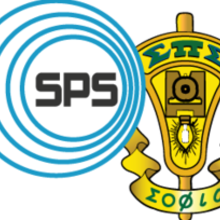
UVa's SPS Chapter Recognized Again as Outstanding
UVa's SPS chapter has been named an SPS Outstanding Chapter for the second year in a row. This honor is only given to the top 10% of all SPS chapters in the country.
The Director of the Society of Physics Students & Sigma Pi Sigma writes: "You and your chapter officers have earned this moment in the spotlight to recognize your efforts to build community and transform students into successful professionals."
For more information, see:
https://www.spsnational.org/awards/outstanding-chapter/recipients/2017

Bloomfield Develops Jelly Earplug
From NBC29:
Trademarked as “MemorySil,” the shape-memory material is first being marketed as an earplug called EarJellies, referencing the jelly-like texture of the rubber.
“It is a very soft material that can barely stand up under its own weight, but it remembers shapes and fights to retain them, making it ideal for conforming to the shape of an individual’s ear canal,” said Lou Bloomfield, the UVA physics professor who created the material after a range of experiments over years. “It forms a very good seal for blocking loud sounds.”
Fulls story at http://www.nbc29.com/story/37484958/uva-professor-develops-new-jelly-earplug
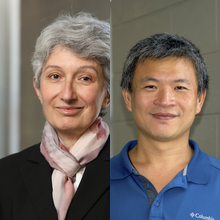
Strain engineering of a topological semimetal
Researchers at UVa found a way through strain engineering to manipulate the electronic band structure, and induce large, reversible response of the magnetoresistive properties under high magnetic fields in topological Weyl semimetal MoTe2. Coupled with this response is a phase change that can also be reversibly switched under tensile strain. The work done in collaboration with the Condensed Matter experimental group of Despina Louca and the theoretical group of Gia-wei Chern showed for the first time that the response is due to a changing atomic orbital texture under strain. The results from this work recently appeared in Science Advances.
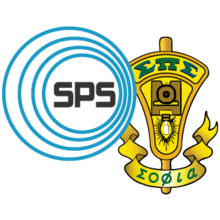
Seventh Annual Sigma Pi Sigma Research Symposium
The Seventh Annual Sigma Pi Sigma Research Symposium was held on November 3rd, 2017 in the Rotunda's Lower West Oval Room. Professors Craig Group, Marija Vucelja, Shane Davis, and Kent Paschke were invited to judge nine presentations delivered by students in the Physics and Astronomy Departments. Students presented research topics ranging from noise reduction in LIGO's mirrors to simulations of magnetic skyrmions. Cash prizes were awarded to the following presentations:
Talks:
1st Place: A Comparison of Galaxy Bulge+Disk Decomposition between Pan-STARRS and SDSS by Martine Lokken
2nd Place: Chiral Modes in Bilayer Graphene by Matt Walker and Andrew Jiao
3rd Place: Micromagnetic Simulations of Magnetic Skyrmions by Ben Hillman
Posters:
1st Place: Studies to Understand and Optimize the Performance of Scintillation Counters for the Mu2e Cosmic Ray Veto System by Peter Farris and Pedrom Zadeh
2nd Place: Black Hole Search at the Large Hadron Collider by Gage DeZoort and Jesse Han
3rd Place: Simulating Particle Collisions at the LHC by Andrew Orvedahl

Craigs' Group NOvA Homework
From UVA Today:
University of Virginia physicists are playing a key role in one of the world’s largest physics experiments, a nearly $300 million project called “NOvA” that is designed to study fundamental particles. The aim is to help tweak out the details of how the universe came to its present state from particle interactions that occurred in the first seconds after the Big Bang nearly 14 billion years ago.
...
“There are holes in our understanding of the universe, and as scientists, we won’t sleep well until those holes are patched,” said Craig Group, a project scientist with NOvA and UVA physics professor. “It sometimes takes big experiments to answer fundamental questions.”
...
The roughly 200 scientists around the country who are part of NOvA must actively monitor the experiments in real time. They do this in shifts, either at Fermilab or remotely, if so equipped.
Last summer, Group and his colleagues set up a $10,000 monitoring and control station in the High-Energy Physics Lab on Grounds to make this easier. Previously they had to fly to Illinois and run their shifts on-site, but now they can do it from the comfort of home – their lab.
Three to four times per year, Group and colleague Craig Dukes, another project scientist with NOvA, and a corps of postdoctoral fellows and graduate students take turns over a four-day period pulling three eight-hour shifts per day. With the station in place, they now can monitor experiments at any time, even when another institution is on guard duty.
For the full story, see www.news.virginia.edu/content/uva-neutrino-researchers-close-how-matter-came-be
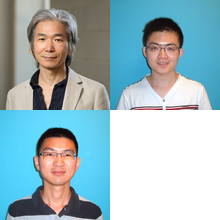
Lee Group's Work on Solar Cells Highlighted by DOE
Twisting Molecule Wrings More Power from Solar Cells
Inside a solar cell, sunlight excites electrons. But these electrons often don’t last long enough to go on to power cell phones or warm homes. In a promising new type of solar cell, the solar-excited electrons have better odds going on to work. Why? Seung-Hun Lee’s group (Tianran Chen and Depei Zhang) and their collaborators revealed the dominant force behind the higher efficiency of these promising hybrid organic-inorganic perovskite solar cells. They found that positively charged molecules rotate in the cell. In moving, the molecules screen the excited charge carriers — electrons and holes (missing electrons) — from annihilation. Discovering this new microscopic mechanism offers a rational path to design novel materials for higher solar cell efficiency.
This work was published in PNAS this year and was selected as a research highlight by the U.S. Department of Energy Office of Science: https://science.energy.gov/bes/highlights/2017/bes-2017-11-c/
Alumnus Caplan Receives APS Dissertation Award
UVa Physics Alumnus Matthew Caplan (B.S. 2013), now a Canadian Institute for Theoretical Astrophysics Postdoctoral Fellow at McGill University, has received the 2018 Dissertation Award in Nuclear Physics from the American Physical Society.
Citation:
"for a pioneering study of dense nuclear matter in compact stars that makes surprising connections across disciplines including nuclear physics and biophysics."
For more, see:
http://www.aps.org/programs/honors/prizes/prizerecipient.cfm?first_nm=Matthew,&last_nm=Caplan&year=2018
Alumna Manning Receives Maria Goeppert Mayer Award
UVa Physics Alumna M. Lisa Manning (B.S. 2002), now Associate Professor of Physics at the Syracuse University, has received the 2018 Maria Goeppert Mayer Award by the American Physical Society.
Citation:
"for her use of computational and analytical tools to develop microscopic understanding of flow in disordered materials, ranging from metallic glasses to biological tissues."
For more, see:
http://www.aps.org/programs/honors/prizes/prizerecipient.cfm?first_nm=M.&last_nm=Manning&year=2018

Stetzler Wins Major Scholarship
From UVA Today:
Steven Stetzler asks big questions, such as “What is the universe made of?” and “Why is the universe the way it is?”
Stetzler, of Kutztown, Pennsylvania, a fourth-year physics and computer science major at the University of Virginia, has received a $10,000 scholarship from the Astronaut Scholarship Foundation to help him in his questioning.
For more, see www.news.virginia.edu/content/asking-big-questions-lands-physics-student-major-scholarship

Cass gets Ultra-Cool
From UVA Today:
It is said that what goes up must come down. Thank gravity for that. But sometimes gravitational effects affect matter on Earth in ways that physicists would rather do without. So early next year NASA is launching to the International Space Station a novel “Cold Atom Laboratory” that will allow physicists to conduct sustained experiments into the states of matter, under nearly weightless conditions, at ultra-cold temperatures, that would be nearly impossible to conduct on Earth.
University of Virginia physicist Cass Sackett is part of the mission.
“We will make use of the near-weightless conditions of orbit to help us suspend atoms, slow them down, and thereby cool down, the motions of atoms,” he said. “These cold physics experiments should provide a much greater understanding of quantum mechanics and gravity, and provide some practical uses as well.”
For full story, see www.news.virginia.edu/content/uva-physics-go-space-and-get-ultra-cold

Probing Matter with Attosecond Photo-Electron Wavepackets
Electronic processes and electron-driven reactions in atoms, molecules and condensed systems can proceed very rapidly, with relevant time-scales in the attosecond (1 attosecond=10-18 s) regime. When activated by the photoabsorption of extreme-ultra-violet attosecond laser pulses, the electron dynamics can be probed in real time by employing the coherent optical field of an additional infrared laser to mark time during the system’s evolution. While temporal resolutions on the order of 10 attoseconds have been demonstrated in such measurements, the physical insight which can be directly gleaned from these experiments has been limited, relying on extensive numerical simulations for interpretation. Now, a team from the University of Virginia and the Ohio State University has demonstrated a new technique that utilizes quantum interference in attosecond photoionization to directly reveal explicit information on an electron’s local environment, captured within a brief time interval (~ 1 femtosecond) following its emission. Initially applied to investigate the effects of electron correlation within atoms, the method should be applicable to molecules, and perhaps condensed systems as well.
D. Kiesewetter1 , R. R. Jones2, A. Camper1, S. B. Schoun1, P. Agostini1, and L. F. DiMauro1, “Probing Electronic Binding Potentials with Attosecond Photoelectron Wavepackets,” Nature Physics, doi: 10.1038/nphys4279 (October 2017).
1Department of Physics, The Ohio State University, Columbus, OH
2Department of Physics, University of Virginia, Charlottesville, VA
See full paper at http://dx.doi.org/10.1038/nphys4279
For a nice UVAToday write-up, see https://www.news.virginia.edu/content/physicists-take-snapshots-electrons-move
Fall 2017 Physics Newsletter
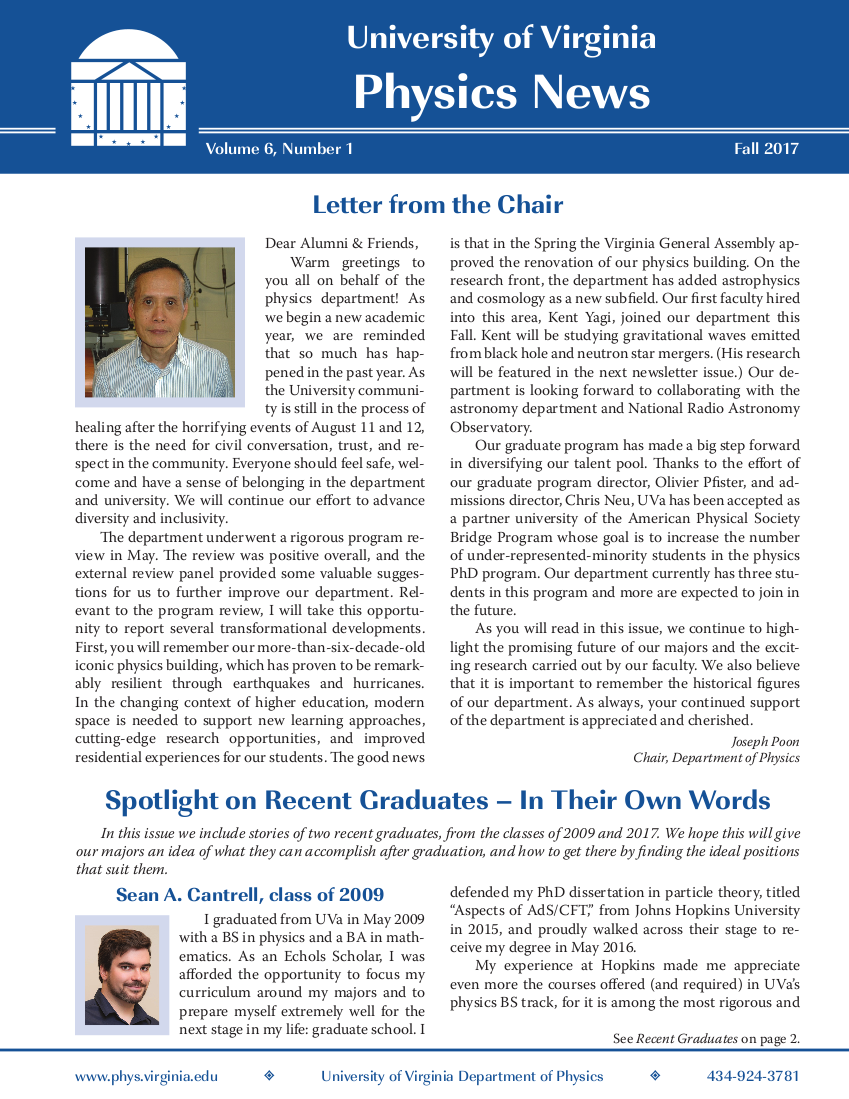 The current edition of our departmental newsletter features profiles of three new faculty members (Jeffrey Teo, Gia-Wei Chern, and Marija Vucelja), and a tale spanning three generations of the Cabrera family. You can read the newsletter here:
The current edition of our departmental newsletter features profiles of three new faculty members (Jeffrey Teo, Gia-Wei Chern, and Marija Vucelja), and a tale spanning three generations of the Cabrera family. You can read the newsletter here:
http://www.phys.virginia.edu/Announcements/Newsletter/Vol06Num01.pdf

Han wins Ig Nobel Prize
Physics Major Jiwon "Jesse" Han has won a 2017 Ig Nobel Prize for his paper on "A Study on the Coffee Spilling Phenomena in the Low Impulse Regime":
www.improbable.com/ig/winners/#ig2017
Jesse's (short) Ig Nobel lecture can be seen at 52'35" on:
m.youtube.com/watch?v=yNwLfRpNHhI

Origin of Long Lifetime of Charge Carriers in Solar Cell Perovskites
When sunlight shines on a semiconducting material, electrons in the material can be excited from their original states to higher energy states, forming photo-excited electrons and leaving empty states (called holes) in the original states. Usually the excited electrons and holes (charge carriers) quickly meet and annihilate each other. However if they survive long enough to be collected in an external circuit, then they can produce electricity: solar energy is transformed to electricity. Hybrid organic-inorganic perovskites (HOIPs) are among the most promising materials for next generation solar cells that combine high efficiency and low-cost. It has been shown that long lifetime of the charge carriers is what makes hybrid organic-inorganic perovskites high performance photovoltaic materials. The microscopic mechanism for the long lifetime however has been controversial. This work shows, by using a combination of optoelectronic property measurements and neutron scattering techniques, that the screening of charge carriers by rotation of organic cation molecules is a major contribution to the prolonged carrier lifetime. Thus, searching for hybrid organic-inorganic perovskites with high rotational entropy over a wide range of temperature may be a key to achieve superior solar cell performance.
Tianran Chen, Wei-Liang Chen, Benjamin J. Foley, Jooseop Lee, Jacob Ruff, J. Y. Peter Ko, Craig M. Brown, Leland W. Harriger, Depei Zhang, Changwon Park, Mina Yoon, Yu-Ming Chang, Joshua J. Choi, and Seung-Hun Lee, Proceedings of the National Academy of Sciences, doi: 10.1073/pnas.1704421114 (2017).
For a Powerpoint slide with graphics, see
For the Proceedings of the National Academy of Sciences paper, see
www.pnas.org/content/early/2017/06/26/1704421114.full
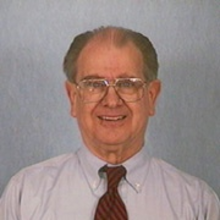
2017-18 Deaver Scholarship Application Form for Physics Majors
The Deaver Scholarships were established to honor Bascom S. Deaver, a retired physics department professor, and are awarded to students who have declared or are intending to pursue an undergraduate major in physics. They are competitive and awarded annually by the department to rising third or fourth year students. Winners are selected based on academic performance and demonstrated interest in pursuing the study of physics.
The Deaver scholarships are competitive. They are awarded annually by the Physics Department as academic year support for declared physics majors in their 3rd and 4th years.
You are eligible if you are a declared physics major currently completing your 2nd or 3rd year. The selection process will be based on what you write on this application and a current academic SIS transcript.
Typical award amounts will be in the range $5,000 to $10,000 as resources allow. We expect to award several scholarships for the next academic year. The application deadline this year is July 1.
You can find an application form at http://www.phys.virginia.edu/Announcements/DeaverFund/
We prefer that you fill out this application electronically and submit it to Beth
Guyton ([email protected] ) electronically.
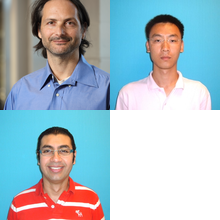
A novel quantum phase transition and super-entangled states
One of the main quests of many-body physics and quantum information is to understand quantum phases and in particular the entanglement present in them. In this work, Zhao Zhang and Amr Ahmadain, working with Prof. Klich, have uncovered a novel quantum phase transition in spin chains where entanglement entropy jumps into a critical phase exhibiting an extraordinary amount of entanglement. This discovery pushes the boundaries of the possible range of nonlocal quantum correlations and opens a door to fundamental and practical questions about the interplay of entanglement and locality in many-body systems.
The research has been published in PNAS:

Chen wins Best Poster Award at MRS Spring Meeting
Tianran Chen received the Symposium ES1 Best Poster Presentation Award at the 2017 MRS Spring Meeting. The award was based upon technical content, graphica excellence, and presentation quality.
For more see
https://www.mrs.org/spring2017/spring-2017-symposia/?code=ES1

Wright wins IT Excellence Award
Bryan Wright is one of three 2017 IT Excellence Award winners. This well earned award recognizes individuals who demonstrate outstanding service in support of the Information Technology needs of their organization.
For more, see
http://www.its.virginia.edu/newsletters/employees/lspmay2017.html#awards
and
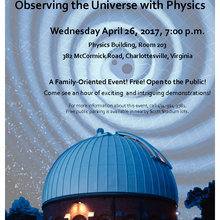
Observing the Universe with Physics: National Physics Day 2017
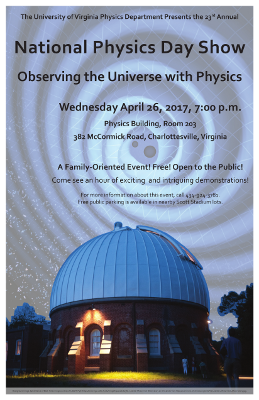 An article in UVaToday describes this year's annual National Physics Day Show, which was held on April 26. From the article:
An article in UVaToday describes this year's annual National Physics Day Show, which was held on April 26. From the article:
“It’s a demo show designed to educate and entertain kids and the grownups who bring them,” said [Prof. Cass] Sackett, who hosts this year’s event. “We carry the torch, year to year, in an effort to foster enthusiasm and excitement for our science by making it accessible. We pass that torch to each generation. Developing scientific literacy is good for society.”
View the article here:
https://www.news.virginia.edu/content/uva-invents-national-physics-day-anew-each-year
and view video from this and previous years here:
http://www.phys.virginia.edu/Announcements/PhysicsDay/videos/

Katya Gilbo Featured in UVaToday
Physics major Katya Gilbo is featured in an article in this week's edition of UVaToday. Katya says “nature is stuffed to the brim with dramatic processes, and we humans aren’t bystanders.”
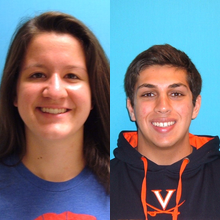
Andersen wins Goldwater Scholarship; Gupta gets Honorable Mention
Bridget Andersen has won a 2017 Goldwater Scholarship, one of the most prestigious undergraduate scholarships in the natural sciences, mathematics, and engineering in America. Arvind Gupta was given an Honorable Mention.
For a nice UVAToday article see
For more on the Goldwater Scholarship, see
https://goldwater.scholarsapply.org
For the list of the 2017 Scholars see
https://goldwater.scholarsapply.org/2017-scholars/
and for list of the 2017 Honorable Mentions see
https://goldwater.scholarsapply.org/2017-honorable-mentions/

Pennies from Heaven
From USA TODAY:
"There's a tale we've all heard: A penny dropped from the top of the Empire State Building would fall at such a rate it would impale and kill anyone it hit down below.
The myth somehow weaseled its way through the generations, horrifying elementary school students and causing reasonable people to wonder if a day of New York City sightseeing would be their last.
But quietly, about a decade ago, University of Virginia physics professor Louis Bloomfield put those fears to rest by happily getting pelted with pennies from high above. He answered the question and lived to tell about it."

Louca Elected President of NSSA
Prof. Despina Louca has been elected to serve a four year term as President of the Neutron Scattering Society of America.
See
http://neutronscattering.org
and
http://neutronscattering.org/2017/03/congratulations-new-nssa-executive-committee-members/
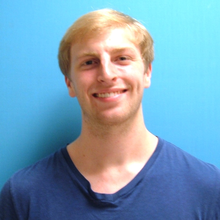
DeZoort Wins Best Poster Award at 2016 PhysCon
Gage DeZoort's poster, Anomalous Signal Reduction in the CMS ECAL Trigger, won a Best Poster award at the 2016 Quadrennial Physics Congress (PhysCon) held November 3-5, 2016, in San Francisco, CA. The $200 OSA (Optical Society of America) Poster Awards for General Physics recognize posters that explore general themes related to Physics with an emphasis on how optics and light cross all disciplines of the field.
For more, see:
http://www.sigmapisigma.org/sigmapisigma/congress/2016/poster-presentations

Liuti to serve on Physical Review C Editorial Board
Prof. Simonetta Liuti has been selected to serve on the Physical Review C Editorial Board for a three years term beginning on January 2017.
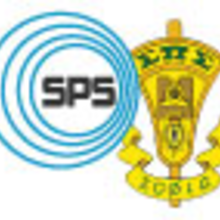
UVa's SPS Chapter Recognized as Outstanding
UVa's SPS chapter has been named a 2015-16 SPS Outstanding Chapter. This honor is only given to the top 10% of all SPS chapters in the country.
The Director of the Society of Physics Students & Sigma Pi Sigma writes: "You and your chapter officers have earned this moment in the spotlight to recognize your efforts to build community and transform students into successful professionals."
For more information, see:
https://www.spsnational.org/awards/outstanding-chapter
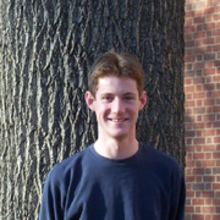
'Hoo You Gonna Call
UVa Physics alumnus (graduate and undergraduate) James Maxwell played an important technical role in the recent Ghostbusters movie. His research apparatus served as a model for the movie's laboratory and he served as technical consultant, even writing a "history" of the proton pack.
Fore more information, see the Virginia magazine article:
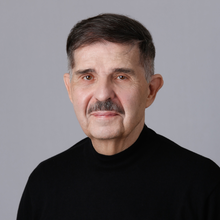
Cox Named 2016 AAAS Fellow
Brad Cox's election as AAAS Fellow is celebrated in UVAToday. From the article:
"Cox was honored for his contributions to the field of experimental high-energy physics, particularly in the discovery of the Higgs particle.
The tradition of AAAS Fellows began in 1874 and is considered a prestigious distinction among scientists. This year, 391 of the 10 million-member organization – the world’s largest general scientific society – have earned this honor for their scientifically or socially distinguished efforts to advance science. Members earn the rank of fellow after a nomination process by their peers within their fields or by selection of AAAS’s chief executive officer."
UVAToday article:
AAAS Announcement:
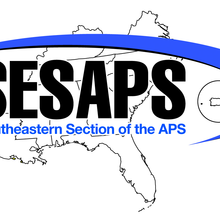
2016 SESAPS Conference
From November 9-12, 2016, the UVa Physics department hosted the 83rd Annual Meeting of the Southeastern Section of the American Physical Society (SESAPS):
http://sesaps2016.phys.virginia.edu
The conference drew over 400 attendees, and featured 210 talks and 78 poster presentations, making it the largest Southeastern Section meeting ever held. Slides from many of the talks can be viewed through the conference agenda:
http://sesaps2016.phys.virginia.edu/other-view?view=standard_inline_minutes
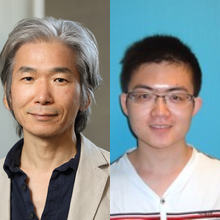
Lee's Work on a Novel Solar Cell Material Highlighted in UVAToday
From UVaToday:
"... scientists and engineers at the University of Virginia, with colleagues at the NIST Center for Neutron Research, the Oak Ridge National Laboratory and Cornell University, have made new inroads on understanding the fundamental physics behind how these cells work in a variety of "structural phase transitions."
They detail their findings in a paper published Oct. 21 in the journal Science Advances, where they identify how organic molecules in the structures play a crucial role in how the phase transitions occur.
By microscopically probing the materials using neutron-scattering experiments and computer simulations, they have discovered ways to markedly expand the stable range of the desired structure for the solar cell during temperature changes. The results could potentially revolutionize solar cell technology by speeding the process of designing solar cell materials that are both efficient and stable over a wide range of temperatures, while remaining inexpensive to produce in large quantities.
"This opens new opportunities to unlock the full potential of the HOIP-based solar cells in real applications," said UVA physicist Seung-Hun Lee, who led the study with his colleague, UVA chemical engineer Joshua J. Choi."
For full story see:
https://news.virginia.edu/content/uva-physicists-engineers-paving-way-wider-use-new-solar-cell-materials
Also see the Sciences Advances article at:
http://advances.sciencemag.org/content/2/10/e1601650

Dukes Describes Cosmic Pain
According to Prof. Craig Dukes, "Cosmic rays can be a real pain." Dukes contributed a Fermilab "News at work" article discussing the work that he and his collaborators are doing to mitigate the adverse effects of cosmic ray muons on their neutrino physics experiments.
The UVA group, which includes professor Craig Group, research scientists Ralf Ehrlich and Yuri Oksuzian, graduate student Steve Boi, and many undergraduate students, will be fabricating the Mu2e Cosmic Ray Veto in the High Energy Physics Laboratory, before shipping it out to Fermilab. It will be the largest construction project ever done by the UVA High Energy Physics Group.
See the article at:
http://news.fnal.gov/2016/10/cosmic-rays-pain/

Negative Refraction of Electrons in Graphene Observed
Negative refraction for electrons passing a boundary has been observed by a team including Avik Ghosh, an Affiliated Professor of Physics. The results have been published in Science.
For more, see the SEAS Press Release:
http://enews.seas.virginia.edu/electrons-in-graphene-behave-like-light-only-better/
For the Science article, see:
http://science.sciencemag.org/content/353/6307/1522

Memories and energy landscapes of magnetic glassy states
Understanding how memory emerges from a complex network of neurons in our brain remains a challenging task in cognitive science. Memory also arises in physical systems with complex energy landscapes such as glasses, disordered magnets, and social networks. Now, an international team led by S.-H. Lee of the University of Virginia has revealed the intricate relation between how the systems remember their past and their complex energy landscapes. The findings, published in the journal Proceedings of the National Academy of Sciences of U.S.A., show that two magnetic glassy states, called spin glass and spin jam, exhibit distinct memory effects; a stronger memory for the spin glass and a weaker memory for the spin jam. The research also revealed by Monte Carlo simulations that the characteristics of how they remember can be accounted for by two distinct energy landscapes; a fractal rugged funnel-like energy landscape for the spin glass and a non-fractal non-hierarchical energy landscape with rough flat bottom for the spin jam. Their findings illustrate that a combination of experimental and computational works can directly probe the intricate relation between memory and energy landscape, which is essential in understanding the nature of the intrinsic slow dynamics in glassy states.
The team of University of Virginia is made of Seung-Hun Lee's group (Anjana Samarakoon, Tianran Chen, Junjie Yang, and S.-H. Lee), a new theoretical faculty of Physics Gia-Wei Chern, and Israel Klich. Anjana Samarakoon and Taku Sato of Tohoku University have performed the experiments, starting when Anjana spent two months in the summer of 2015 at Sato's lab in Sendai, Japan. Tianran Chen has performed the computational work in collaboration with Gia-Wei Chern. Junjie Yang and Zhou's group at University of Tennessee have provided the samples. Seung-Hun, Gia-Wei, and Israel wrote the paper.
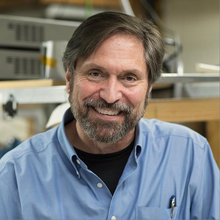
Cates' Group Develops Novel Imaging Technique
From UVAToday:
A unique new imaging method, called "polarized nuclear imaging" - combining powerful aspects of both magnetic resonance imaging and gamma-ray imaging and developed by physicists in the University of Virginia's departments of Physics and Radiology - has potential for new types of high-resolution medical diagnostics as well as industrial and physics research applications.
"This method makes possible a truly new, absolutely different class of medical diagnostics," said Wilson Miller, who, along with his colleague Gordon Cates, directed the research. "We're combining the advantages of using highly detectable nuclear tracers with the spectral sensitivity and diagnostic power of MRI techniques."
For more, see:
UVAToday Story:
https://www.news.virginia.edu/content/uva-scientists-create-novel-imaging-technique-potential-medical-diagnostics
Nature Article:
http://www.nature.com/nature/journal/v537/n7622/full/nature19775.html
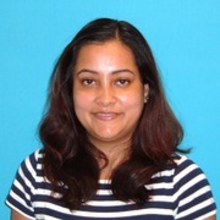
Chakdar Wins UVa Wide Postdoctoral Poster Competition
Shreyashi Chakdar has been awarded the First Place and the Audience Choice awards for the poster presentations in the "Physical Science and Engineering category" of University of Virginia Postdoctoral Research Symposium held on Tuesday, Sep 20th, 2016 at the Newcomb Hall, UVa.
Chakdar is currently a postdoc working with Dr. P.Q. Hung and presented her ongoing research work titled 'The search for 'mirror' quarks with distinguished signatures at the 13 TeV LHC' at the symposium.
For more, see:
https://postdoc.virginia.edu/node/587

NOvA shines new light on how neutrinos behave
NOvA issued a press release and announced new results on the disappearance of muon neutrinos at the 38th International Conference on High Energy Physics. From the press release:
"NOvA scientists have seen evidence that one of the three neutrino mass states might not include equal parts of muon and tau flavor, as previously thought. Scientists refer to this as "nonmaximal mixing," and NOvA's preliminary result is the first hint that this may be the case for the third mass state."
The UVa Antimatter Asymmetry group has been a member of NOvA since its inception. Among other things, they designed and built the power distribution system that powers all of the electronics.

Bloomfield Explains Olympic Freestyle
UVA physics professor Lou Bloomfield explains some of the fundamental forces at work in Olympic freestyle swimming, and how swimmers can use science to get ahead.

DeZoort Elected SPS Associate Zone Councilor
Gage DeZoort has been elected to serve as Zone 4 Associate Zone Councilor (AZC) for the 2016-2017 school year. His term began on June 12, 2016. On the SPS National Council, Gage will be a representative and a voice for students’ opinions and concerns, and he will make decisions that affect SPS members and the international physics community. For more, see:

Day Interviewed on Future of Nuclear Energy
From CBS19:
"I really don't think there is much future for Nuclear energy," said Donal Day, a Nuclear Physicist who teaches at University of Virginia. "I don't think it's because people are opposed to it, but because the market just won't support it."
Day says that the future of energy in the state should be renewable energies.
"Wind, solar, and battery," said Day. "Things like that make it too competitive to be worthwhile."
For the full story and video, see:
http://www.newsplex.com/content/news/Is-Nuclear-Energy-the-future-of-energy-in-the-United-States-380737731.html
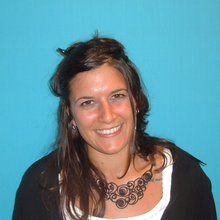
Principato Meets Italian Prime Minister
Earlier this month, Cristiana Principato, a UVa graduate student in the Physics Department, had the opportunity to meet with Italian Prime Minister Matteo Renzi when he visited the Fermi National Laboratory where Cristiana conducts her research. Italy has a long history of collaboration on particle physics experiments at Fermilab. During the event Cristiana also met Nobel Laureate Carlo Rubbia.
Some photos from the event can be found at:
vms.fnal.gov/asset/detail?recid=1940629
vms.fnal.gov/asset/detail?recid=1940630
vms.fnal.gov/asset/detail?recid=1940680
vms.fnal.gov/asset/detail?recid=1940631
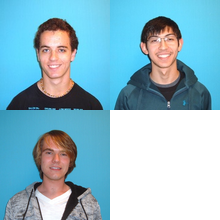
Bixel, Diehl, and Slomka Elected to Phi Beta Kappa
David Bixel, Adam Diehl, and Matthew Slomka were elected to the Beta Chapter of Virginia of Phi Beta Kappa.
Prof. Carrie Douglass, President, Phi Beta Kappa, Beta Chapter of Virginia, writes:
"As the oldest and most distinguished honor society in the country, Phi Beta Kappa offers membership to less than one percent of all undergraduates. Many of the leading figures in American history and culture have begun their careers with election to the society, including seventeen presidents of the United States. As a result, membership is a remarkable accomplishment, both for the student who achieves it and the faculty and staff whose support and guidance has led to this milestone."
For more information, see:
college.as.virginia.edu/phi-beta-kappa
Special Physics Department Medical Physics Scholarship!
The Department has a $5,000 Scholarship available for this summer, 2016, to support a declared physics major to work with a faculty member on a medical physics project. The faculty member is not required to be member of the Physics Department, but the student must be a declared major, with a strong academic record, and be rising third or fourth year.
Note that a supporting letter from the faculty member is required.
The deadline for applications is March 4, 2016. Forms are available online at:
http://www.phys.virginia.edu/Announcements/MedicalPhysics/ApplicationForm.docx
UVa's SPS Chapter Again Recognized as Distinguished
For the third straight year UVa’s SPS chapter has been recognized as “distinguished”. This honor is only given to the top 20% of all SPS chapters in the country.
For more about SPS Outstanding Chapter Awards, see:
www.spsnational.org/awards/outstanding-chapter
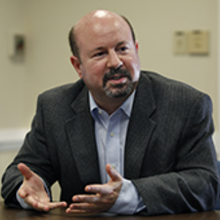
Michael Mann on Climate Change
Michael E. Mann, Distinguished Professor of Atmospheric Science at Penn State University, spoke on The Physics of Climate Change at the UVa Physics Department on Friday, February 5. A video of Prof. Mann's talk can be seen at the link below:
http://www.phys.virginia.edu/Announcements/talk-list.asp?SELECT=SID%202990
Mitchell Scholarship Deadline Approaching
Mitchell and other Scholarships are available to support declared undergraduate physics majors in their third or fourth year of study at UVa in the academic year 2016-17.
They are competitive and awarded annually by the Department to rising 3rd and 4th year students. The selection process will be based on submission of an application, a recent academic SIS transcript, and a letter of support from the Physics Department faculty member with whom you will be working. The scholarships will be awarded primarily on the basis of academic achievement. The scholarships will be up to $5,000 in value.
The application deadline is February 19, 2016.
The application form is available online at: http://www.phys.virginia.edu/Announcements/Mitchell/ApplicationForm.docx

Deaver featured in Physics Focus

Sackett Viewpoint featured in Physics

Zheng Elected a Fellow of the American Physical Society
Upon the recomendation of the Topical Group on Hadronic Physics (GHP), Xiaochao Zheng has been elected a Fellow of the American Physical Society. The citation reads:
"For advancing the measurement of parity violating asymmetry in electron-nucleon deep inelastic scattering.”
Prof. Zheng's name and Fellowship citation will be published in APS News and will appear on the Fellowship Page of the APS web site [www.aps.org].
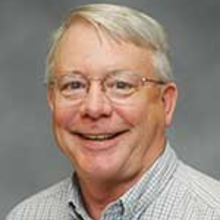
Alumnus Tanner Awarded APS Isakson Prize
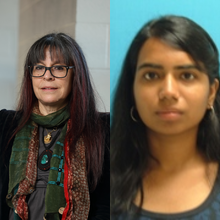
Liuti and Rajan U.Va. recipients of DOE Topical Collaboration Award
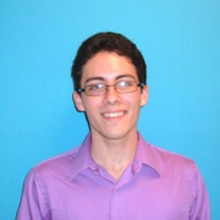
Robert Mina: Sushi and Sliding Doors

Xiaochao Zheng Featured in UVaToday's "U.Va. Faculty Will Realize Their 'Dream Ideas,' Thanks to Mead Grants"
From UVa Today: "...Xiaochao Zheng, associate professor of physics
Because 3-D printing is a relatively new field, many undergraduate physics students have not been exposed to this increasingly useful tool. Zheng’s dream idea includes purchasing a 3-D printer and inviting groups of three to five students to develop increasingly innovative, sophisticated and complex 3-D models over the year. The semester will culminate in an award ceremony recognizing the students’ most outstanding models."
Click on the link for the full article:
http://www.news.virginia.edu/content/uva-faculty-will-realize-their-dream-ideas-thanks-mead-grants
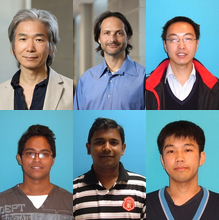
Love triangles, quantum fluctuations and spin jam
Lee's group presented experimental evidence for the existence of a topological spin state called spin jam. When magnetic moments are interacting with each other in a situation resembling that of complex love triangles, called frustration, a large set of states that are energetically equivalent emerge. This leads to exotic spin states such as spin liquid and spin ice. In their paper recently published in the Proceedings of the National Academy of Sciences (PNAS), Lee's group (Yang, Samarakoon, Dissanayake, and Lee) along with Klich presented evidence for the existence of a topological glassy state, that they call a spin jam, induced by quantum fluctuations. The case in point is SrCr9pGa12-9pO19 (SCGO(p)), a highly frustrated magnet, in which the magnetic Cr ions form a quasi-two-dimensional triangular system of bi-pyramids. This system has been an archetype in search for exotic spin states. Understanding the nature of the state has been a great intellectual challenge. The UVA group's new experimental data and their theoretical spin jam model provide for the first time a coherent understanding of the phenomenon. Furthermore, the findings strongly support the possible existence of purely topological glassy states.
For more, see:
http://www.pnas.org/content/early/2015/08/27/1503126112.full
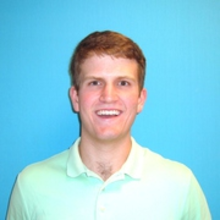
Carr and Sperling Receive Dean's Scholarships
Peter Carr received the Lawrence Harrison Kilmon and May Lewis Kilmon
Scholarship for outstanding academic achievement and Owen Sperling received the George C. and Carroll F. M. Seward Scholarship for outstanding academic achievement and outstanding service to others.
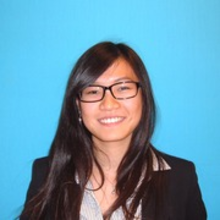
Xiao Receives ISO Academic Excellence Award
Liting Xiao received the International Studies Office
Graduating International Students Awards in the category for Academic Excellence
See
https://www.facebook.com/51812338138/posts/10153293894208139/
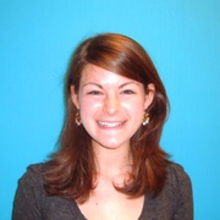
Janet Rafner Featured in UVaToday Series on Class of 2015

Group wins 2015 Cory Family Teaching Award
Assistant Professor Craig Group has won the 2015 Cory Family Teaching Award. This is a prize presented annually to two untenured tenure-track professors in the College of Arts and Sciences, recognizing excellence in undergraduate instruction. The award will be recognized on October 23rd at Fall Convocation in the JPJ Arena.
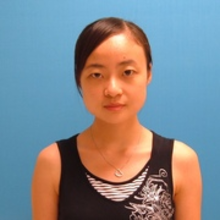
Moran Chen Featured in UVaToday Series on Class of 2015
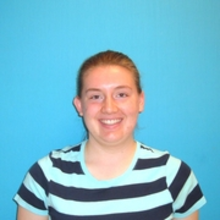
Yanchenko Wins Outstanding Undergraduate Physics Major Research Award
The winner of this year's Outstanding Undergraduate Physics Major Research Award is Anna Yanchenko, whose research was entitled "THz Field Enhancement and Electron Emission from Au DENA Growth". Her research professor was Robert Jones.
Anna will receive her award at our graduation ceremony next weekend.

Jones Elected Vice Chair of DAMOP
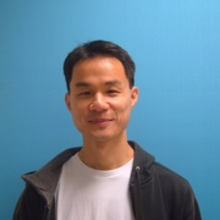
Wong Wins Gwathmey Award
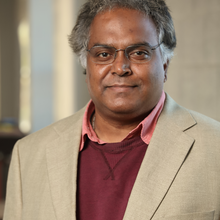
Chatterjee Garners NSF Career Award
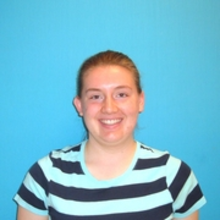
Yanchenko and Harris Elected to Phi Beta Kappa
UVa's SPS Chapter Recognized as Distinguished
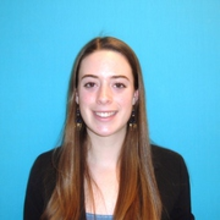
McDonald Wins APS Award
Dear Faculty and Undergraduates,
Please join me to congratulate Brigid McDonald for being recognized for giving one of the three best research presentations at the APS Conference for Undergraduate Women in Physics (cuwip.web.unc.edu).
The 3 winners are:
Brigid McDonald (UVa) -- best talk (group 1)
Melody Lim (Duke) -- best talk (group 2)
Meg Stuart (UTenn) -- best poster
Cheers,
Joe Poon
Chair of Physics

I Want The ILC! by P. Q. Hung
"The ILC Blues", by P. Q. Hung and Duong Quoc Dat, is featured in the Newsletter of the Linear Collider Comunity:
http://newsline.linearcollider.org/2015/01/08/the-ilc-blues/
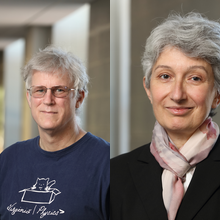
Arnold and Louca - APS Fellows 2014

Cox and Hawley Named U.Va.âs 2014 Distinguished Scientists
From UVa Today:
Two of the University of Virginia’s most accomplished faculty researchers – physicist Brad Cox and astronomer John Hawley – have been selected as 2014 Distinguished Scientists.
The awards, given annually by the Office of the Vice President for Research, honor longtime faculty members who have made extensive and influential contributions in the sciences, medicine or engineering.
Cox and Hawley will be honored in January at a dinner reception at the Colonnade Club.
“This U.Va. research tradition has honored scientists over the years who have changed the way we think about topics from human psychology, to how cells move, to the design of new materials,” Thomas C. Skalak, vice president for research, said. “Dr. Cox and Dr. Hawley are pioneers who have produced new understanding of the fundamental structure of matter and the dynamics of the universe, respectively. This new knowledge will be the basis for new theories and new vistas. The work helps us to realize that we are still learning our place in the universe.”
For more, see:
http://news.virginia.edu/content/cox-and-hawley-named-uva-s-2014-distinguished-scientists
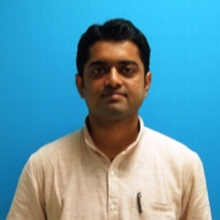
Kamat Wins at Three Minute Thesis Competition
Ajinkya Kamat’s entry, “Can we solve the mystery of ‘Neutrinos’ at Large Hadron Collider?”, took third place at the 2nd Annual UVa Three Minute Thesis competition.
For more, see http://gradstudies.virginia.edu/3MT-Homepage

November SESAPS Meeting
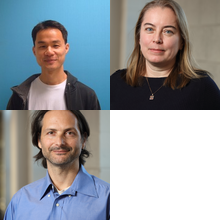
Wong Selected to be Kavli Institute Graduate Fellow
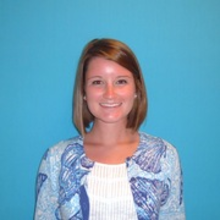
Amy Rodgers to Speak at Valedictory Exercises
The 2014 Valedictory Exercises will take place on Saturday, May 17 at 11:00 am on the lawn. This year's welcome speaker is fourth year Physics Major and Class of 2014 Trustee Amy Rodgers.
Rodgers' address will be followed by the presentation of awards, the presentation of the class gift, and the keynote speech by NFL quarterback Peyton Manning.
For more, see:
http://www.virginia.edu/finals/valedictoryexercises.html
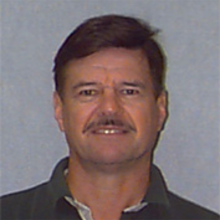
Lindgren, et al., Win Grants to Boost STEM Education
From UVaToday:
The Virginia Department of Education has awarded faculty members in the University of Virginiaâs Curry School of Education teacher education program and colleagues in U.Va.'s College of Arts & Sciences two grants to support Virginia elementary and secondary teachers of science and mathematics.
One trio will seek to boost the teaching of physics in middle and high schools, while the other group of faculty members work to boost the teaching of math and science to mixed classes of mainstream and special education students in elementary and middle schools.
Led by Richard Lindgren, research professor of physics, Frackson Mumba, associate professor of science education, and Jennifer Maeng, assistant professor of science education, the first project aims to increase middle and high school teachers' knowledge of physics and aid these teachers to teach that content in their classes more effectively. The grant will also aim to improve the use of technology in middle and high school physics classrooms.
For more, see:
http://news.virginia.edu/content/uva-faculty-win-grants-boost-stem-education-virginia-public-schools
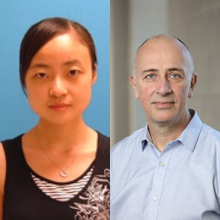
Moran Chen Wins 2014 Allen T. Gwathmey Memorial Award
Moran Chen is one of two recipients of the 2014 Allen T. Gwathmey Memorial Award, an honor reserved for the most accomplished graduate students in the sciences at the University of Virginia in recognition of a distinguished scholarly publication. Her paper,
M. Chen, N.C. Menicucci, and O. Pfister, Experimental realization of multipartite entanglement of 60 modes of a quantum optical frequency comb, Physical Review Letters 112, 120505 (2014),
can be read using the following link:
http://faculty.virginia.edu/quantum/PhysRevLett.112.120505.pdf
Please congratulate Moran for her scholarly achievement and recognition!

'Universal' Property of Metamagnets Identified by Shivaram, et al.
From UVaToday:
(A University of Virginia-led team) discovered that the magnetic effect of apparently all metamagnets is that it is non-linear. When these metamagnets are placed in an initial magnetic field and the field is doubled, they more than double in magnetic strength. This is significant because eventually scientists and engineers likely will harness this unique property for a variety of applications, including refrigeration.
"We found that this nonlinear property has the same quantitative behavior in all different types of metamagnets, which is the universal law," said Bellave Shivaram, a University of Virginia professor of physics who led the studies, which were conducted in his lab and using materials synthesized at Argonne National Laboratory in Illinois.
For more, see:
http://news.virginia.edu/content/newly-identified-universal-property-metamagnets-may-lead-everyday-uses
and:
http://scitation.aip.org/content/aip/journal/rsi/85/4/10.1063/1.4870796

Gilbo and Xiao Featured at UVa's Public Day
Two of our undergraduates students and Physics majors, Yekatarina Gilbo and Liting Xiao, were selected to showcase their research at UVa's recent public day. Gilbo was Undergraduate Research Symposium Winner while Xiao exhibited Dark Matter search work.
Per UVaToday:
"The modern Public Day is the successor to the Presidential Research Poster Competition, which U.Va. President Teresa A. Sullivan initiated three years ago. As posters are generally a product of traditional research activities, Sullivan sought to create a more inclusive event that highlights accomplishments in all academic fields."
For more, see:
http://news.virginia.edu/content/president-sullivan-revives-public-day-19th-century-uva-tradition
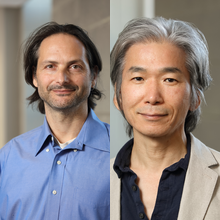
Klich and Lee Solve Longstanding Condensed Matter Physics Problem
Our theorist, Israel Klich, and experimentalist, Seung-Hun lee, have worked together to solve a long-standing problem in condensed matter physics regarding a glassy state in some frustrated magnets. When spins are arranged in a lattice of triangular motif, the phenomenon of frustration leads to numerous energetically equivalent ground states, and results in exotic states such as spin liquid and spin ice. In their paper recently published in Nature Communications, they report an alternative situation that they call a spin jam that is induced purely by quantum fluctuations. The frustrated magnet that they studied is a triangular network of bipyramids. They found that although classically the ground state is spin liquid, quantum corrections break the classical degeneracy into a set of aperiodic spin configurations forming local minima in a rugged energy landscape. A consequence of the complex energy landscape is, upon cooling, the system gets trapped in one of the local minima, leading to the glassy spin jam state. Their results clearly show that a glassy spin state can be achieved in the absence of disorder.
For more, see:
http://www.nature.com/ncomms/2014/140401/ncomms4497/full/ncomms4497.html

Triple-Emmy-Winning "Professor Lou"
From UVaToday:
"Professor Lou," as he is called on TV, is science central on a feature segment called "Forces of Hockey," which is produced by the Capitals and aired on the team's associated cable networks, on the NHL Network, and shown during breaks between play at Caps games.
The show, now in its fifth season, has won three regional Emmy Awards for "Outstanding Sports Program/Series," the most recent this spring.
"I'm probably the only professor just about anywhere who has won three Emmys," said Bloomfield, who sometimes jokes that he's not an actor, "I just play one on TV."
Full story:
http://news.virginia.edu/content/professor-lou-explains-science-behind-puck-washington-capitals-tv-0
Hoxton Lecture: Quantum Networks in Quantum Optics
Professor Jeff Kimble
This talk will discuss the opportunities for the exploration of physical systems that have not heretofore existed in the natural world. A reception will be held following the talk in the Chemistry Building atrium.
Thursday, March 27, 2014, 7:00 PM
Chemistry Building, Room 402
McCormick Road, Charlottesville
For more, see:
http://www.phys.virginia.edu/Announcements/Hoxton/

Janet Rafner wins Small Research and Travel Grant
Janet Rafner, one of our SPS officers, received a Small Research and Travel Grant in the amount of $1,500. She will travel to Orsay, France, to work with a team of physicists and designers to advance both public and academic understanding of the principles of physics by developing outreach resources in modern physics and emergent phenomena for the general public.
For more, see:
http://www.faculty.virginia.edu/spsuva/JanetRafnerSRTGProposal.html

Cates Elected Vice Chair of the APS Division of Nuclear Physics
Gordon Cates has been elected Vice Chair of the APS Division of Nuclear Physics (DNP), the beginning, in April 2014, a four year commitment in which he will next be the Chair Elect, then Chair, and finally Past Chair.

Zheng, et al., Report Electron-Quark Parity Violation in Nature
From Science:
"... electrons also interact with the nuclei through the weak force, which violates parity and is not mirror symmetric. As a result, right-spinning and left-spinning electrons ricochet off the target differently, creating a slight asymmetry in their scattering pattern
...
according to the standard model, the right- and left-spinning quarks should interact slightly differently with an incoming electron, producing an additional asymmetry, or parity violation, when the spin of the incoming electrons is flipped. Now, Xiaochao Zheng, a nuclear physicist at the University of Virginia in Charlottesville, and colleagues have observed that smaller contribution, as they report today in Nature."
This work was done at the Thomas Jefferson National Accelerator Facility:
http://hallaweb.jlab.org/experiment/PVDIS/publications/index.html
For more see:
http://news.sciencemag.org/physics/2014/02/quarks-know-their-left-their-right
and from UVaToday:
https://news.virginia.edu/content/uva-led-study-puts-quarks-looking-glass
Nature article:
http://www.nature.com/nature/journal/v506/n7486/full/nature12964.html
INPP 2nd Annual Lecture: Gordon Kane
*** Please note: The following lecture has been rescheduled for April 18, 2014 ****
Prof. Gordon L. Kane will lecture on "String Theory, Our Real World, and Higgs Bosons" in Physics 203 on Friday, April 18, 2014.
For more, see:
http://www.phys.virginia.edu/Announcements/INPP/2014.pdf

Brad Cox Named Outstanding Virginia Scientist
On January 15, 2014, UVaToday reported:
"In recognition of Cox's contributions to the search for and discovery of the Higgs, Virginia Gov. Terry McAuliffe and the Science Museum of Virginia today named him as one of two Virginia Outstanding Scientists for 2014."
For more, see the UVaToday News Release:
Third Annual Undergraduate Physics Research Symposium
The Third Annual Undergraduate Physics Research Symposium was held on November 1, 2013. Six undergraduates presented their physics-related research at the event. Topics presented were as follows:
Yekaterina Gilbo "The Role of Solar Wind in Magnetospheric Oscillations"
Alyssa Henderson "Non-linear Multi-dimensional Optimization for use in Wire Scanner Fitting"
Elton Ho "Noise Studies on Silicon Avalanche Photodiodes and Pure Cesium Iodide Crystals for the Belle II Experiment"
Ranjani Sarma "The Study of Neutrino Properties from Dark Matter Annihilation in the Sun"
Michael Viray "Variable Terahertz Transparencies of Different Plastics"
Sophia Xiao "Identification of Upward going Muons for Dark Matter Searches at the NOvA Experiment"
For more, see:
http://www.faculty.virginia.edu/spsuva/events/ResearchSymposium.html
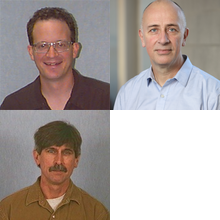
Fendley, Lee, Pfister, Thacker - APS Fellows 2013
Dear Colleagues,
We have learned from APS that four of our colleagues - Paul Fendley,
Seunghun Lee, Olivier Pfister and Hank Thacker have been elected
APS Fellows 2013. Please join me in congratulating all of them
for this well-deserved honor.
My sincere thanks to our APS Nominating Committee for a job well done!
(Dinko Pocanic, Brad Cox, Michael Fowler, Stu Wolf, and Lou Bloomfield)
Cheers,
Joe

Third Virginia and Maryland String and Particle Theory Meeting
On Saturday, November 2, 2013, Diana Vaman and UVa's Physics Department will again play host to the Virginia and Maryland String and Particle Theory Meeting.
The invited speakers are:
Justin Khoury (University of Pensylvania, Philadelphia)
Igor Klebanov (Princeton University, Princeton)
Albion Lawrence (Brandeis University, Waltham)
Jessie Shelton (Harvard University, Cambridge)
For more see:
http://physics1.howard.edu/~vadcmd/131102.html

U.Va. Physicists Celebrate Their Role in Nobel-Winning Higgs Discovery
From UVa Today:
"The Royal Swedish Academy of Sciences on Tuesday awarded the Nobel Prize in Physics to theorists Peter Higgs and Francois Englert to recognize their work in developing the theory of what is now known as the Higgs field, which gives elementary particles mass. University of Virginia scientists played a significant role in advancing the theory and in discovering the particle that proves the existence of the Higgs field â the Higgs boson.
Brad Cox, a professor of physics in U.Va.'s College of Arts & Sciences, served for three years on a sequence of eight analysis review committees, each comprising four physicists, that oversaw analysis of Higgs discovery data from the Large Hadron Collider in Europe. He also was part of a four-person analysis review team that oversaw the discovery analysis for 2 1/2 years to the point where it could be determined that the evidence was strong enough that the Higgs particle had been confirmed. The discovery was announced at the Large Hadron Collider in July 2012 and further supported in December."
Full story:
http://news.virginia.edu/content/uva-physicists-celebrate-their-role-nobel-winning-higgs-discovery

Joe Poon Serves on Excellence in Faculty Hiring Panel
From UVaToday:
"A panel of U.Va. faculty members and a Human Resources consultant experienced in faculty searches shared a range of recruiting strategies. Dr. Sim Galazka, professor of family medicine in the School of Medicine; Joe Poon, William Barton Rogers Professor of Physics; Archie Holmes, professor of electrical and computing engineering; and Catherine Brand, who works on the Executive Search Group, all agreed that publishing advertisements for job openings is only one tool in what should be a multi-pronged approach.
The panelists stressed that faculty members should consider search committee work as part of their service duty, and if necessary, should ask for a break on other service activities.
Their recruiting suggestions included turning to networks of colleagues to ask about potential job candidates to field a diverse pool, and making personal contact with those individuals; trying innovative ideas, such as the physics department has done by producing a video for recruiting; being reflective during the search process to review whether the pool is diverse and the process is going well, and making changes if necessary; and keeping in touch with potential candidates, even if they can't be hired at the time."
Full Story:
http://news.virginia.edu/content/faculty-focus-recruiting-strategies-attracting-new-colleagues-uva
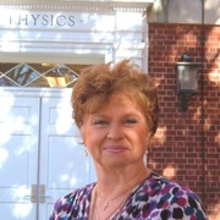
Pam Joseph Highlighted in Dean Woo's Zintl Award Acceptance Speech
In accepting this year's Elizabeth Zintl Leadership Award, presented by the Women's Center, Meredith Woo, the Dean of Arts and Sciences, mentioned our own Pam Joseph:
"Pamela Joseph is the research administrator in our Physics Department. For over thirty years she helped prepare proposals for external funding, going carefully over every number, every column, every punctuation mark in every proposal, so that the rewards can go to the scientists she supports. She is a woman at work, and every bit a leader without whom funding for Physics would gravely suffer. She has been doing this for 33 years."
For full text of Dean Woo's speech, see:
http://artsandsciences.virginia.edu/meredithwoo/blog/what-do-women-want/

Hung Awarded Vietnam's Medal for the Cause of Science and Technology
On Monday, August 12, 2013, P.Q. Hung was decorated by S.E. Nguyen Quan, Vietnam's Minister of Science and Technology, for his important contribution to the advances of Science and Education in Vietnam.
A nice photo of the ceremony can be seen at:
http://www.phys.virginia.edu/images/pqh_medalceremony.JPG
and the certificate at:
http://www.phys.virginia.edu/images/pqh_medalcertificate.JPG

Pfister Wins Distinguished Research Career Award
From UVa Today:
"Pfister, professor of physics in the College, is a noted researcher in quantum information and quantum computing. The development of quantum computers, one of the most challenging but promising areas of information science, would have capabilities far beyond todayâs most advanced supercomputers. They could be used for incredibly detailed, data-heavy simulations, such as understanding the minute details of the interactions of molecules in biological systems, or to unravel some of the biggest mysteries of the workings of the universe by providing a way to possibly test quantum mechanics."
For full story, see:
http://news.virginia.edu/content/uva-announces-seed-grants-boost-newly-promoted-researchers-work
Summer Edition of the "Physics Day Show"
To support our recruiting efforts, and for the fun of it, physics students teamed up with faculty and staff to organize two summer physics shows on July 9 and July 30 at 7 pm in room 203 in the Physics building. Spectacular and pedagogical demos will be shown around the topic "magnetism".
For more, see:
http://www.phys.virginia.edu/Announcements/PhysicsDay/SummerPhysShow2013.pdf

Pam Joseph Receives 2013 Outstanding Contribution Award
From UVaToday:
"Do you know which department in the University of Virginia's College of Arts & Sciences is best grant-funded?
The Department of Physics claims that distinction. And several faculty members there say it's due to the work of research administrator Pamela Joseph, one of this year's winners of a Leonard W. Sandridge Outstanding Contribution Award."
For full story, see:
http://news.virginia.edu/content/2013-outstanding-employee-pamela-joseph-physics-lifeline
Hoxton Lecture: The World According to Higgs
Professor Chris Quigg
New developments in particle physics offer a new and radically simple conception of the universe. Fundamental particles called quarks and leptons make up everyday matter, and two new laws of nature rule their interactions. Until July 4, 2012, our neat story was missing one piece, a particle called the Higgs boson. Without it, there would be no atoms, no chemistry, no liquids or solids, and no basis for life. Why did thousands of physicists devote decades to the hunt, and how does the "discovery of the century" change the way we see the world?
Thursday, April 18, 2013, 7:00 p.m.
Chemistry Building, Room 402
McCormick Road, Charlottesville
For more, see:
http:http://www.phys.virginia.edu/Announcements/Hoxton/
Eleventh Physics Department Research Poster Competition Winners
During the week of April 1 through April 5, 2013, the Physics department held a poster competition to highlight graduate student research. The competition was open to all students who had entered their third year in the graduate program and beyond.
1st prize winner:
Pei Wang for his poster on "Quantum Computing by Colorful Laser Light"
2nd prize winner:
Huong Nguyen for her poster on "Search for the Standard Model Higgs boson in the leptons plus jets final states"
3rd prize winner:
Moran Chen for her poster on "Quantum-wire Cluster States in the Quantum Optical Frequency Comb"
4th prize winner:
Mandy Gu for her poster on "Metal-Insulator Transition Induced in CaVO3 and SrVO3 Thin Films"
For more, see:
http://www.phys.virginia.edu/Research/GraduatePosters/
UVa Featured on APS TV at March Meeting
UVa's is one of the physics programs featured on APS TV at the March Meeting:
http://www.aps.org/meetings/march/services/apstv.cfm
From the APS TV page:
"The University of Virginia is ranked #2 in the U.S. for public universities and has one the largest undergraduate Physics programs in the nation. The mission of the Department of Physics is to provide an excellent education and research opportunities to aspiring scientists. It does this by offering a range of excellent classes, including the extremely popular introductory class, "How Things Work". UVa's faculty are involved in a variety of research areas including nuclear particle physics, atomic physics, optical physics, condensed matter physics, material matter physics, as well as nanotechnology. APS TV shows you the exciting research underway!"
See the video produced by WebsEdge (http://WebsEdge.com/) on YouTube at:
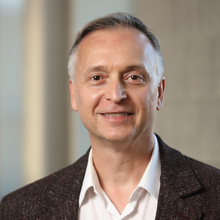
Hirosky Participates in "Science Straight Up" Public Outreach
From UVa Today:
"Have you ever wondered what, exactly, a Higgs boson is? Or what a future quantum computer might be able to do? Or if climate change is real?
Then ask a scientist. Maybe with a drink in your hand.
You can Thursday evening at 7:30 at Black Market Moto Saloon in Charlottesville, when University of Virginia physicist Bob Hirosky will talk about the Higgs boson and why it's such big news these days. Best of all, you can ask Bob about it during an informal 20-minute-or-so Q&A period.
The event â free and open to anyone â is part of a new U.Va. program called Science Straight Up, a monthly "science café" designed to promote community conversations about timely scientific topics in a relaxed setting. You can't beat a saloon for that."
For more, see:
http://news.virginia.edu/content/science-two-way-street-new-program-brings-science-community
and
http://pages.shanti.virginia.edu/Science_Straight_Up/what-the-heck-is-a-higgs-boson-anyway/

Bloomfield's "Vistik" Highlighted in UVaToday
From UVaToday:
"If anything bothers University of Virginia physicist Lou Bloomfield, it's a wobbly table. So much so that he actually invented a material to eliminate the problem. The material, a type of silicone rubber that is both rigid and fluid â a "viscoelastic" solid â can be placed under a table leg where it conforms to the shape of the leg bottom and the floor surface, perfectly filling the gap.
It turns out, the material can do a lot more than that."
For the full story, see:
http://news.virginia.edu/content/uva-physicist-bloomfield-develops-new-silicone-rubber

Day PRC Paper Included as Editors' Selection
A PRC paper presenting the results of Prof. Donal Day's work with John Arrington (our recent colloquium speaker), Nadia Fomin (his former graduate student), and a few others on the EMC effect has been included as an Editors' Selection for the month of December.
According to the PRC:
"As a service to both our readers and authors, we list a small number of papers published in Physical Review C that the editors and referees find of particular interest, importance, or clarity. These Editors' Suggestion papers are marked with a special icon that contains the printer's mark that appeared on the covers of all sections of the Physical Review until about a decade ago."
A link to the paper:
http://link.aps.org/abstract/PRC/v86/e065204

Cates Highlighted for Diquark Work
From DOE Pulse:
... researchers have found intriguing new evidence on how the different kinds of quarks behave inside protons and neutrons. The data and insights, which were published in the journal Physical Review Letters, have recently received further support and scrutiny from theory.
Gordon Cates, a physics professor at the University of Virginia, is a coauthor on the paper. ...
"The original diquark that was conceived by people was really a point-like object, of two point-like quarks sitting right next to each other, almost indistinguishable. And that's probably not what's going on. The diquarks that are being suggested here are a little on the fuzzy side, not quite the point-like things that were imagined years ago," Cates explains. "There are at least two serious calculations that very clearly suggest the diquark is real. So we see these behaviors, and they're unexpected. And they do seem to have some very interesting implications."
For more, see the DOE Pulse article:
http://www.ornl.gov/info/news/pulse/no376/feature.shtml
and the referenced Physical Review Letter:
http://prl.aps.org/pdf/PRL/v106/i25/e252003
UVa Physics Majors: Funding Available for Summer Research!
The UVa Physics Department is pleased to announce the availability of a number of Mitchell and other Summer Research Scholarships to support declared undergraduate physics majors to do research with a Physics Department faculty member next summer (2013). All who will be rising third or fourth year UVa physics majors at that time are eligible to apply.
For details, see:
http://www.phys.virginia.edu/Announcements/Mitchell/
Bloomfield Invents "Molecular Velcro"
From NewsPlex.com:
Dr. Louis Bloomfield, a professor of physics at UVa, describes the material as being the "molecular equivalent of Velcro." The material bounces like a ball, stretches like silly putty, and sticks like glue but it's hard to describe exactly what it is.
"What I call it technically is, viscoelastic silicone rubber. It needs a good name. Alas, the great name "flubber" is already taken, but it's kind of a crazy material like flubber," Bloomfield said.
For more, see:
http://www.newsplex.com/news/headlines/UVa-Professor-Invents-a-New-Packaging-Adhesive--181070841.html
Day Elected Fellow of the American Physical Society
In recognition by his peers of his outstanding contributions to physics, Professor Donal Day has been elected a Fellow of the American Physical Society. His Fellowship Certificate will read:
"For his studies of high momentum transfer quasielastic electron scattering, scaling relations and the short-range structure of nuclei and for his contributions to the use of polarized targets in the study of nucleon form factors and spin structure functions."
His name and citation will be published in the March 2013 issue of APS News and will appear on the Fellowship Page of the APS Home Page, http://www.aps.org.

Liuti Elected Vice Chair of SESAPS
From the Southeastern Section of the American Physical Society:
"In the 2012 election, Professor Simonetta Liuti of the University of Virginia was elected Vice Chair. She will serve in the Chair line for the next four years."
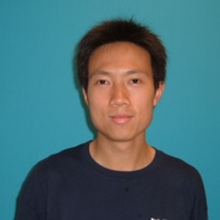
Zukai Wang Wins URA Visiting Scholars Program Award
The URA Visiting Scholars Program at Fermilab has awarded Zukai Wang $20,452 to work on the âSearch for Magnetic Monopoles in the NOvA Far Detectorâ
For more information on the program, see:
http://www.fnal.gov/pub/forphysicists/fellowships/ura_visiting_scholars/
For more on UVa's NOvA effort, see:
http://galileo.phys.virginia.edu/research/groups/hep/aag/uva_aag_group.html#nova

Second Virginia and Maryland String and Particle Theory Meeting
On Saturday, October 6, 2012, Diana Vaman and UVa's Physics Department will again play host to the Virginia and Maryland String and Particle Theory Meeting.
The invited speakers are:
Shinsei Ryu (U. Illinois, Urbana)
Misha Stephanov (U. Illinois, Chicago)
Rob Leigh (U. Illinois, Urbana)
Herman Verlinde (Princeton U.)
Tristan Hubsch (Howard University)
For more see:
http://physics1.howard.edu/%7Evadcmd/121006.html

Bloomfield Explains Physics of Heroic Catch
From MSNBC:
"The girl fell about 25 feet, which took about 1.25 seconds. The man stopped her fall in about 3 or 4 feet, which took about 0.1 second, depending on the stopping distance and how he supported her. So, she accumulated downward momentum over about 1.25 seconds and gave that momentum to the man (and ground) in about 0.1 seconds," Bloomfield told Life's Little Mysteries.
For Bernard to bring the girl's body to a stop in one-twelfth of the time she spent accelerating toward him â that's 0.1 seconds of stopping time, compared to 1.25 seconds of falling time â he had to exert an upward force 12 times greater than her (downward) weight. (Pushing upward is how you slow a falling body to a stop.) That means, "If she weighs 50 pounds, the man and ground must push up with an average of 12 times that force, or 600 pounds."
For more, see:
http://www.msnbc.msn.com/id/48217787/ns/technology_and_science-science/#.UAb0LKNdAtU
http://www.livescience.com/21667-bus-driver-catches-falling-girl.html

UVa's Higgs Effort Highlighted in Press
From UVa Today:
"We've had an observation that very likely is the Higgs," said University of Virginia physicist Brad Cox in the College of Arts & Sciences, who has been involved with the Higgs search at the Large Hadron Collider. "With more experimentation and analysis, we are within reach, possibly by the end of the year, of confirming that the particle that we have seen is the Higgs. If so, this will be one of the major findings in physics in half a century."
Full Story:
http://www.virginia.edu/uvatoday/newsRelease.php?id=19003
__________________
From The Daily Progress:
"... Brad Cox, a physics professor at the University of Virginia and member of one of two independent teams that presented evidence of the discovery, gathered with colleagues on Grounds at 3 a.m. to celebrate."
Jesse W. Beams Published in July 2012 Scientific American
An excerpt of an article by Ernest O. Lawrence and J. W. Beams in the July 2012 issue of Scientific American:
"Light is one of the most familiar physical realities. All of us are acquainted with a large number of its properties, while some of us who are physicists know a great many more marvelous characteristics which it displays. The sum total of our knowledge of the physical effects produced by light is very considerable, and yet we have no satisfactory conception of what it is."
For more, see:
http://goo.gl/eIuEU
Mitchell Summer Research Scholarships Awarded!
Three of our physics majors have been awarded Mitchell Scholarships to do
research with physics faculty this summer. Peter Breiding has been awarded
$5,000 to work with Professor Gallagher designing and building a new tunable
laser, Davis van Petten has $5,000 to work with Professor Baessler on
precision detection of neutron decay, and Anthony Charles has $1,250 for a
three-week project with Professor Vaman on string theory.
These Undergraduate Research Scholarships, awarded annually, are funded by a
generous bequest from the estate of our former colleague, Professor John
Mitchell.
For more, see:
http://www.phys.virginia.edu/Announcements/Mitchell/
Loomis and Popovic Win Presidential Research Poster Competition
From UVaToday:
"University of Virginia student researchers offered unique perspectives on the physical, legal and political worlds Friday as they presented their findings in the second annual Presidential Research Poster Competition at the Rotunda. ... The competition was divided into six categories, which were again subdivided among undergraduate, graduate and postdoctoral fellows. Teams of judges roamed the room, talking to presenters and assessing their projects. University President Teresa A. Sullivan handed out ribbons to the winners in each category.
Physical and Environmental Sciences
o Undergraduate student: Ryan A. Loomis, 'Broadband Reaction Screening for Interstellar Chemistry'
Translational and Applied Research
o Graduate student: Kosta Popovic, 'Development of an Integrated Multimodal Imaging System for Surgical Guidance'"
Full story: http://www.virginia.edu/uvatoday/newsRelease.php?id=18370
UVa Credited with Originating National Physics Day
From physicscentral:
"Physics fans, rejoice! April 24th is National Physics Day, and physics enthusiasts across the country are celebrating with fun physics demonstrations, public lectures, and other science events.
But National Physics Day isn't new; revelers have celebrated physics on or around April 24th for the past 18 years, starting in 1995 at the University of Virginia.
...
Imploding drums, demos on beds of nails, and exploding balloons have been a hit at the University of Virginia's celebrations in past years, said Steve Thornton, a University of Virginia physicist who organized the first National Physics Day."
> For more, see: http://physicsbuzz.physicscentral.com/2012/04/its-national-physics-day.html
> Link to our poster: http://www.phys.virginia.edu/Announcements/PhysicsDay/npd2012.pdf
Tenth Physics Department Research Poster Competition Winners
During the week of April 2 through April 6, 2012, the Physics department held a poster competition to highlight graduate student research. The competition was open to all students who had entered their third year in the graduate program and beyond.
1st prize winner:
Jooseop Lee for his poster on "Magnetic excitations in Fe-based superconductor"
2nd prize winner:
Anthony Palladino for his poster on "The PEN Experiment: Testing Lepton Universality"
3rd prize winner:
Hyunwook Park for his poster on "Long-range Rydberg-Rydberg molecules bound by the dipole-dipole interaction"
4th prize winner:
Sachith Dissanayake for his poster on "Neutron Scattering Studies on Quantum Magnets"
Honorable mention:
Mandy Gu for her poster on "Metal-Insulator Transition in CaVO3 Ultrathin Films"
For more, see:
http://www.phys.virginia.edu/Research/GraduatePosters/
Jefferson Lab Searches for Heavy Photons Highlighted in Nature
From Nature News in Focus
"In a three-week experiment due to start on 24 April, the electrons will crash into a thin tungsten target at 500 million times a second, creating a cascade of short-lived particles. Amid the debris, physicists with the Heavy Photon Search (HPS) are hoping that they will find signs of something exceedingly rare: a 'heavy' or 'dark' photon."
The article goes on to say:
"After the HPS's three-week test run, the beam will be shut down for an upgrade that will double its energy. This will allow the HPS and another project, the A Prime EXperiment (APEX), to explore other parts of the dark sector in 2015."
(Nilanga Liyanage and Blaine Norum are members of the APEX collaboration.)
Nature News in Focus article:
http://www.nature.com/news/physicists-hunt-for-dark-forces-1.10386
For more, see the Jefferson Lab APEX Proposal Presentation:
http://hallaweb.jlab.org/experiment/APEX/documents/RouvenEssig_12_16_09.pdf
National Physics Day
In celebration of National Physics Day, the 18th annual University of Virginia physics demonstration show will be held at 7 p.m. on Wednesday evening, April 25, 2012, in room 203 of the Physics Building, 382 McCormick Road. This highly anticipated event is a special family oriented physics demonstration show for the general public. Parking is available in the parking garage on Emmet Street, or after 5:00 p.m. in the football stadium lots.
Physics professors Bob Hirosky, Nilanga Liyanage, Stefan Baessler, and Bellave Shivaram will delight the crowd with strange and mystifying phenomena. Discover some peculiar properties of sound waves and learn about how electricity powers our homes, but be sure to keep an eye out for falling objects! As usual there will be plenty of surprises in store, and lots to learn about how our amazing universe works. These demonstrations will intrigue and excite both young and old, from novice to expert. Bring your family and friends, but come on time. For more information about this free public event, call 924-3781.
Contact: Helen McLaughlin at 924-3781 or email at [email protected]
Tenth Physics Department Research Poster Competition
During the week of April 2 through April 6, 2012, the Physics department will hold a poster competition to highlight graduate student research. The competition will be open to all students who have entered their third year in the graduate program and beyond. Senior students are particularly encouraged to participate by placing their posters in the main hallway, showcasing their works. The intent of the competition is twofold:
1) Increase awareness within the department of the variety of research topics currently under investigation by students,
and
2) Recognize student excellence in research and presentation.
For more, see:
http://www.phys.virginia.edu/Research/GraduatePosters/Spring2012.pdf

Virginia and Maryland String and Particle Theory Meeting
On Saturday, March 31, 2012, Diana Vaman and UVa's Physics Department will play host to the Virginia and Maryland String and Particle Theory Meeting.
For more see:
http://www.phys.virginia.edu/Announcements/Meetings/Particle2012/
UVa Researchers Featured in APS Synopses
From APS Synopsis: Getting Under the Neutron Skin
Heavy nuclei are believed to have a neutron-rich skin on the surface, and the thickness of this skin may have important implications for the physics of neutron stars.
Now the Lead Radius Experiment (PREx) Collaboration reports, in Physical Review Letters, electron scattering experiments that yield the thickness of the neutron skin in the heavy nucleus lead-208. Their preliminary results show that the skinâs thickness is about 0.33 millionths of a nanometer.
More:
http://physics.aps.org/synopsis-for/10.1103/PhysRevLett.108.112502

Cox Highlighted in Virginia Magazine
Brad Cox comments upon the LHC's search for the Higgs boson.
For more:
http://uvamagazine.org/university_digest/article/picking_up_the_subatomic_pieces

Bloomfield Makes Cents in Huffington Post
Prof. Bloomfield considers pennies from heaven (AKA the Empire State Building):
'If it did strike you, it would feel like being flicked in the forehead â "but not even very hard," said Louis Bloomfield, a physicist at the University of Virginia. And he should know. He recently used wind tunnels and helium balloons to replicate the fall of pennies from skyscrapers.'
For more, see:
http://www.huffingtonpost.com/2012/03/05/could-penny-kill-you_n_1321721.html

UVa team and collaborators measure ultra-fast protons in nuclei
The atomic nucleus is made of confined nucleons in constant motion dominated by their interactions with the mean field of the nucleus - that is the average potential generated the many body system. This mean field spawned motion is called the Fermi motion and is a function of the atomic number.
It is known for a long time that this picture of lumbering nucleons in a mean field is incomplete. The strong repulsive feature of the nucleon-nucleon (NN) interaction at short distances prevents nucleons from becoming close to each other and these short-range interactions generate highly energetic nucleons. A new Jefferson Lab experiment has quantified the effect and found that fully 25% of the protons in heavy nuclei move at velocities exceeding one quarter the speed of light!
This work is the product of the thesis experiment of former UVa graduate student Nadia Fomin who was advised by UVa Research Professor Donal Day. More can be read at
http://people.virginia.edu/~dbd/Annoucement/UltraFastNucleons.pdf
2012 Institute of Nuclear and Particle Physics Annual Lecture
The 2012 Institute of Nuclear and Particle Physics Annual Lecture, which will be held in the Physics Department, Room 203, on Thursday, March 15, at 3:30 p.m.
The lecture will be delivered by Professor William Marciano, a prominent theoretical physicist at the U.S. Department of Energyâs Brookhaven National Laboratory.
For more, see:
http://www.phys.virginia.edu/Announcements/INPP/2012.pdf

Dukes' NOvA Work Highlighted in A&S Magazine
From the Fall 2011 Arts and Sciences Magazine, "Toward a New College":
"Without this asymmetry, without this slight abundance of matter over antimatter, there would be nothing," says Craig Dukes
For more, see:
http://publications.artsandsciences.virginia.edu/issue/48938/33

UVa CMS Team Highlighted for Higgs Search
From The Daily Progress:
A team of scientists that includes a group from the University of Virginia may have seen a glimpse of a subatomic particle that, in theory, is the key to holding together everything from atoms to airplanes.
Scientific teams experimenting during the past two years at the Large Hadron Collider in Europe are reviewing data that could indicate the existence of the Higgs particle, a theoretical unit nicknamed âthe God particleâ that is believed to give mass to other subatomic particles.
More: http://www2.dailyprogress.com/news/2011/dec/13/scientists-including-uva-team-edge-closer-god-part-ar-1541986/
___________________________
From UVaToday:
"This is a very exciting time for those of us working at the LHC," said Brad Cox, a professor of physics in the University of Virginia's College of Arts & Sciences and principal investigator for U.Va.'s Compact Muon Solenoid Detector experiment at the Large Hadron Collider. "We are perhaps seeing the first evidence for the Higgs particle. However, we do not want to get ahead of ourselves. Statistically, what we are seeing could be a fluctuation of backgrounds, meaning there is still considerable uncertainty if what is observed is really the Higgs particle. However, what we see so far is exciting. By this time next year we should have conclusive evidence, pro or con, about the structure that we are seeing."
More: http://www.virginia.edu/uvatoday/newsRelease.php?id=16845&tr=y&auid=10006795
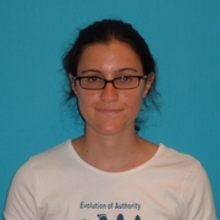
Yohay Wins US LHC Users Organization Award
Per Sridhara Dasu for the US LHC Users Organization Executive Committee:
The Young Scientist talks at the USLUO, especially the lightning round, was a grand success. Everyone liked the talks, and our NSF representative sent a special congratulatory message to the students and postdocs who presented at the USLUO Meeting.
The winners of the competition, chosen by the ranking determined by polling senior scientists attending the meeting are:
Sarah Heim (Michigan State),
Laura Jeanty (Harvard),
Jeff Klukas (Wisconsin),
Chad Suhr (NIU)
Rachel Yohay (Virginia)
These winners are invited to join the USLUO delegation that visits Washington in Spring 2012. The award covers their travel expenses.
We also wish to acknowledge the very high quality of talks especially from somewhat more experienced postdocs:
Bryan Dahmes (Minnesota), Sal Rappochio (Johns Hopkins), Wei Lei (MIT).
UVa to Dedicate New Physical and Life Sciences Research Building
From UVaToday:
October 17, 2011 â The College and Graduate School of Arts & Sciences at the University of Virginia will dedicate its new, state-of-the-art Physical and Life Sciences Research Building on Friday at 3 p.m.
The five-story, 100,000-square-foot building offers modern research laboratory space for more than two dozen faculty members and their research groups, and will house members of the biology, chemistry and physics departments. The building is also home to scientific equipment and facilities shared by research teams in the College and other parts of the University.
For more, see
http://www.virginia.edu/uvatoday/newsRelease.php?id=16362

Pocanic and Baessler Receive NSF MRI Funding
Dinko Pocanic and Stefan Baessler, in collaboration with colleagues from Arizona State University and Oak Ridge National Lab, have received funding for the development of a spectrometer optimized for precise measurements of correlations in neutron beta decay. The recently approved National Science Foundation Major Research Instrumentation grant totals approximately $2.5M, of which $2.3M will go to UVa. Furthermore, the Department of Energy will provide an additional $2M to fund the balance of the equipment required to complete "Nab," the first experiment in the planned series of measurements. The spectrometer will be installed at the world's most powerful pulsed neutron source, the Spallation Neutron Source at the Oak Ridge National Lab in Tennessee.
The spectrometer was designed by the Nab collaboration, at present a group of 27 scientists from 13 institutions, with design leadership provided by the UVa group. The goal of the collaboration is to measure the correlation between the neutrino and electron directions in the beta decay of the free neutron. This measurement will provide important input for the theory of the weak interaction. For example, the result will be used to search for hitherto unseen, hypothetical elementary particles that would cause the so-called scalar and tensor interactions. The spectrometer will be subsequently modified for use in follow-on measurements of spin correlations in neutron beta decay. Training of graduate and undergraduate students, as well as postdoctoral fellows, is one of the major goals of this collaborative research effort.
More information can be found at http://nab.phys.virginia.edu

Pfister Highlighted in Quantum Computing News
From Network World:
"My work with optical fields has demonstrated good preliminary control over 60 qubit equivalents, which we call 'Qmodes' and has the potential to scale to thousands of Qmodes," Pfister says. "Each Qmode is a distinctly specified color of the electromagnetic field, but to develop a quantum computer, nearly hundreds to thousands of Qmodes are required."
For more, see:
http://www.networkworld.com/news/2011/092611-quantum-computing-250825.html

Louca, et al., Awarded NSF MIRT
Despina Louca, with her colleagues at UT Austin, received one of the three MIRT awards made by the National Science Foundation this year among high competition.
The Materials Interdisciplinary Research Team (MIRT) grant, which was awarded for the first time this year and is managed by the Materials Research Science and Engineering Center program at NSF, recognizes teams that demonstrate a strong interdisciplinary research program.
Six university faculty members from The University of Texas at Austin â whose expertise include physics, mechanical engineering, chemical engineering, and electrical and computer engineering â will work collaboratively on the grant with University of Virginia Professor Despina Louca, in the department of Physics.
The nearly $3 million three-year grant from the NSF is to study materials that are vital to the development of a broad range of technologies, including everything from cell phones to large-scale energy storage.
Led by Professor Arumugam Manthiram, the research will team faculty and students from across disciplines. The goal of their research is to gain a profound fundamental understanding of the physics and chemistry involved in controlling the properties of transition-metal oxides, a complex class of materials essential for many modern technologies.
For more, see
http://www.engr.utexas.edu/news/7042-tminsfgrant

Pfister Accomplishes Breakthrough Toward Quantum Computing
From UVaToday:
Olivier Pfister, a professor of physics in the University of Virginia's College of Arts & Sciences, has just published findings in the journal Physical Review Letters demonstrating a breakthrough in the creation of massive numbers of entangled qubits, more precisely a multilevel variant thereof called Qmodes.
Entanglement dwells outside our day-to-day experience; imagine that two people, each tossing a coin on their own and keeping a record of the results, compared this data after a few coin tosses and found that they always had identical outcomes, even though each result, heads or tails, would still occur randomly from one toss to the next. Such correlations are now routinely observed between quantum systems in physics labs and form the operating core of a quantum computing processor.
Pfister and researchers in his lab used sophisticated lasers to engineer 15 groups of four entangled Qmodes each, for a total of 60 measurable Qmodes, the most ever created. They believe they may have created as many as 150 groups, or 600 Qmodes, but could measure only 60 with the techniques they used.
For the full story, see:
http://www.virginia.edu/uvatoday/newsRelease.php?id=15525
For more details, see the July 15, 2011, PRL article
http://physics.aps.org/synopsis-for/10.1103/PhysRevLett.107.030505
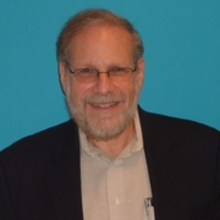
Wolf Instrumental in Creation of the Virginia Nanoelectronics Center
From UVaToday:
The University of Virginia, in partnership with the College of William & Mary and Old Dominion University, has launched the Virginia Nanoelectronics Center, or ViNC, to advance research aimed at developing next-generation electronics.
"This new center is positioning Virginia at the heart of the development of a new nanoscale technology," said Stuart Wolf, director of nanoSTAR and ViNC. "This center could establish the commonwealth as the 'Oxide Hills' rather than a new 'Silicon Valley.'"
for details, see:
http://www.virginia.edu/uvatoday/newsRelease.php?id=15140&tr=y&auid=8402587

Neu Awarded FEST Funding
Christopher Neu has been named a Distinguished Young Investigator this year through the University of Virginia's Fund for Excellence in Science and Technology. Sponsored by the Office of the Vice President for Research, the fund - now in its seventh year - provides seed money for promising innovative research.
For more see:
http://www.virginia.edu/uvatoday/newsRelease.php?id=15134&tr=y&auid=8393728
Ninth Physics Department Research Poster Competition
During the week of March 28 through April 1, 2011, the Physics department held a poster competition to highlight graduate student research. The competition was open to all students who had entered their third year in the graduate program and beyond.
Results: http://www.phys.virginia.edu/Research/GraduatePosters/spring2011/
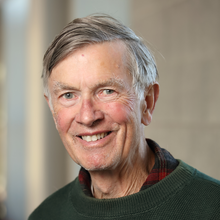
Gallagher receives 2010-11 Distinguished Scientist Award
Three pre-eminent researchers â Thomas F. Gallagher, Patrice G. Guyenet and Kodi S. Ravichandran â have been chosen to receive 2010-11 Distinguished Scientist Awards from the University of Virginia.
This award from the Office of the Vice President for Research (VPR) was founded in 2006, and recognizes faculty from the basic, medical, or engineering sciences who have distinguished UVa through a significant body of research conducted here, as judged by publications, awards and peer reviews, and have made a major impact upon a field of study, both nationally and internationally. The award consists of a $10,000 contribution to the recipientâs laboratory for enhancement of its research activities.
For details, see:
http://www.virginia.edu/vpr/dsa.html
and
http://www.virginia.edu/uvatoday/newsRelease.php?id=14819

Rachel Yohay has been awarded the ARCS Fellowship
The Metro Washington Chapter of ARCS selected Rachel Yohay as a fellowship recipient for the 2011-2012 academic year. ARCS stands for Achievement Rewards for College Scientists and only 1 nomination was allowed out of UVa for the $15,000 scholarship. The focus of this fellowship is on the doctoral student's research that "could feasibly serve as a breakthrough technology or discovery... of advancing our country's global technological competitiveness." The chapter liaison to the Universities, Karen Meyers, wrote "we were all in awe of the outstanding choice you made to present to us. Rachel Yohay is exactly the kind of student ARCS is looking for - dynamic, a leader and certainly brilliant. Her current position in Switzerland , as described by her professors, is commendable. We are so pleased to welcome her as a 2011-2012 ARCS Scholar. "
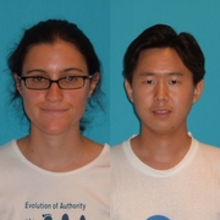
Wu and Yohay Honored
Chaolun Wu has been awarded a dissertation year fellowship
and Rachel Yohay has been selected from UVa this year to be nominated
for the ARCS Foundation. ARCS stands for Achievement Rewards for College
Scientists and only 1 nomination is allowed out of UVa for the $15,000
scholarship for 2011-12. The focus of this fellowship is on the doctoral
student's research that âcould feasibly serve as a breakthrough
technology or discovery⦠of advancing our countryâs global technological
competitiveness.â
Ninth Physics Department Research Poster Competition
During the week of March 28 through April 1, 2011, the Physics department will hold a poster competition to highlight graduate student research. The competition will be open to all students who have entered their third year in the graduate program and beyond. Senior students are particularly encouraged to participate by placing their posters in the main hallway, showcasing their works.
The intent of the competition is twofold:
1) Increase awareness within the department of the variety of research topics currently under investigation by students, and
2) Recognize student excellence in research and presentation.
Any student who has started a program of research should feel free to enter. We strongly encourage all eligible students to take the time to prepare a poster. Please notify Dawn in the main office by March 23 if you decide to enter the competition by providing a title and author list. This will give us an accurate count on the number of boards we would need.
Prizes:
Participating students will place their posters in the main hallway of the physics building sometime between Monday, March 28 and Tuesday, March 29. The posters will be reviewed by members of the graduate program committee between Wednesday, March 30 and Thursday, March 31. Based on the poster review, the committee will award four students with the following prizes:
1st place: $1,500
2nd place: $1,000
3rd place: $ 750
4th place: $ 500
Details:
http://www.phys.virginia.edu/Research/GraduatePosters/Spring2011.pdf

Bloomfield wins Jefferson Scholars Faculty Prize
From UVaToday:
The Jefferson Scholars Foundation at the University of Virginia has awarded Louis A. Bloomfield its 2011 Faculty Prize. Bloomfield, a physics professor in the College of Arts & Sciences, has been a member of the faculty since 1985.
"Professor Bloomfield's passion and commitment to his students have made him a powerful force at the University. His long list of accomplishments is unusually impressive, and he is a most worthy recipient of the Faculty Prize," Jimmy Wright, president of the Jefferson Scholars Foundation, said.
UVaToday Story:
http://www.virginia.edu/uvatoday/newsRelease.php?id=13933
Jefferson Scholars Foundation Notice:
http://www.jeffersonscholars.org/2011/01/jefferson-scholars-foundation-awards-faculty-prize-to-louis-a-bloomfield/
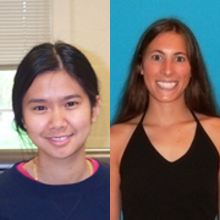
Congratulations to Kelsie Betsch and Jirakan Nunkaew
Congratulations to Kelsie Betsch and Jirakan Nunkaew on receiving an Award for Excellence in Scholarship in the Sciences and Engineering!
This award recognizes excellence in original scholarship by PhD students at the University and rewards those students that bring recognition to graduate programs at UVA through their intellect, dedication, creativity and passion.
Elizabeth Orser
Assistant to the Chair
University of Virginia
Department of Physics
382 McCormick Road
PO Box 400714
Charlottesville, VA 22904-4714
(Ph) 434-924-6791
(Fax) 434-924-4576

Poon Group's Work on Thermoelectric Materials Recognized
Researchers in the US, including U.Va., have unveiled a new high-temperature material that is 60% better at converting heat to electricity than comparable "thermoelectrics". The material, which is a nanocomposite, could potentially be used to boost the fuel efficiency of cars by recovering energy from the vehicle's exhaust heat.
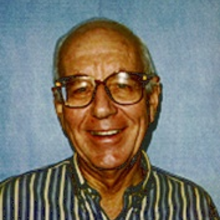
Memorial Resolution for Klaus Ziock
Memorial Resolution for Klaus O. H. Ziock, read to the Faculty of Arts and Sciences on December 9, 2010, by Prof. Ralph Minehart:
Klaus Otto Heinrich Ziock, an experimental physicist and Physics Professor Emeritus, died on November 5, 2010, from complications following abdominal surgery. He leaves his wife of 58 years, Ursula (Uschi) Ziock, four sons, Hans-Joachim, Klaus-Peter, Robert, Michael, and their families including two grandchildren and one great grandchild.
Klaus was born on February 4, 1925 in Herchen, Germany. Following service in the German army during World War II, he received a Dipl. Phys. in 1949 from the University of Bonn, Germany. From 1950 to 1954 he worked as a physicist in the Research and Development Department of E. Leybold's Nachfolger in Koeln, Germany. During this period he published several papers on vacuum technology and was awarded six patents for vacuum devices. He returned to the University of Bonn to earn his advanced degree under the direction of Wolfgang Paul, who won the 1989 Nobel Prize in Physics. He received the degree of Rerum Naturalium Doctor in 1956, and remained for two more years at Bonn as an Assistant in Physics. From 1958 to 1960 he was employed as a Research Associate at Yale University, working with Professor Vernon Hughes. He served on the Yale faculty as an Assistant Professor of Physics from 1960 to 1962. In 1962 he joined the University of Virginia as an Associate Professor, serving as the Acting Director of the newly formed Virginia Associated Research Center. He spent a year as a Visiting Scientist at CERN from 1969 to 1970. He was promoted to Professor of Physics in 1972. After receiving an American Senior Scientist Award from the Alexander von Humboldt Foundation of Germany in 1977, he spent a year at the Swiss Institute for Nuclear Science. He was a member of the American Physical Society.
His pre-doctoral work centered around the study of atomic spectra with his dissertation on the measurement of the oscillator strength of the 3,720 Angstrom iron resonance line. His association with Professor V. Hughes at Yale University culminated in the successful production of muonium and verification of its existence at the Columbia University Nevis Cyclotron. Muonium, which consists of a bound positive muon and an electron, has since played a major role in precision fundamental measurements in quantum electrodynamics. Continued studies of fundamental properties of muons and pions were an important thread in the remainder of his career. At the University of Virginia he played a seminal role in the creation of a highly successful Medium Energy Experimental Group in the Physics Department. At the Space Radiation Effects Laboratory he instituted a program to study nuclear properties with pion and muon capture. In 1970 this program was transferred to the Meson Physics Facility at Los Alamos, NM, where he carried out a long series of experiments until his retirement in 1995. His last work at Los Alamos was a major contribution to the apparatus for the MEGA experiment, a large-scale program to search for the decay of a muon to an electron and a gamma ray. This decay is forbidden by the so-called Standard Model, but predicted to occur with extremely low probability by some modern theoretical hypotheses. Following his sabbatical year at the Swiss Institute for Nuclear Science he continued an active program there through experiments on the properties of muons and pi mesons and their interaction with nuclei. He also conducted in his Charlottesville laboratory an extensive search for fractionally charged particles (quarks) predicted by the Standard Model using magnetic levitation of 30 microgram steel spheres.
Klaus was an excellent and devoted teacher in the classroom and the laboratory. He was the Ph.D. adviser for 15 graduate students. He wrote an undergraduate textbook, Basic Quantum Mechanics, published by John Wiley and Sons in 1969. The book was greatly enlivened by his amusing and instructive cartoons and by his unique brand of humor.
Klaus's devotion to rigorous experimental research was matched by his devotion to his close-knit family, who enjoyed a rich life together. Not only Klaus, but his entire family profited from his European sabbaticals and summers in New Mexico. The summers included extensive exploration of the geology and Native American life in the Southwest. His sons have all gone on to lead successful lives, with the elder two following in his footsteps as experimental physicists. After retirement from U.Va. he and Uschi moved into a house at the foot of Sandia Mountain in Albuquerque, NM, which provided an excellent base for continued exploration and enjoyment of the American Southwest. His love of travel was also gratified by frequent ocean cruises to the Caribbean and farther afield. As a friend and colleague, he was always honest, aboveboard, and willing to provide help whenever he could. His friends around the world will miss him.

Dukes' NOvA Work Highlighted in UVaToday
One of the great and fundamental questions in physics is: Why is there matter? Physicists theorize that in the instant after the Big Bang created the makings of the universe, there were nearly equal amounts of matter and anti-matter, protons and anti-protons, neutrons and anti-neutrons. They should have annihilated each other, resulting in ... nothing.
Instead, for some reason, more matter was created than anti-matter, and the universe was born.
"Without this asymmetry that occurred, without this slight abundance of matter over anti-matter, there would be nothing," said Craig Dukes, a physicist in the High Energy Physics Laboratory in the University of Virginia's College of Arts & Sciences. "The universe would be a boring place. There would be no stars, no planets, no people, no books. There would be no filet mignon."
Full Story:
http://www.virginia.edu/uvatoday/newsRelease.php?id=13656
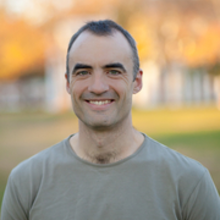
Lamacraft named a Cottrell Scholar
Dear Colleagues,
I have just received word that Austen Lamacraft has been named a Cottrell Scholar by the Research Corporation for Science Advancement. This is an honor for Austen and the announcement of the award was made to the UVa President's Office. Public recognition of this award will be announced in the journal Science.
Please join me to congratulate Austen.
Cheers,
Joe
HEP Group Seeks New Physics at the LHC
As reported in UVaToday:
"International teams of scientists working on an array of high-energy physics research projects with the Large Hadron Collider near Geneva â including several physicists from the University of Virginia's College of Arts & Sciences â are beginning a new set of experiments this month after having completed a seven-month mission colliding protons at the highest levels of energy ever accomplished."
For more, see:
http://www.virginia.edu/uvatoday/newsRelease.php?id=13519

Quark Momentum Distributions Beyond the Free Nucleon Limit
This paper, coauthored by Nadia Fomin, a former UVa graduate student (and now a research associate at the University of Tennessee), Donal Day (her advisor at UVa), John Arrington of Argonne National Lab and others, provides for the first time a direct connection between inclusive electron-nucleus data taken at Jefferson Lab's momentum transfers with data at momentum transfers 10 times higher. This connection is important because it allows an examination of the quark momentum distributions at momenta forbidden in the free nucleon. These data are snapshots of the behavior of quarks under certain extreme conditions possible only inside the nucleus - rare fluctuations in which nucleons overlap, generating very high densities and violent reactions. Theories that attempt to describe the dynamics by which a quark obtains such large momenta - be it parton recombination or the presence of pre-existing exotic 6 or 9-quark states, or some combination with conventional nuclear physics - will find a testing ground here.
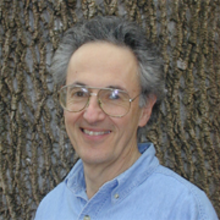
Fishbane Defends Einstein
Professor Emeritus Paul Fishbane was noted in UVa Today
http://www.virginia.edu/uvatoday/headlines.php
for Salon's noting
his recent article in Tablet

Lee Group Paper a J. Phys. Soc. Jpn TOP 20
The paper "Investigation of the Spin-Glass Regime between the Antiferromagnetic and Superconducting Phases in Fe1+ySexTe1-x" was one of the top twenty papers downloaded from the Journal of the Physical Society of Japan's website.
http://www.ipap.jp/jpsj/mostDL/most_downloaded.cgi?year=2010&month=10

Lee Highlighted in APS News
In the October 2010 APS News:
"To me, this challenges the integrity of science... They say they
reached these conclusions that have enormous consequences on the
political and international stage. As a scientist and scholar, I felt
it was my duty to check their conclusion."
Seung-Hun Lee, University of Virginia, on why he disagrees with the
South Korean government's assessment that a North Korean torpedo sank
the battleship Cheonan in March, Time, August 18, 2010.
Time Magazine Article:
http://www.time.com/time/world/article/0,8599,2011507,00.html
Smola Wins Presidential Award for Excellence in Mathematics and Science Teaching
Raymond Smola, a 2008 graduate of our Master of Arts in Physics Education
program, recently was one of the winners for the 2010 Presidential Award for
Excellence in Teaching Mathematics and Science. This is the highest award that
a K-12 teacher can receive. The awards are announced by the White House, and
the winners visit the White House to receive their awards. Please see the UVa
announcement at http://uvatoday.org/blog/?p=1831
Smola teaches at Heidelberg High School in Heidelberg, Germany for the DOD
school. He is a typical MAPE teacher. He has a BS in chemistry, but wanted to
teach physics as well, so he spent two summers with us in 2006 and 2007 in the
MAPE program.
For more information about the MAPE program at UVa, see:
http://galileo.phys.virginia.edu/outreach/ProfessionalDevelopment/mape/home.html

Breaking through to the other side
The highest temperature superconductivity has been found when a
small fraction of electrons was added or removed from Mott
insulators where strong electron-electron repulsion prevents
electrons from moving freely. To dissect a Mott insulator and
examine whether it contains the seed to superconductivity, it would
be helpful to study what happens when an extremely small number of
electrons are either added or removed in a single Mott insulating
material. Recently, an international team composed of Yoichi Ando's
group at Osaka University, Seung-Hun Lee's group at University of
Virginia, and Kazu Yamada's group at Tohoku University, has
discovered such a system. The ambipolar cuprate (YLBLCO) provides
continuous access to both electron- and hole-doped regimes in a
single material, simply by altering its oxygen composition. Their
results revealed a marked difference in properties of electron- and
hole-doped regimes. Understanding these differences may hold
important clues to the origin of superconductivity. Future work on
this remarkable material should help to reach the understanding. The
work has been published in Nature Physics, August 2010 [1], and was
featured by a News and Views article in Nature Physics [2].
[1] K. Segawa et al., Nature Physics 6, 579-583 (2010).
[2] J. Orenstein and A. Vishwanath, Nature Physics 6, 566-567 (2010).

Invitation - Deaver Retirement
Honoring 45 years of service in the UVA Physics Department . . .
A Retirement Symposium and Reception Celebration
for
Bascom Deaver
on
May 12, 2010 at 1:00pm
Room 204, Physics Bldg
Our colleague Bascom Deaver will be retiring this summer. In celebrating Bascom's 45 years of service to the Physics Department and University, as well as his scientific and technological contributions to superconductivity and devices, this symposium is being held in his honor.
Symposium Co-chairs: Joe Poon (Physics), Bobby Weikle (Electrical Engineering)
1:00pm - 1:05pm Brief introduction
1:05pm - 1:30pm Professor Allen Goldman, University of Minnesota
"The Impact of Flux Quantization on the Understanding of Superconductivity"
1:30pm - 1:55pm Dr. Bill Goodman, Applied Physics systems
"TBA"
1:55pm - 2:20pm Professor Stuart Wolf, University of Virginia
"Trends in Superconducting Electronics - From the Future to the Past"
2:20pm - 2:30pm Coffee Break
2:30pm - 2:55pm Dr. Tom Crowe, Virginia Diodes
"Schottky Diode Based Receivers and Sources for CRR and other Applications"
2:55pm - 3:20pm Dr. Al Wootten, National Radio Astronomy Observatory We are looking forward to having you join us to celebrate this special occasion.
"ALMA: The March to Early Science"
3:20pm - 3:55pm Professor Robert Mattauch, Professor of Electrical Engineering Emeritus
"Solid State Device Work between UVa's Engineering & Physics, The Early Days"
4:30pm - 7:00pm Reception at the Colonnade Club (Please RSVP to [email protected]
 Physics at Virginia
Physics at Virginia
